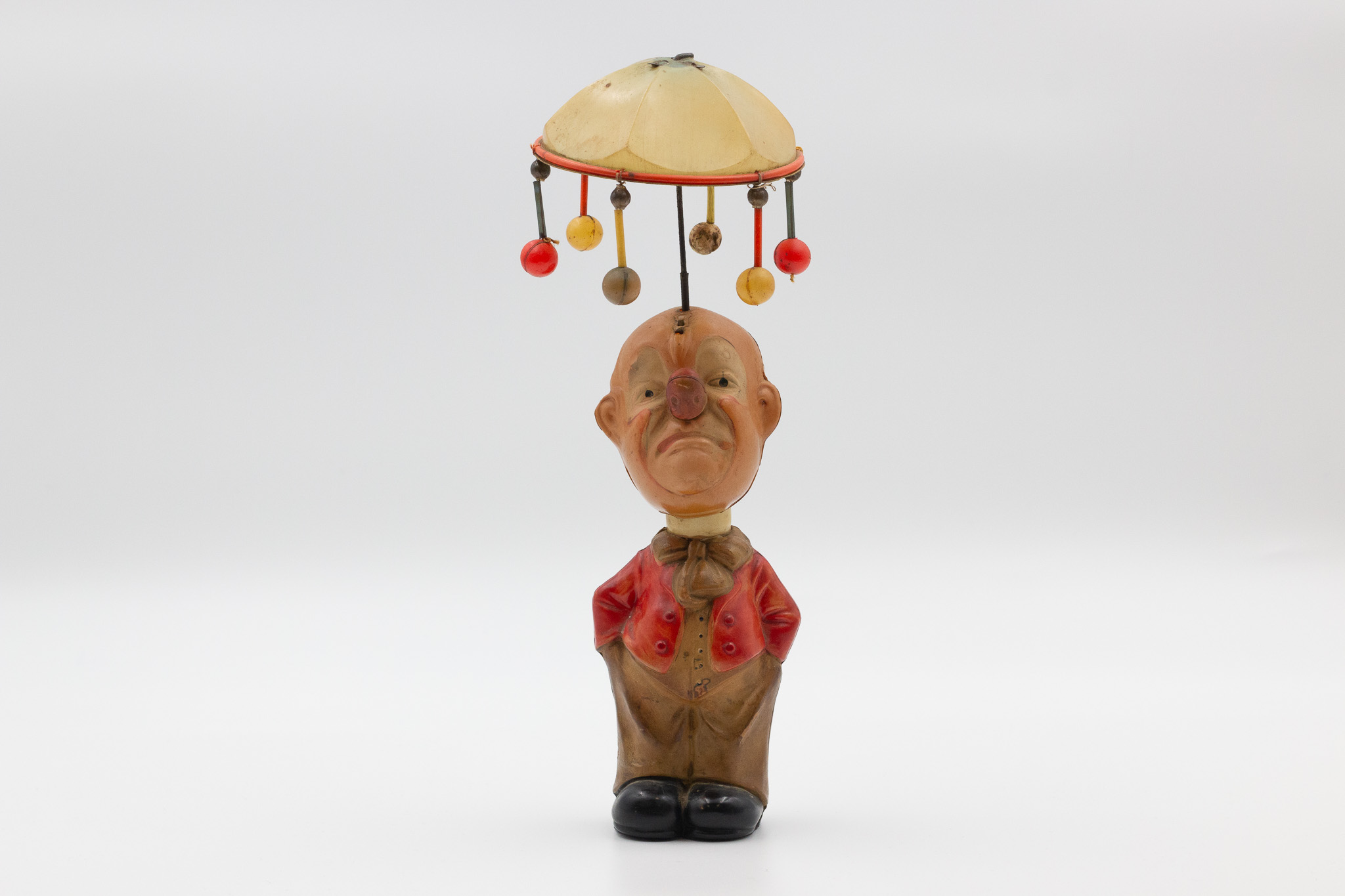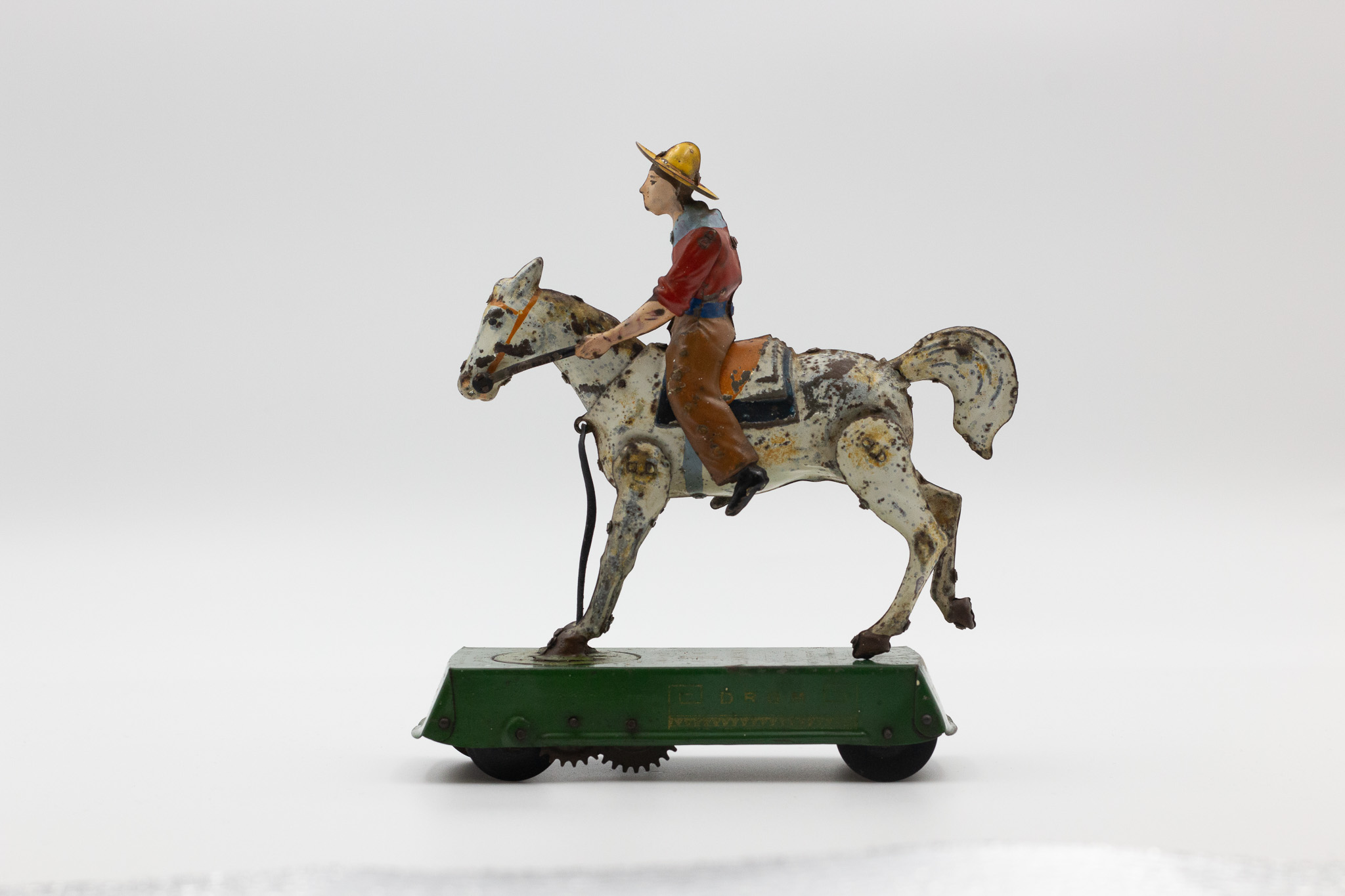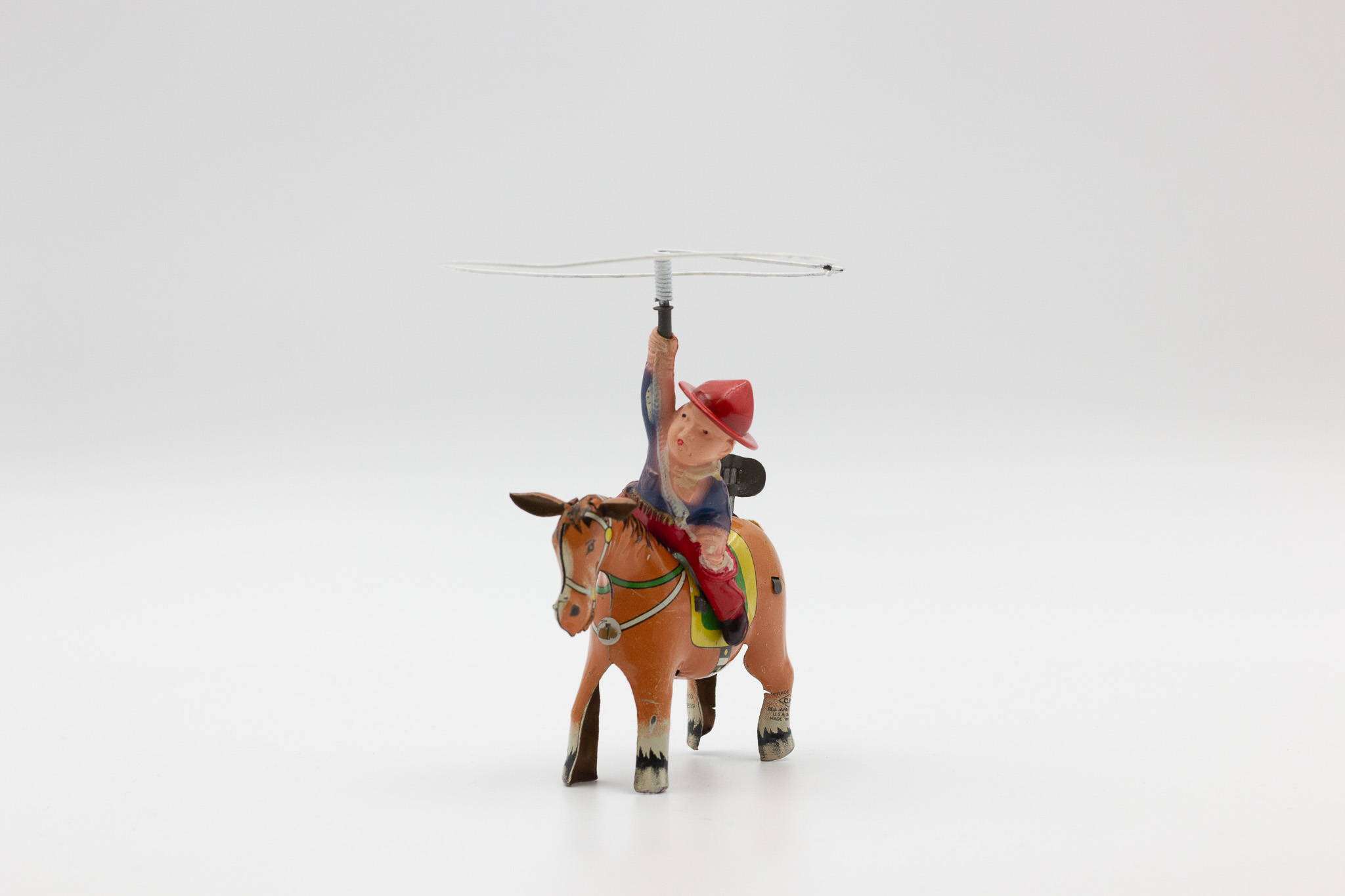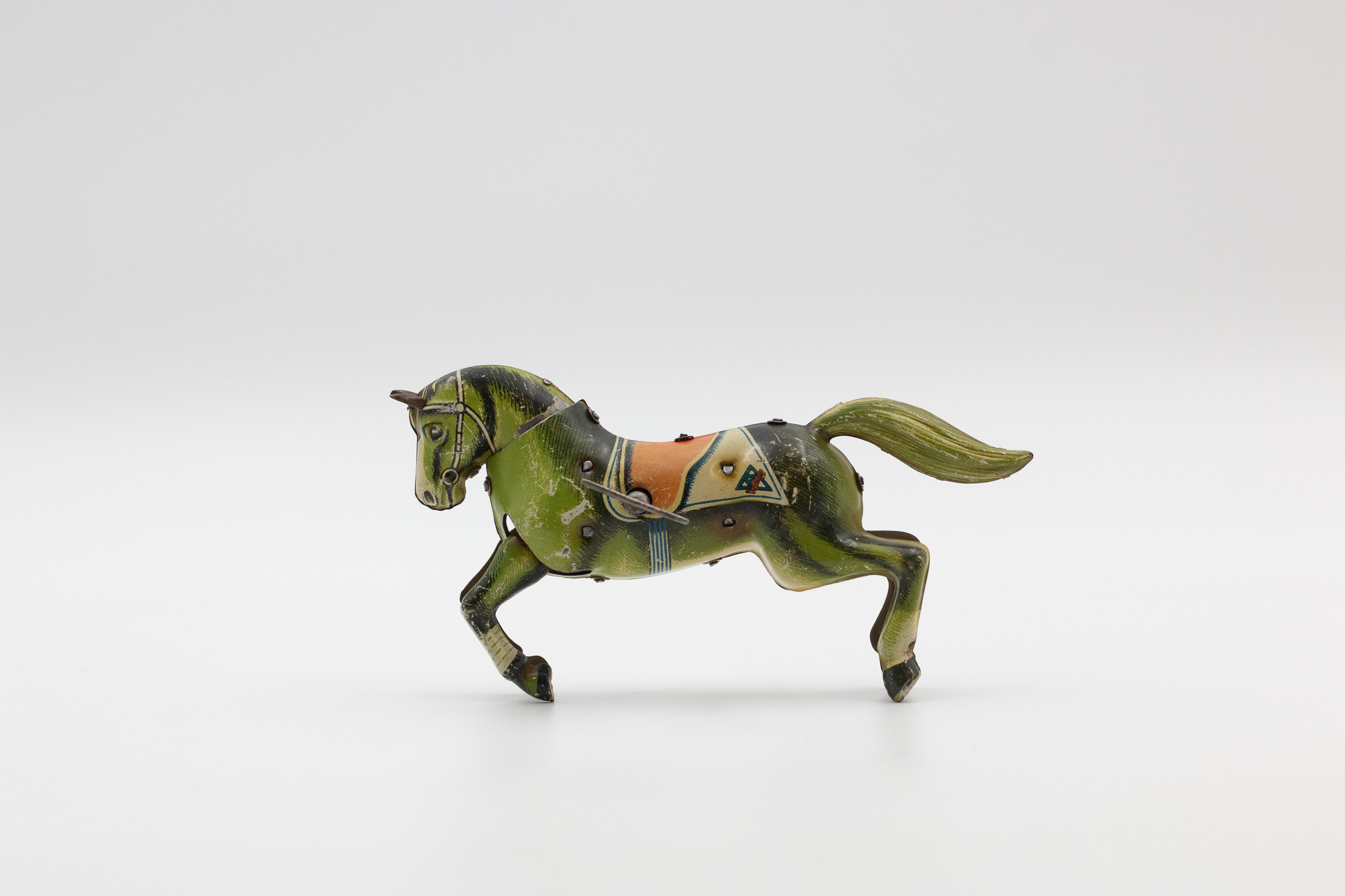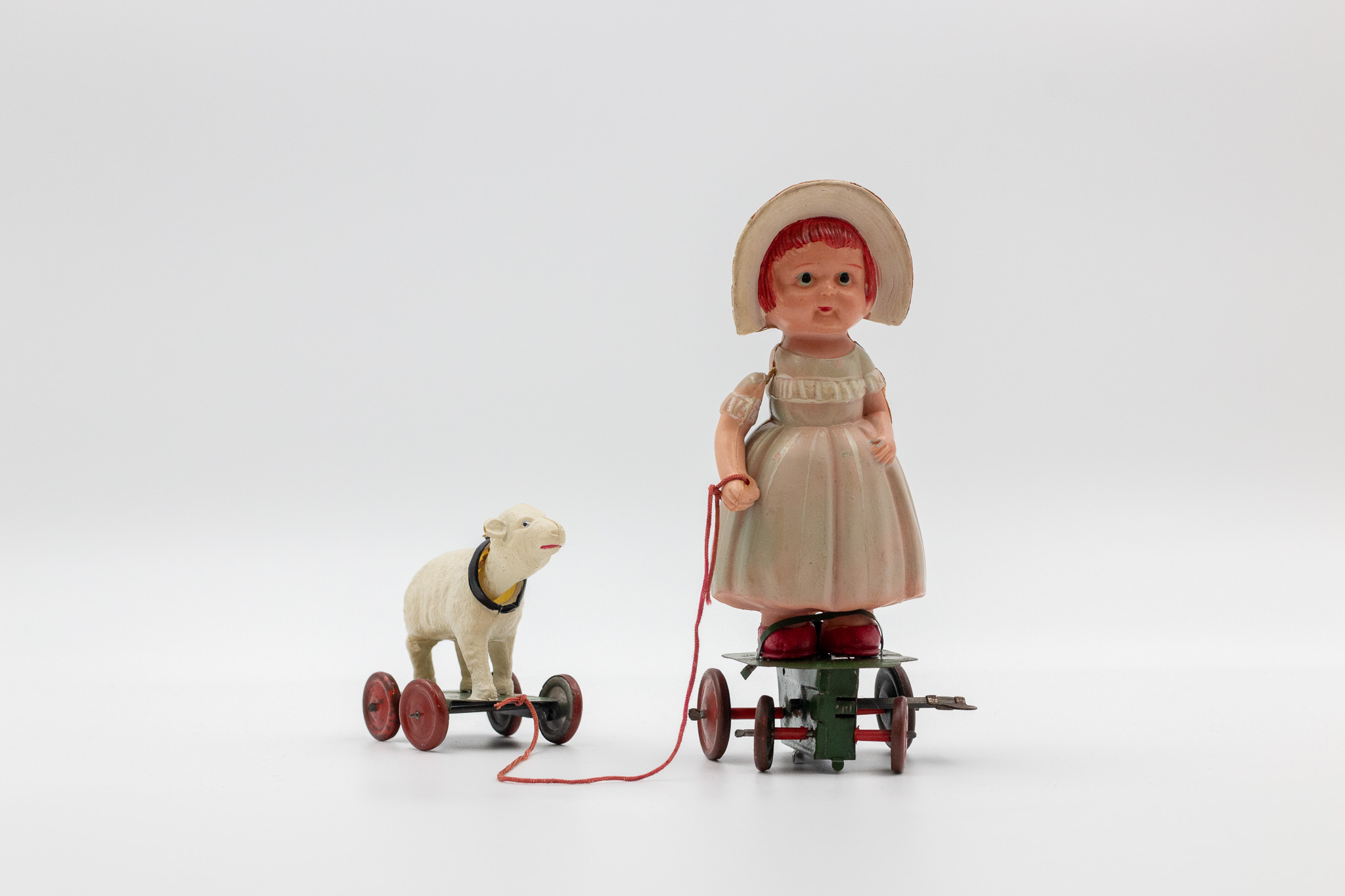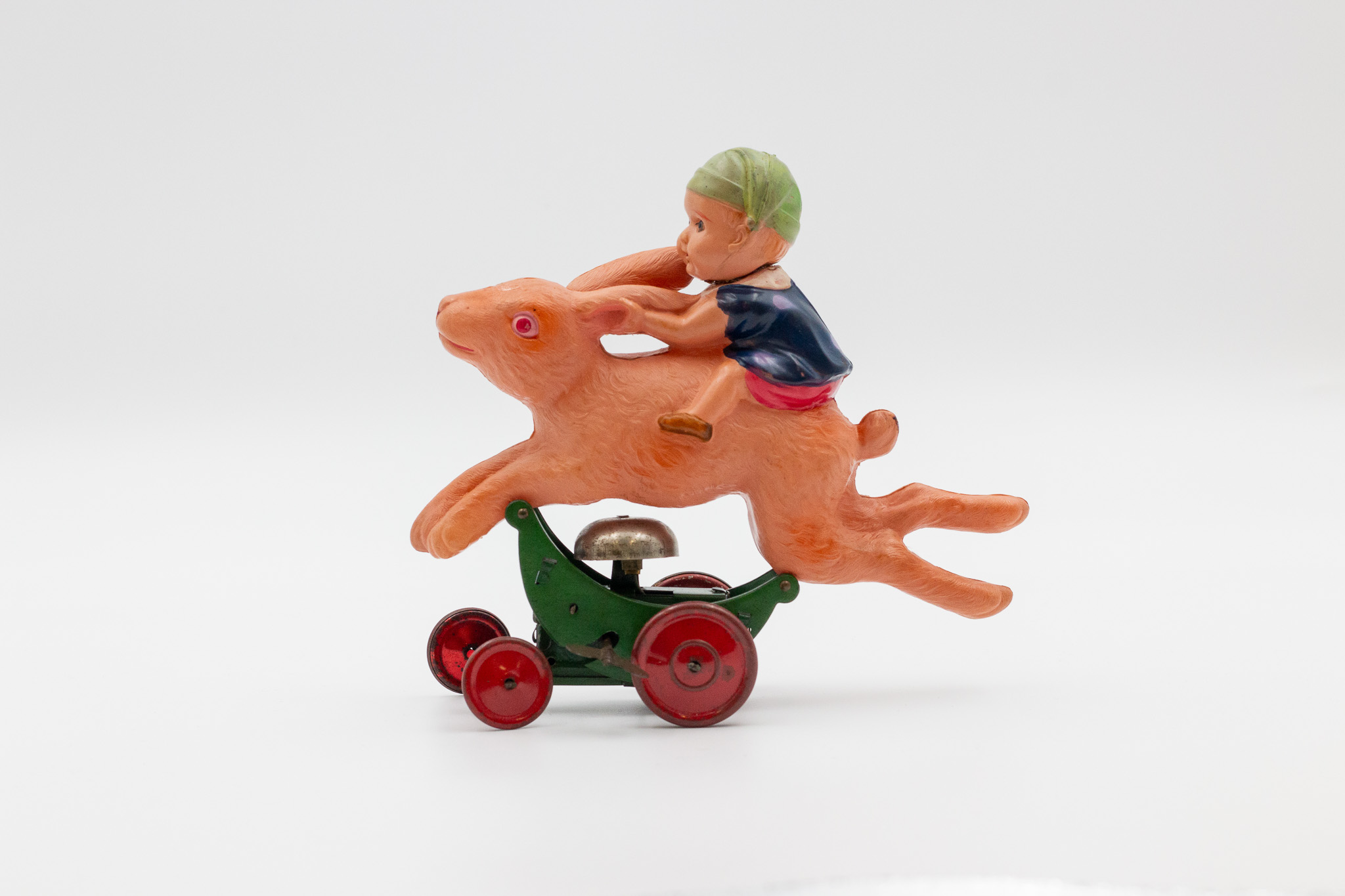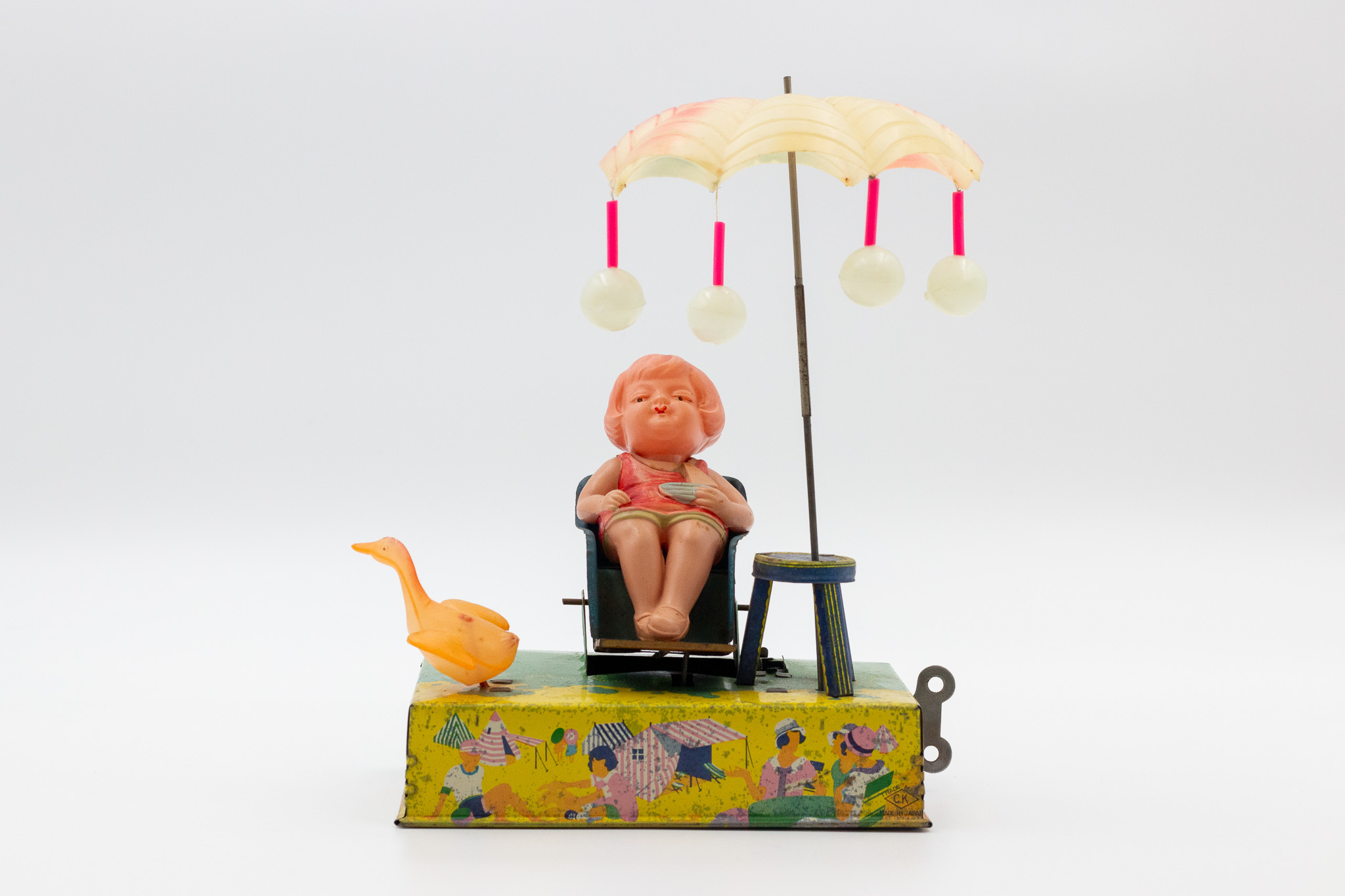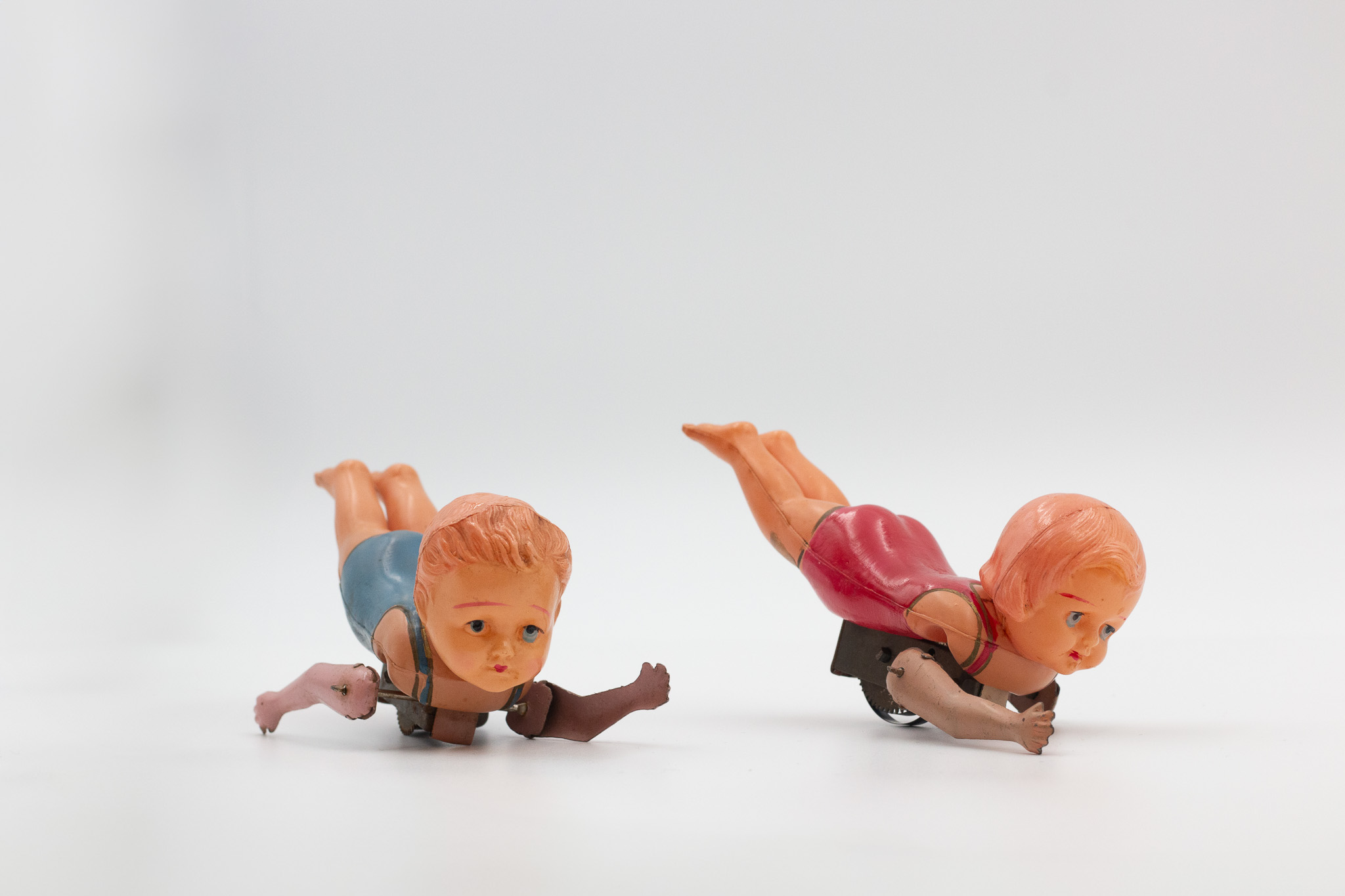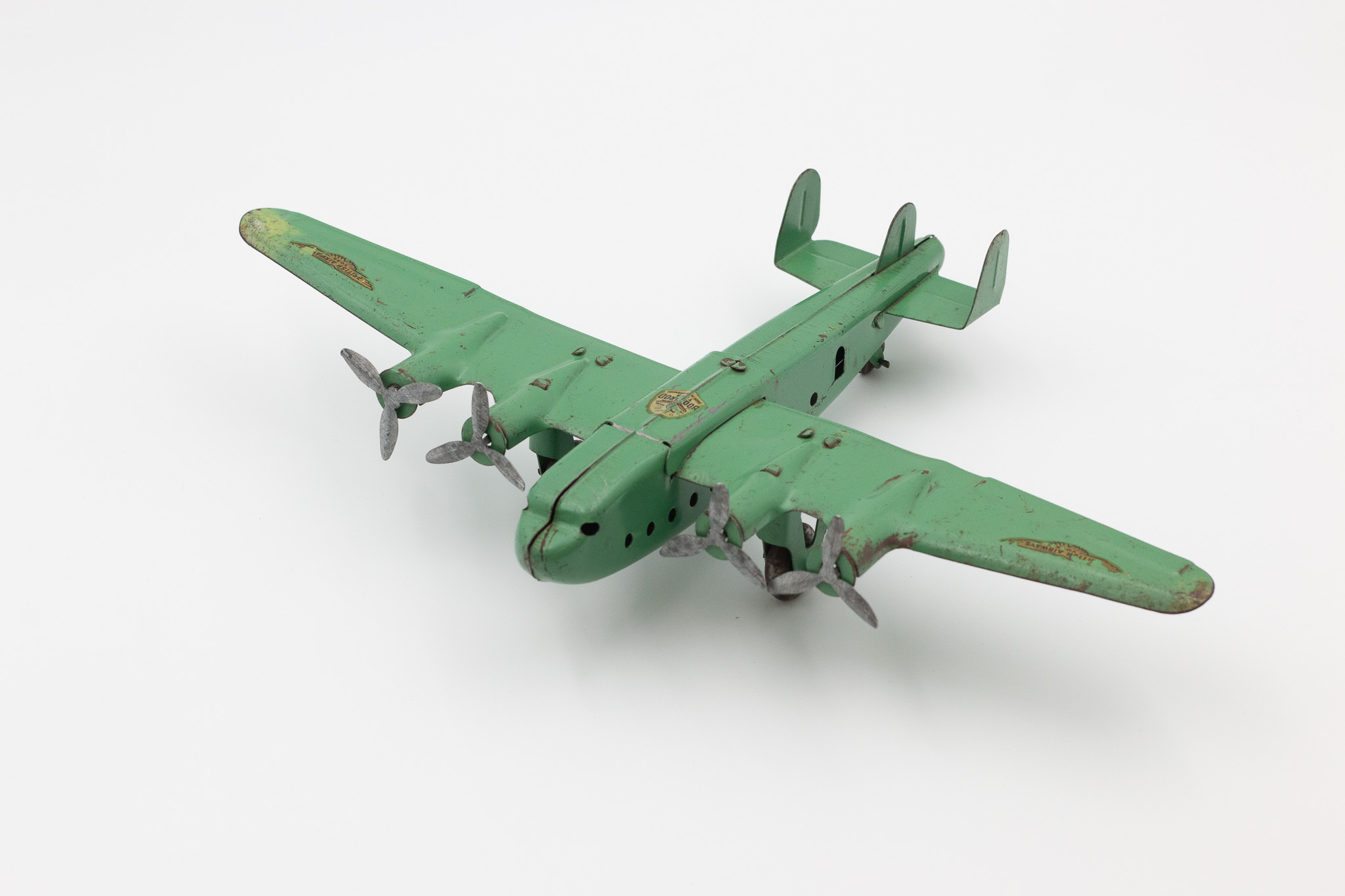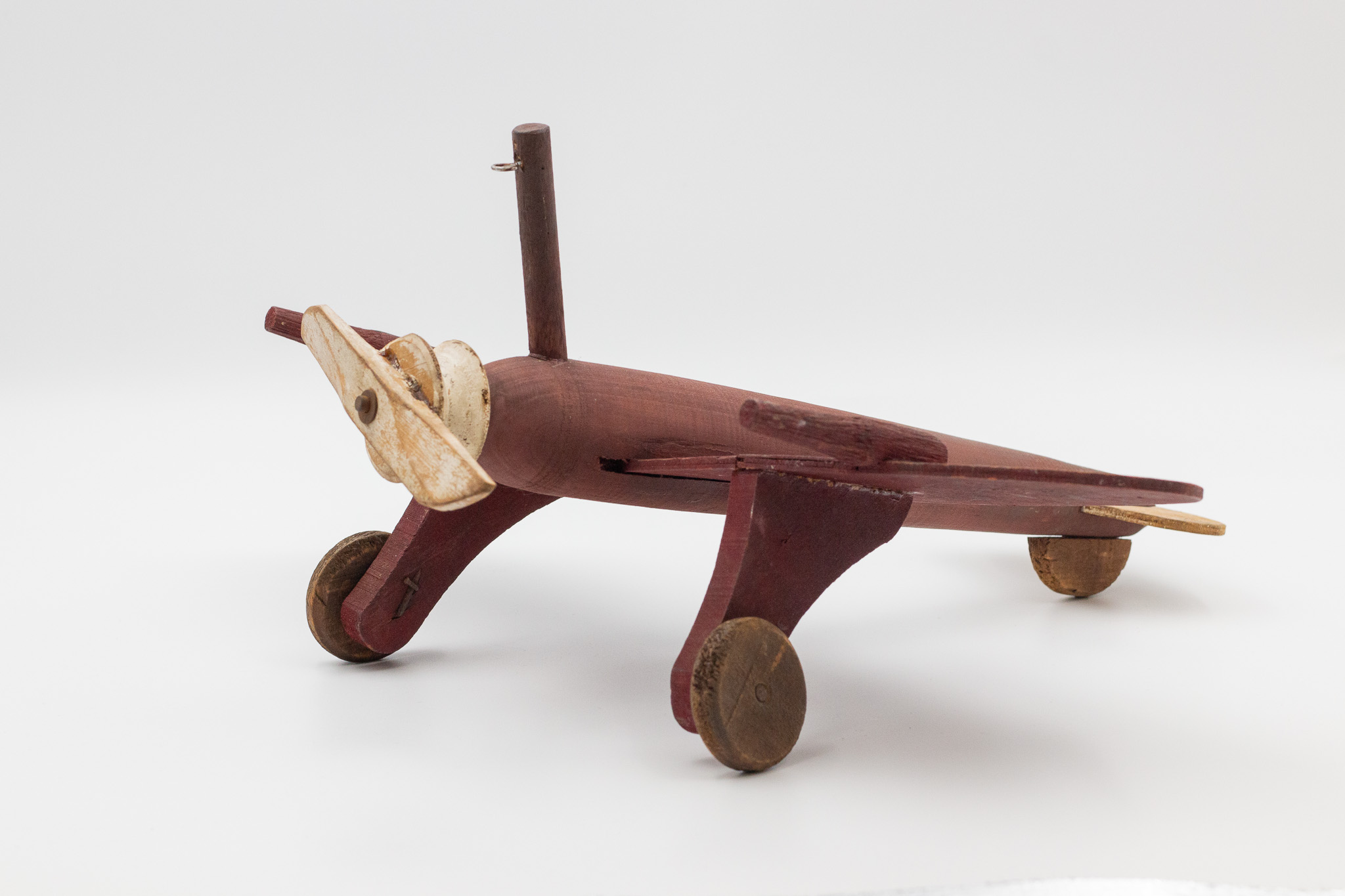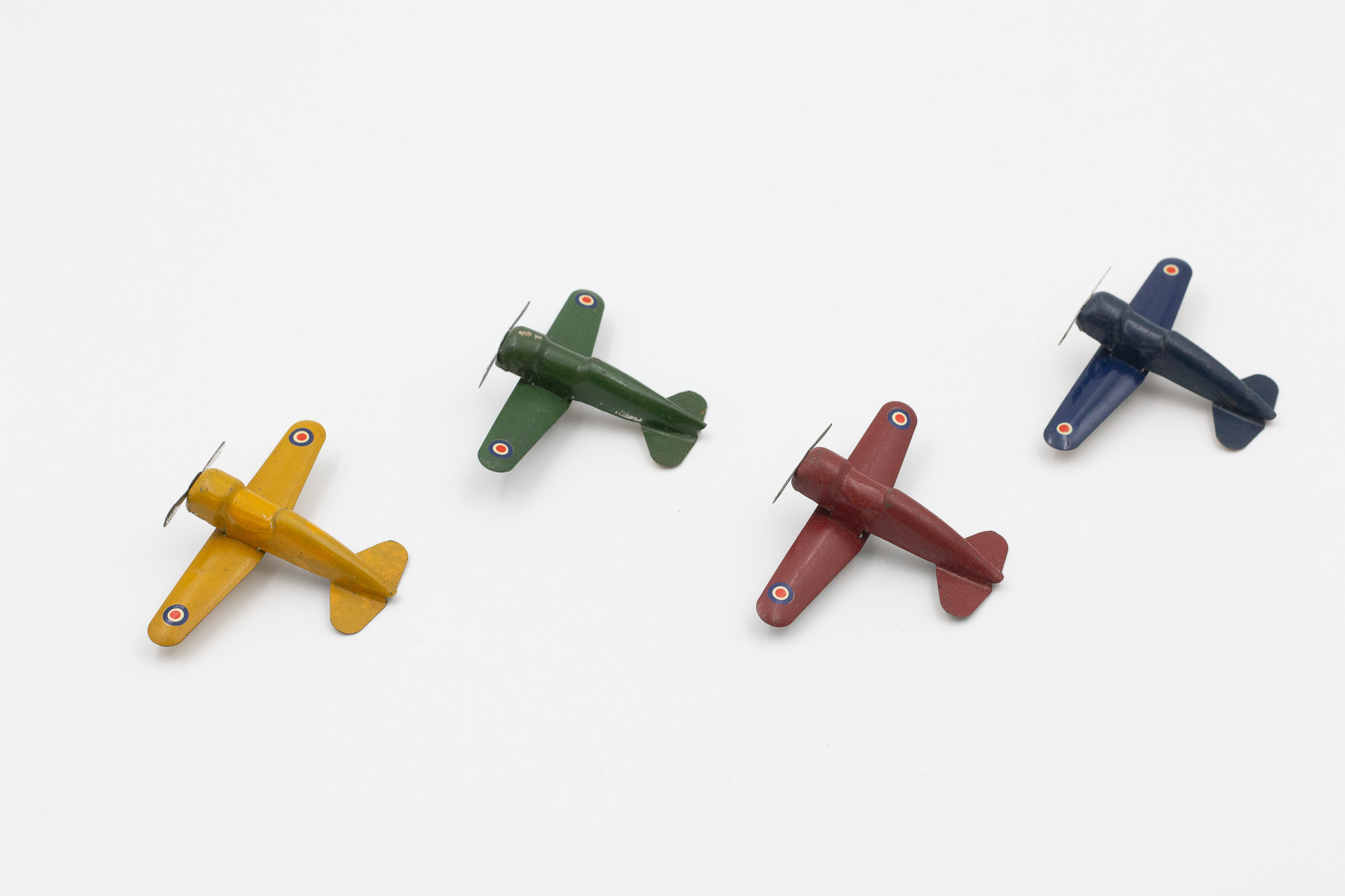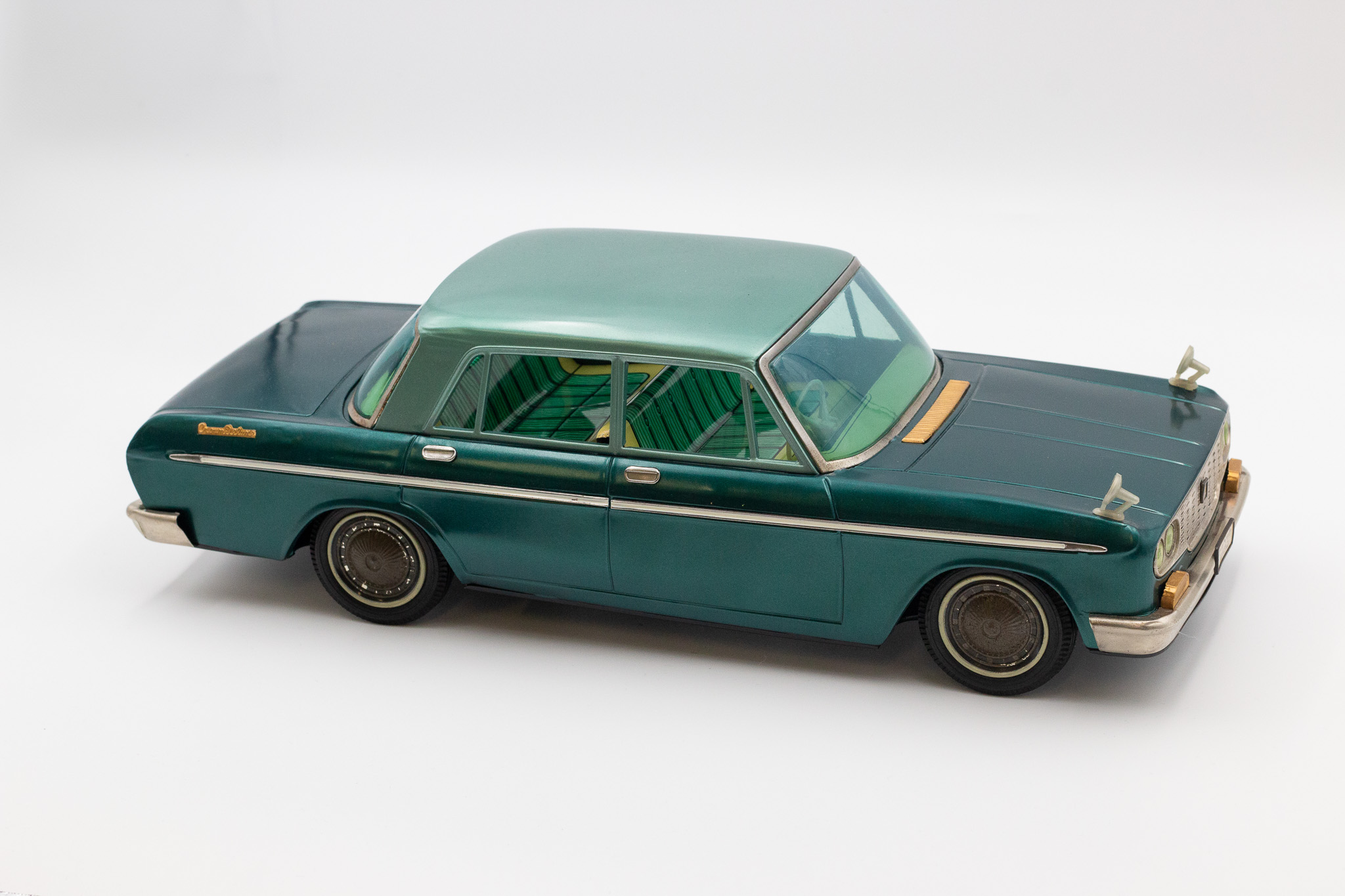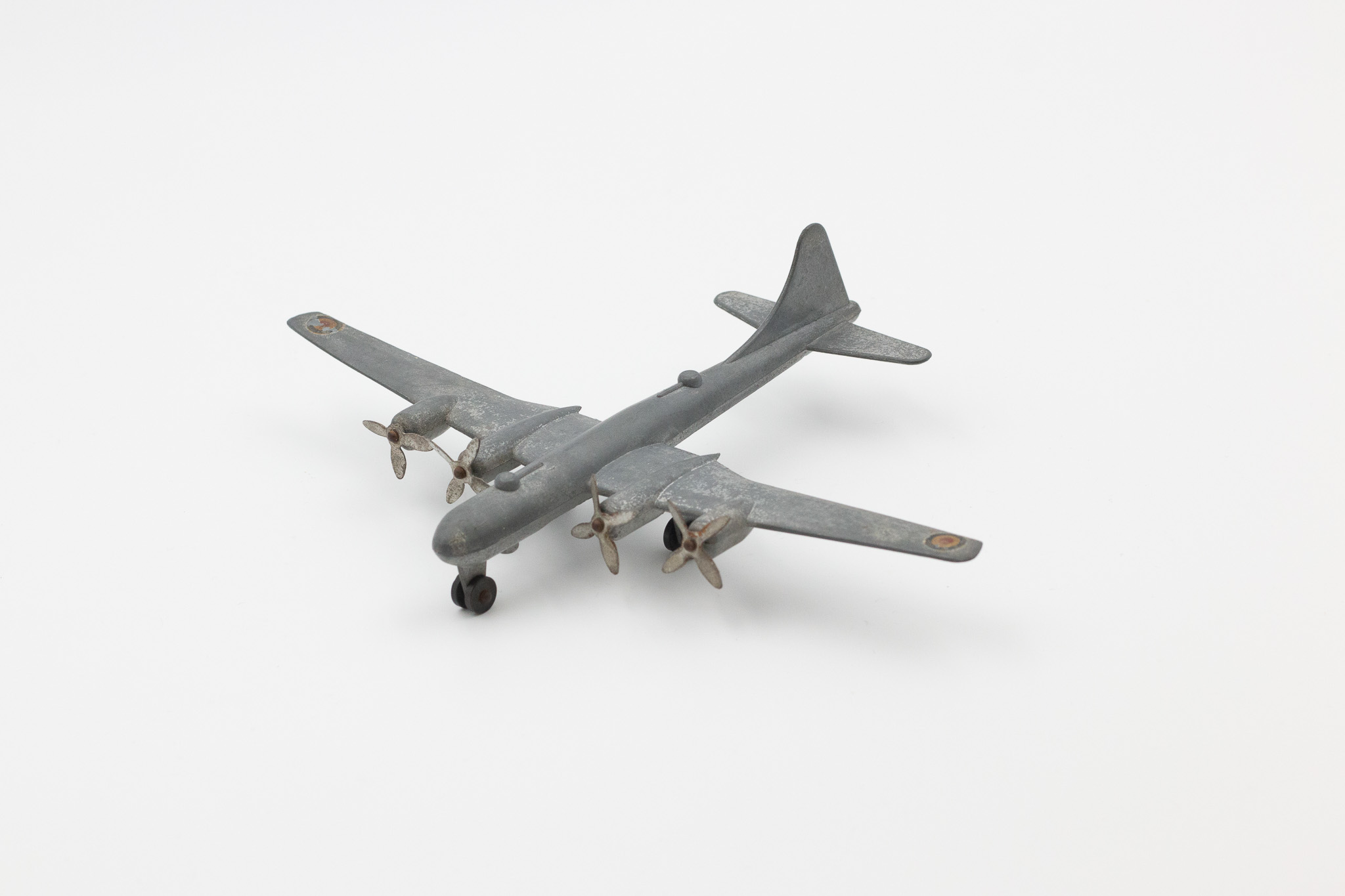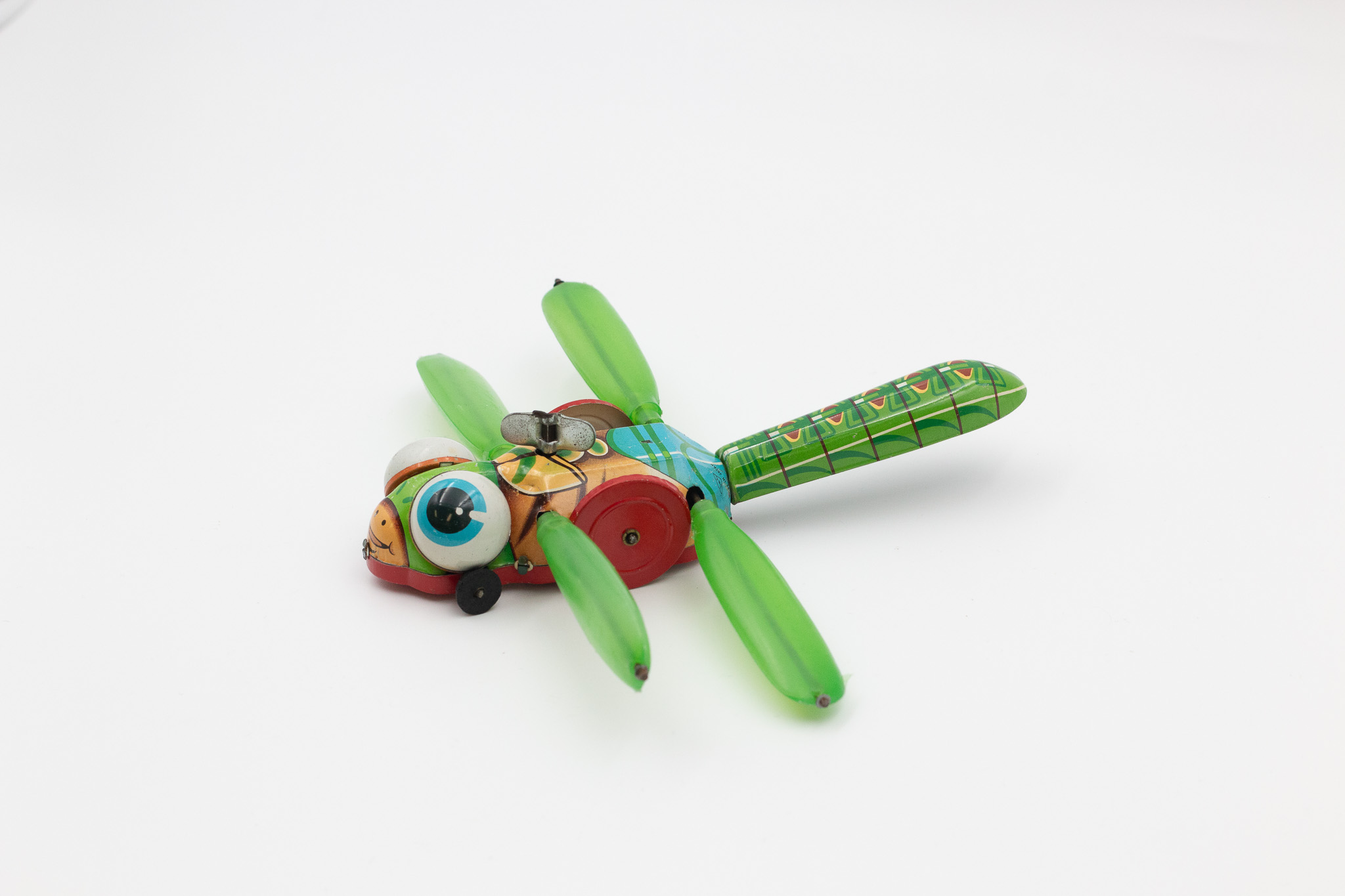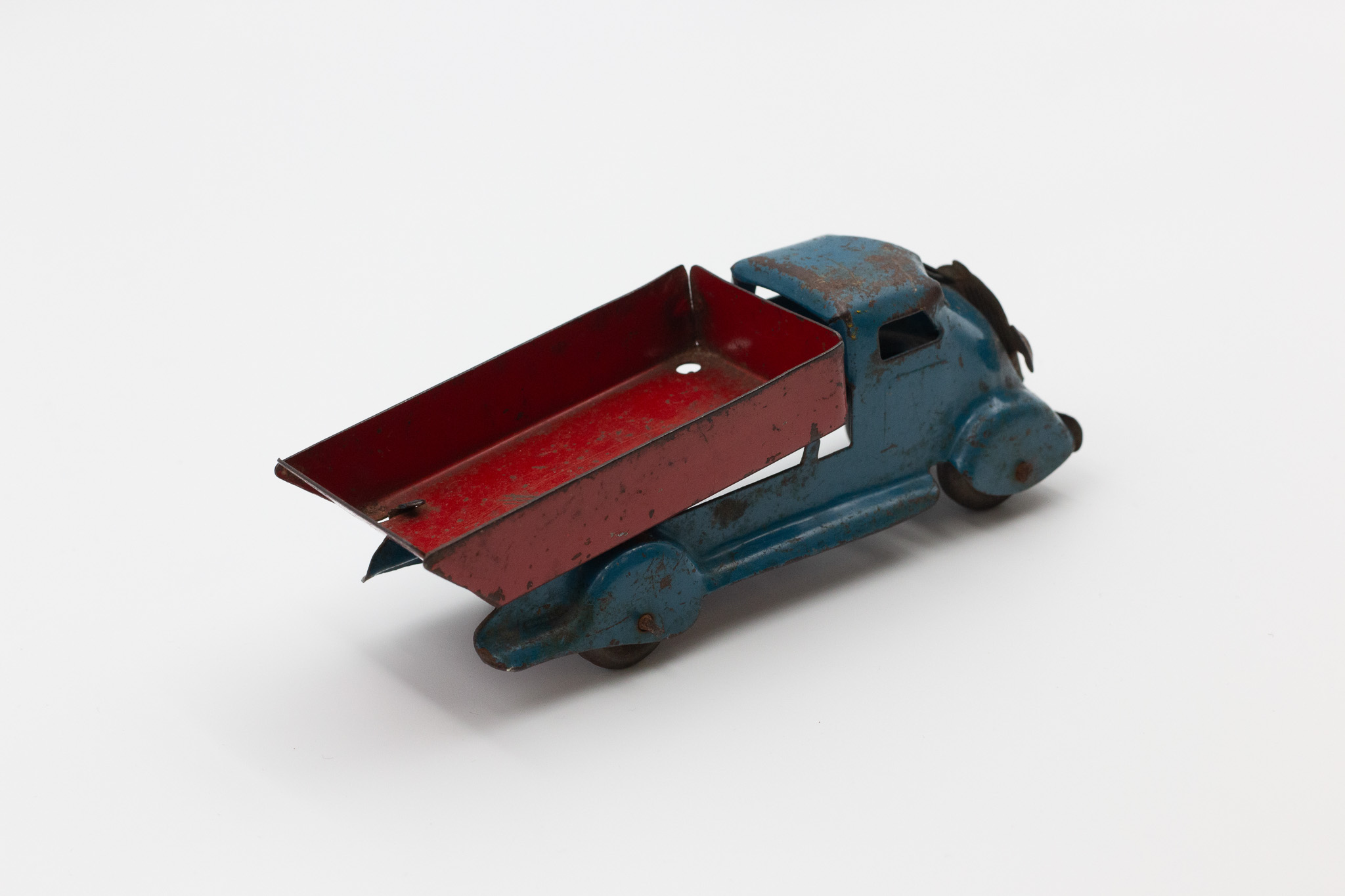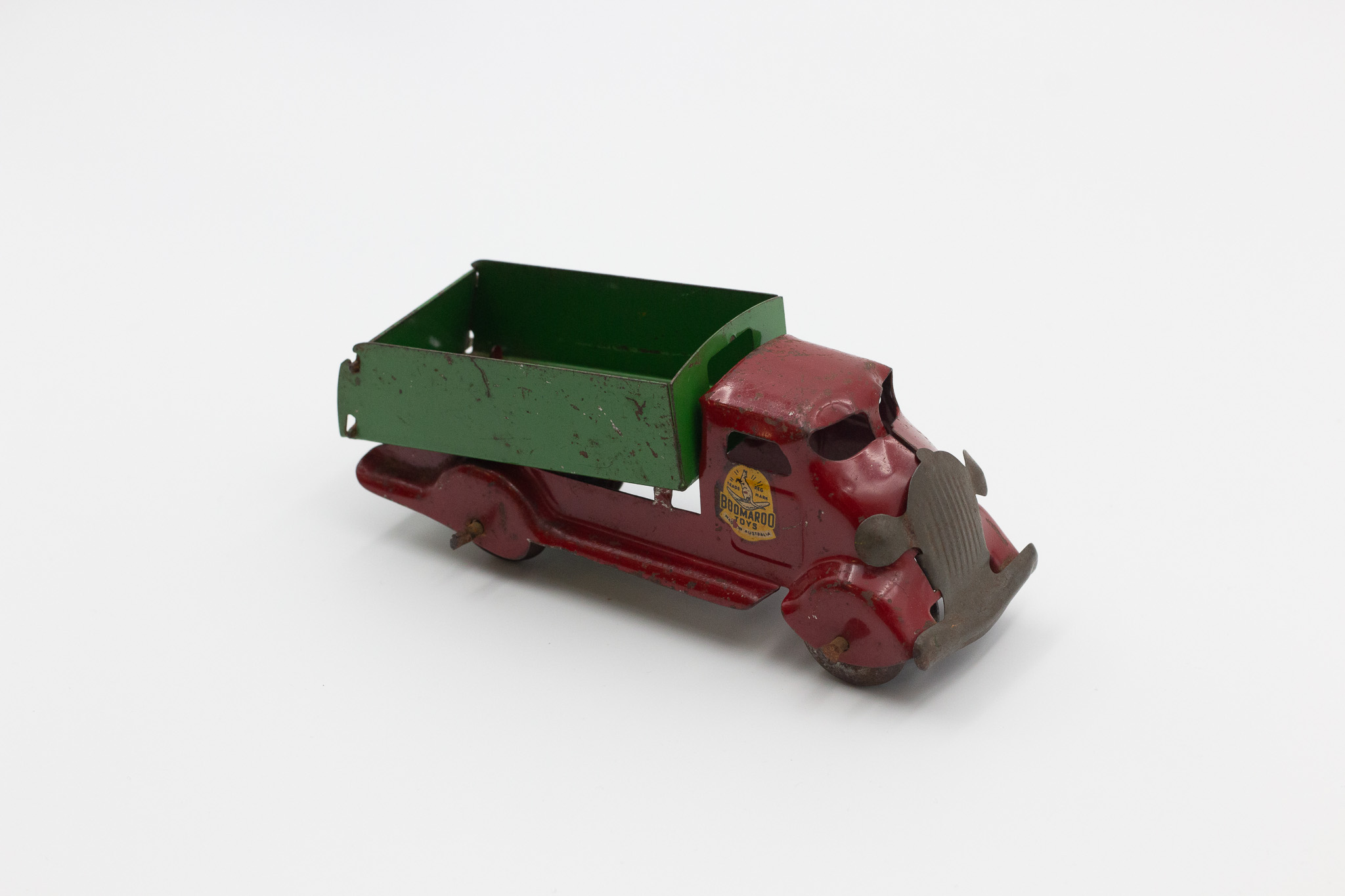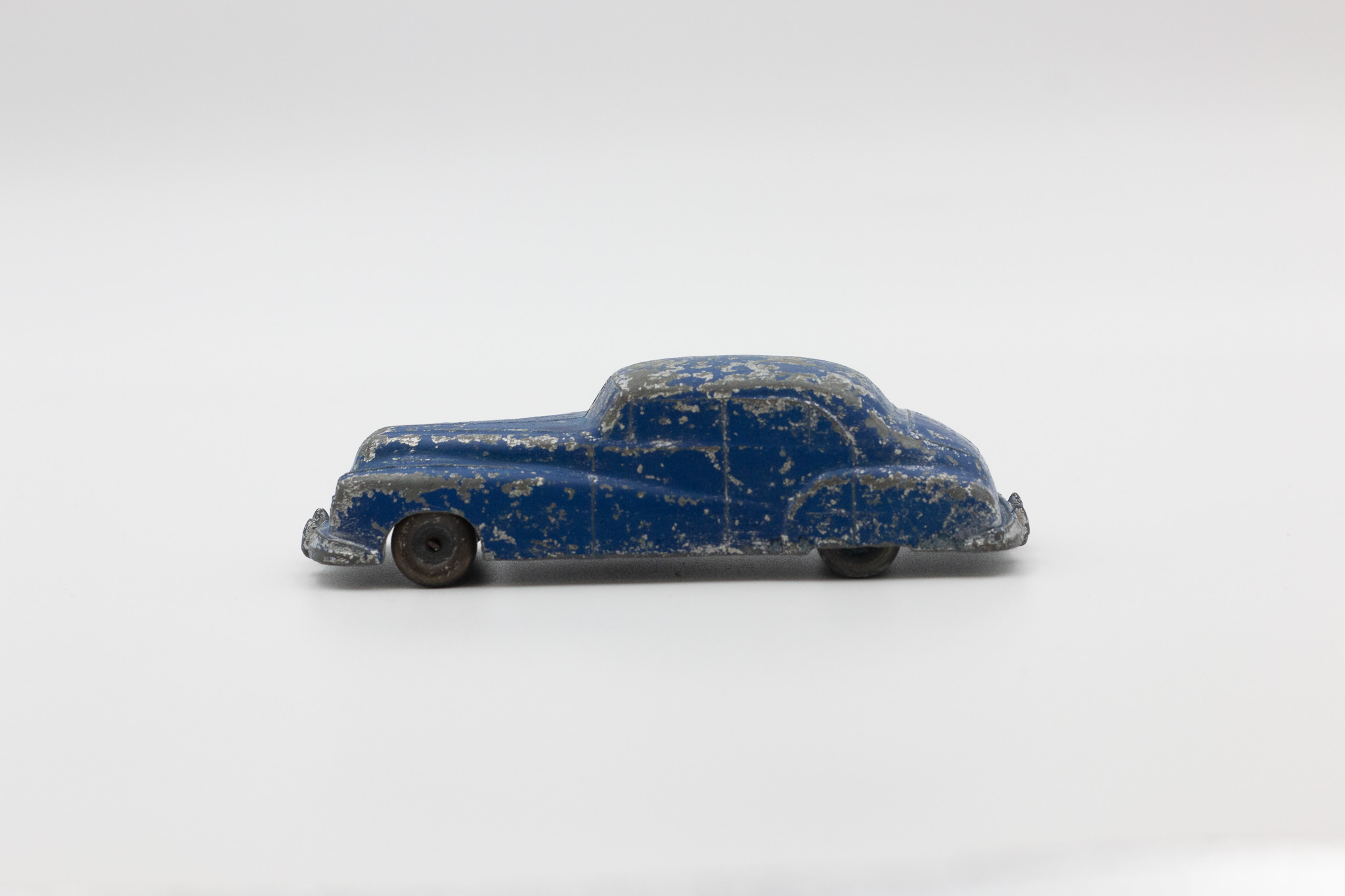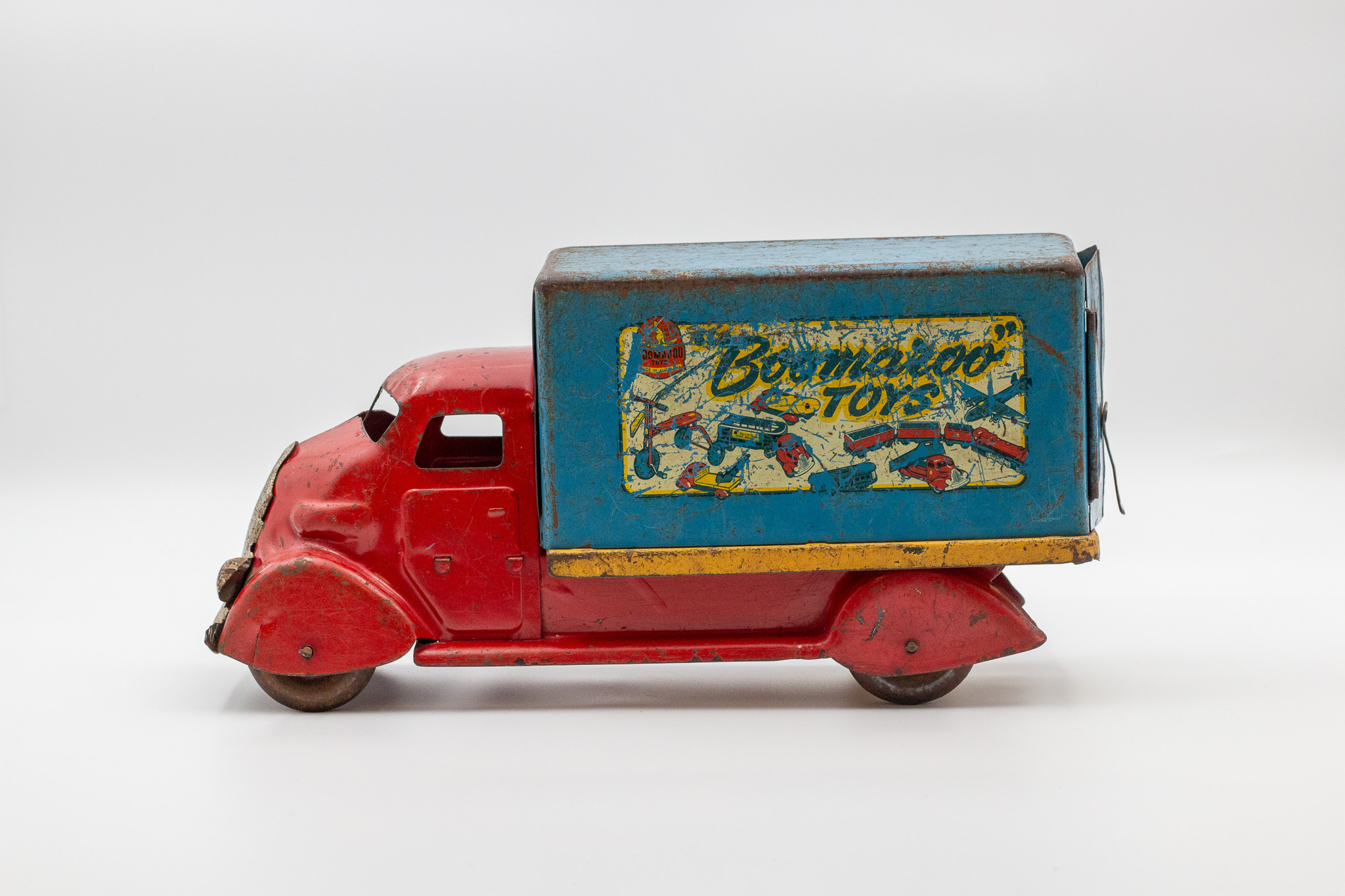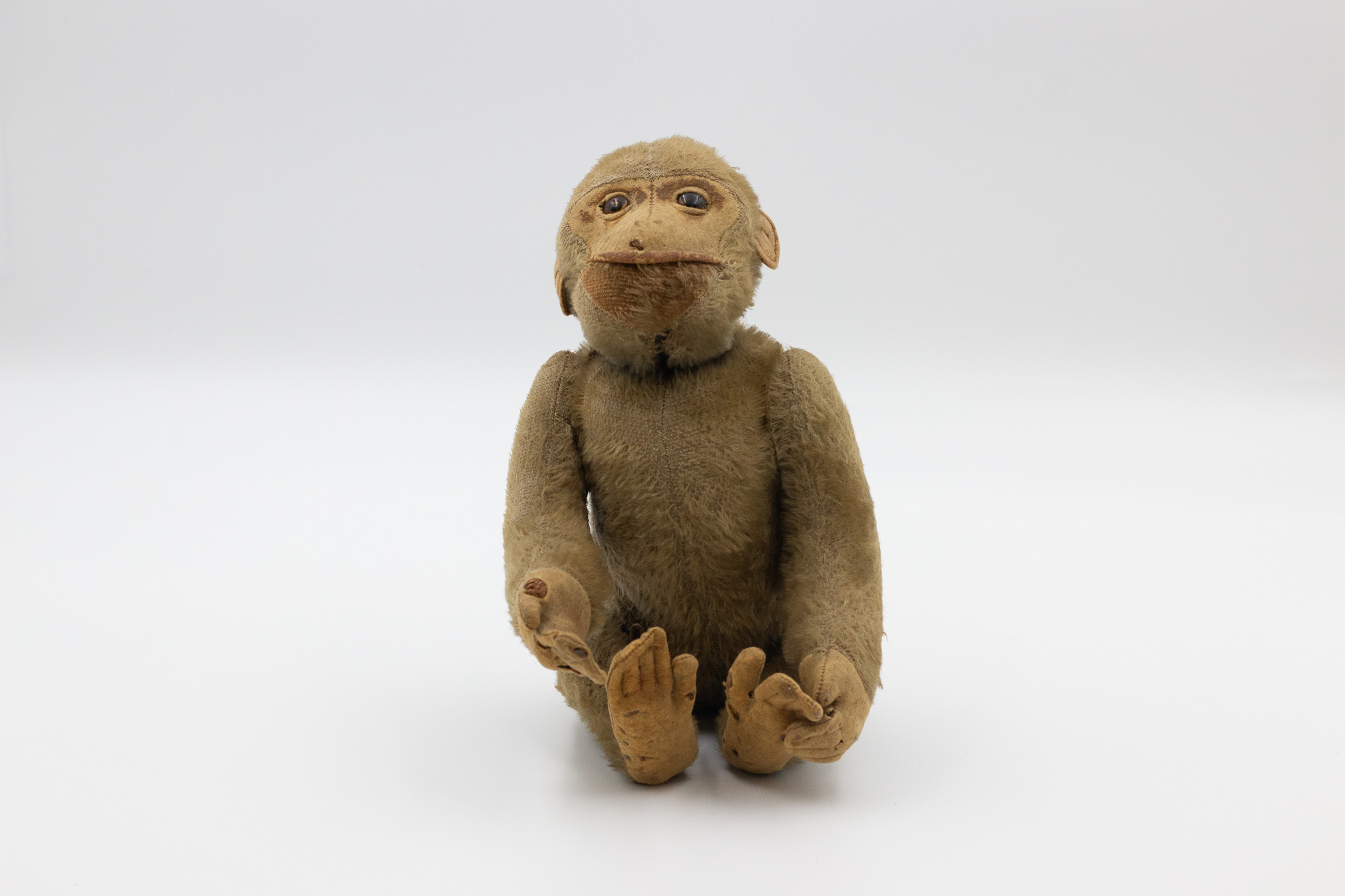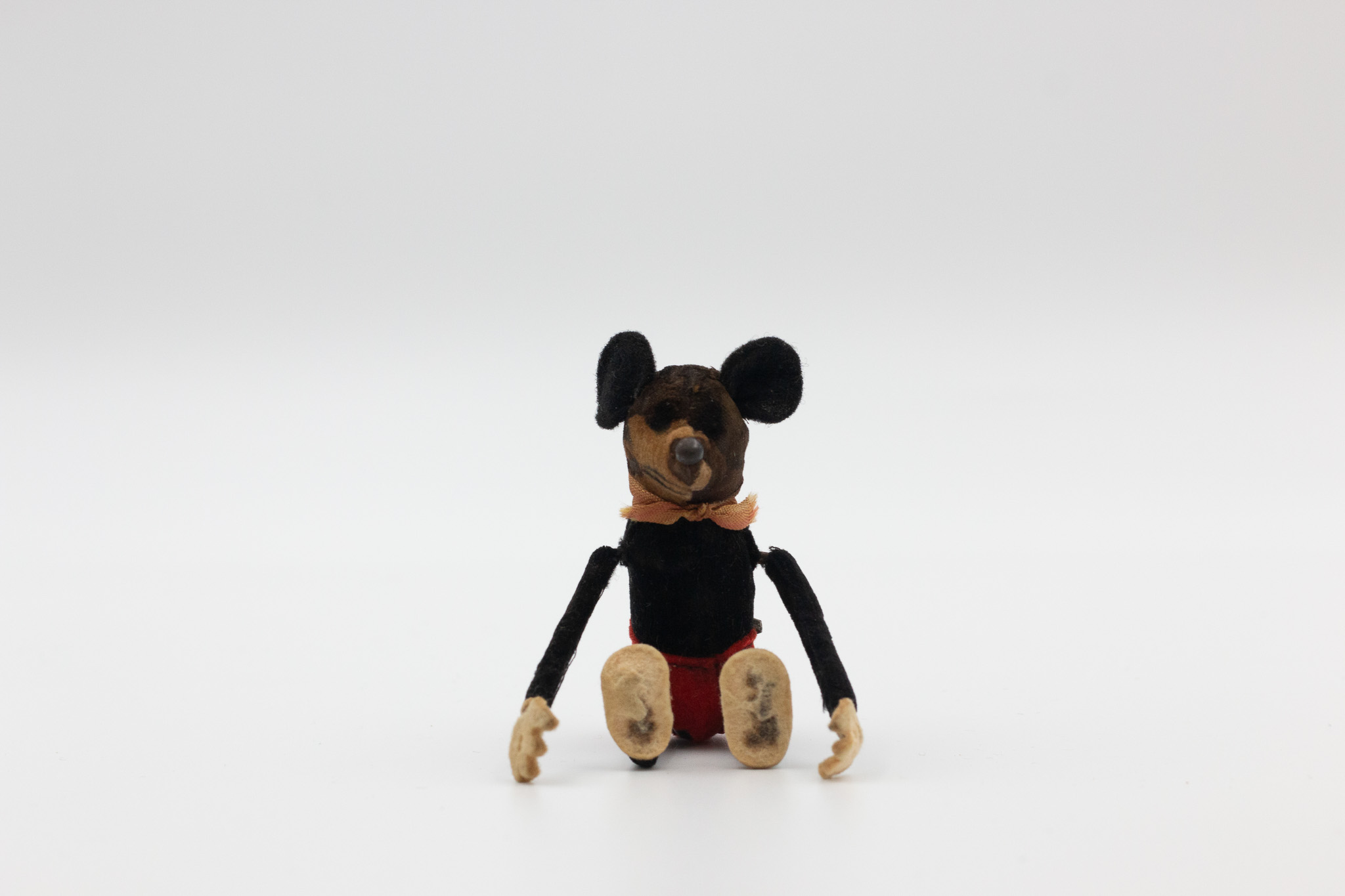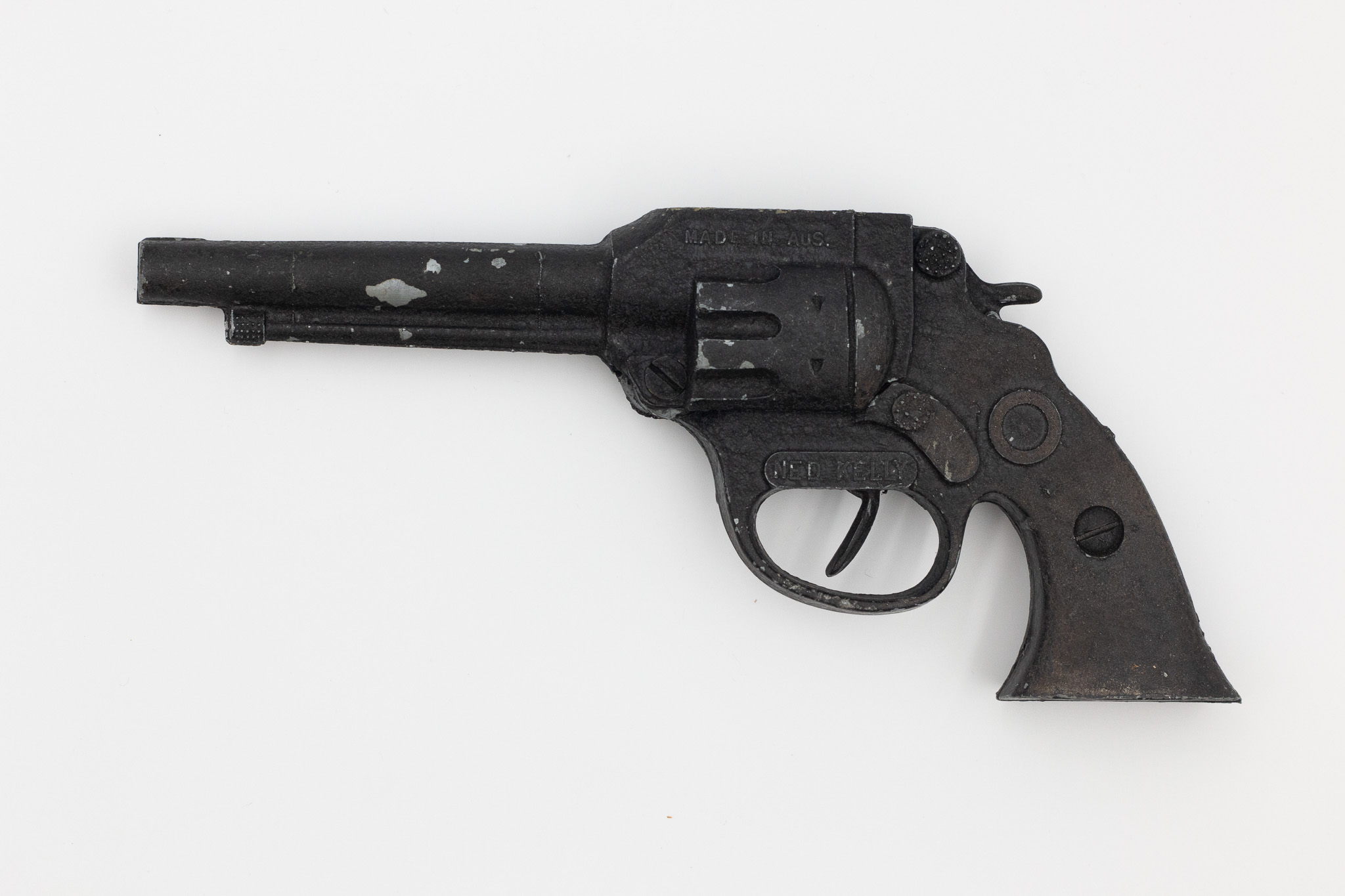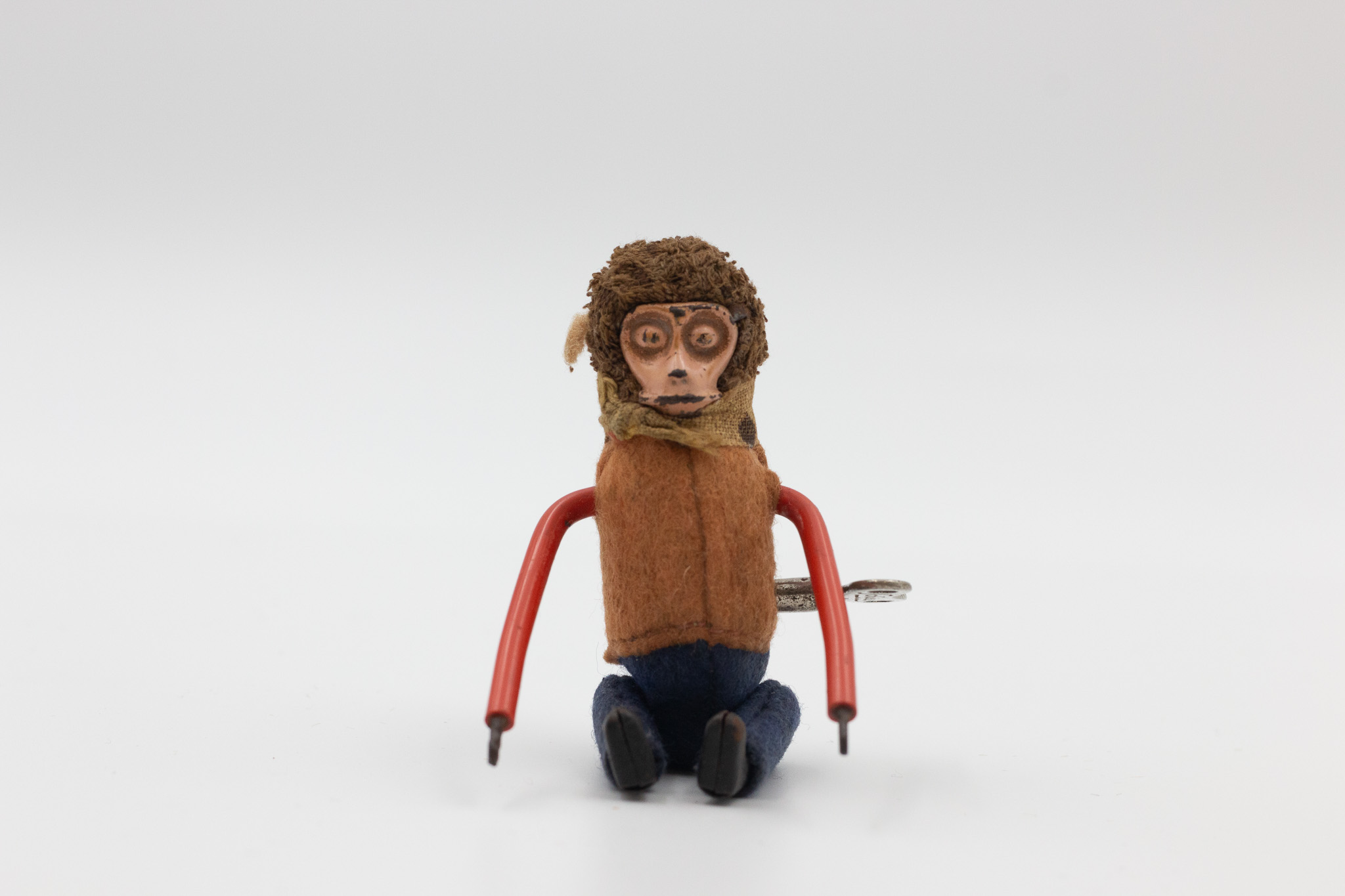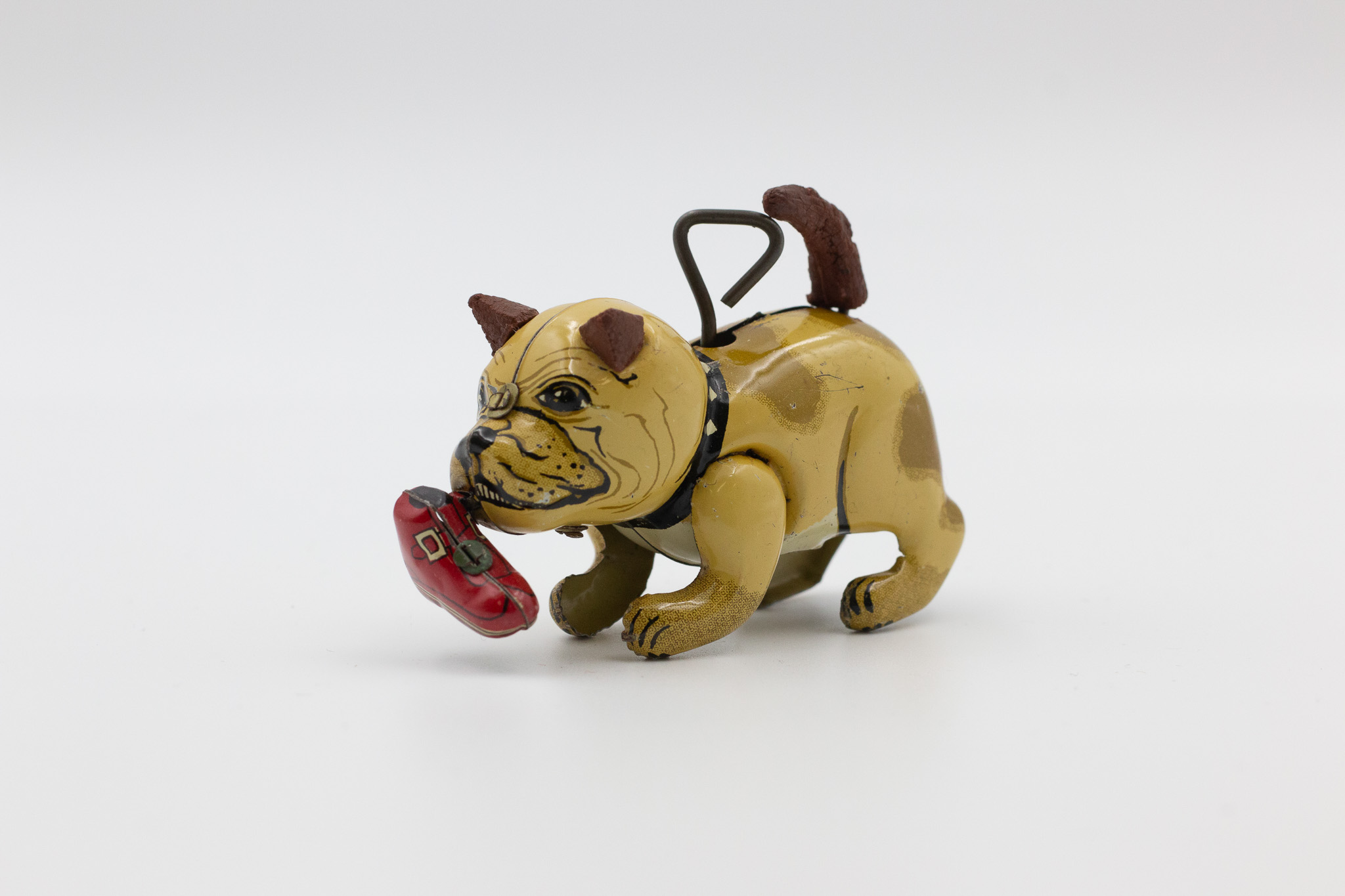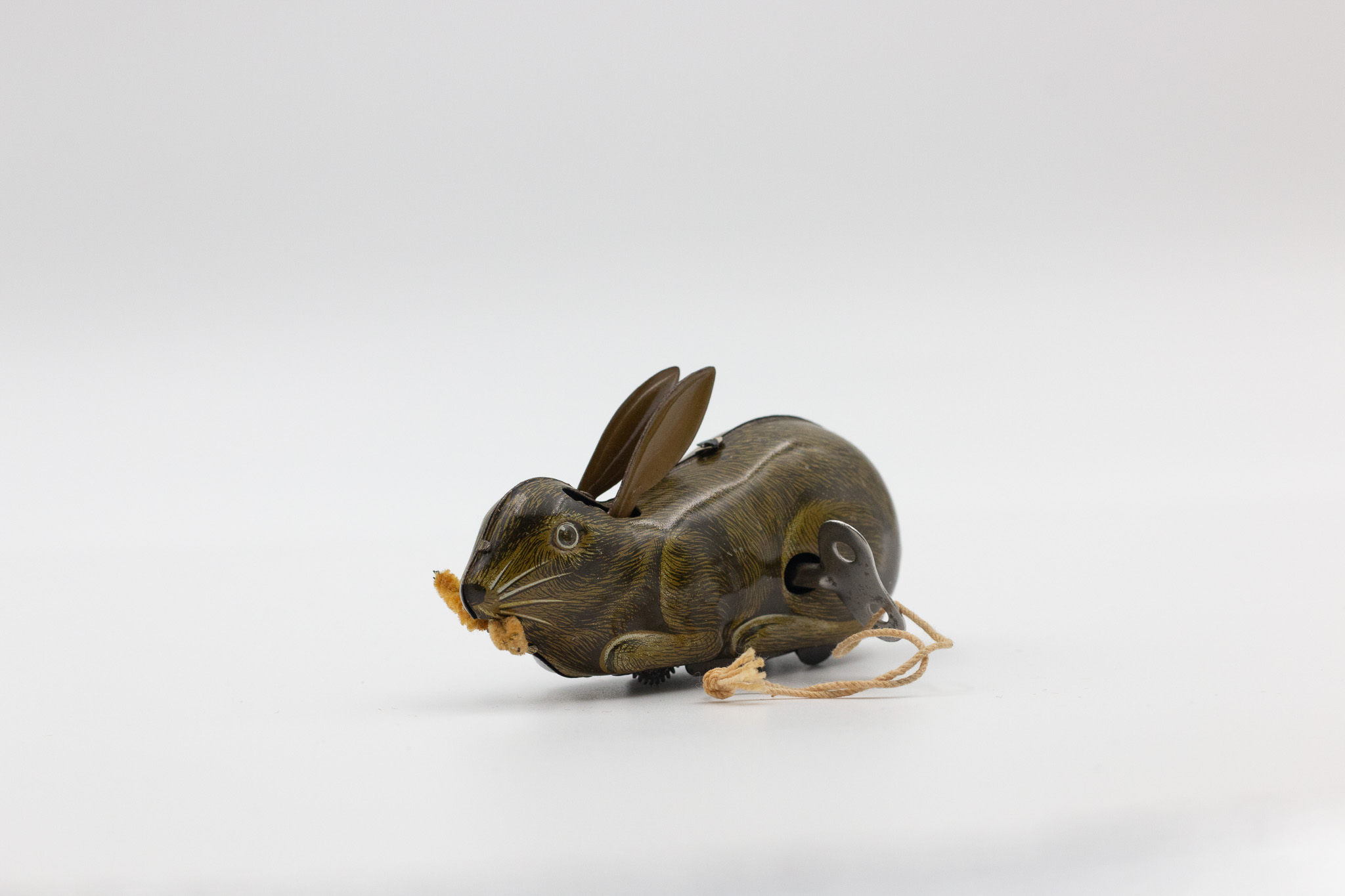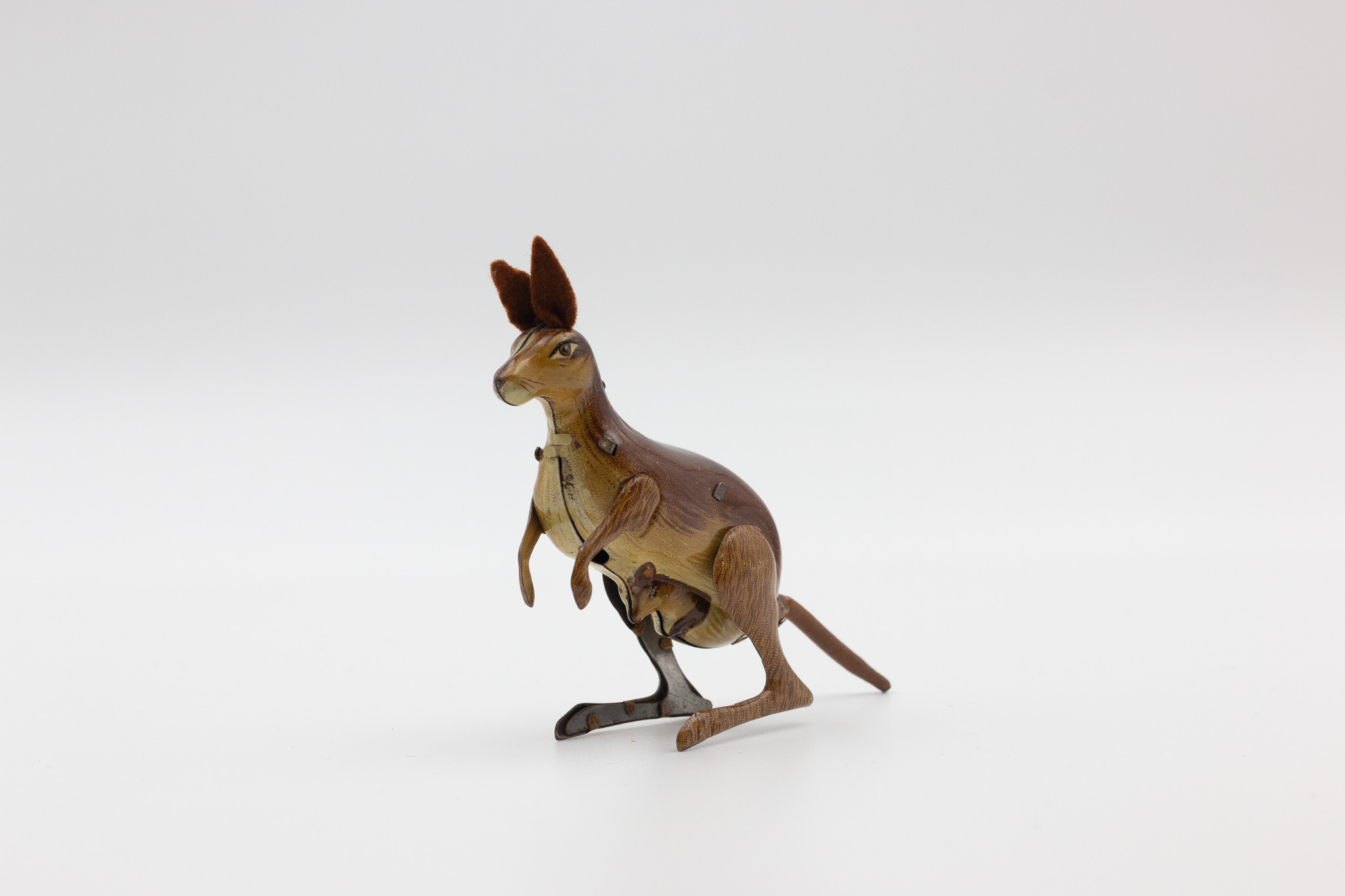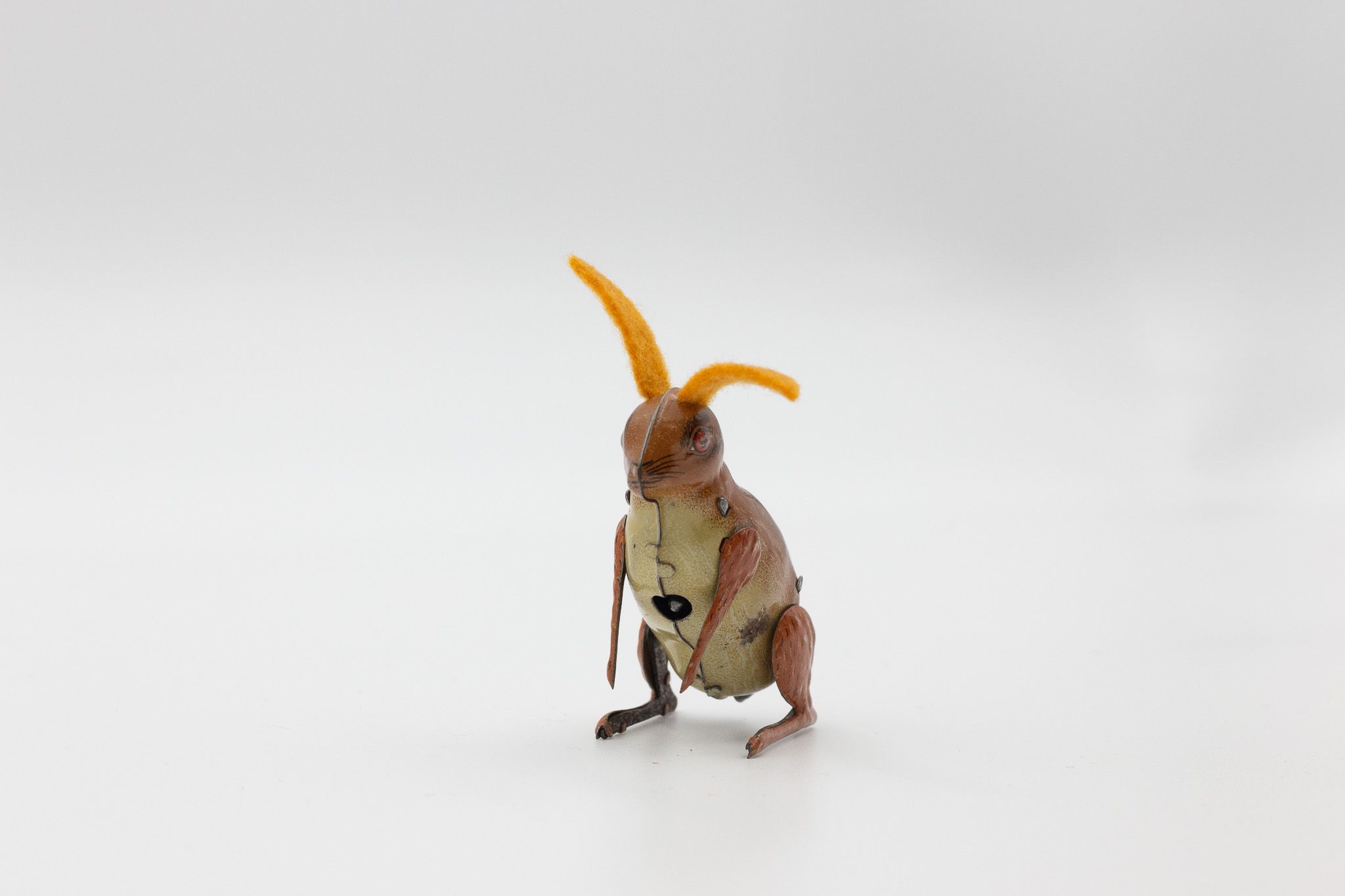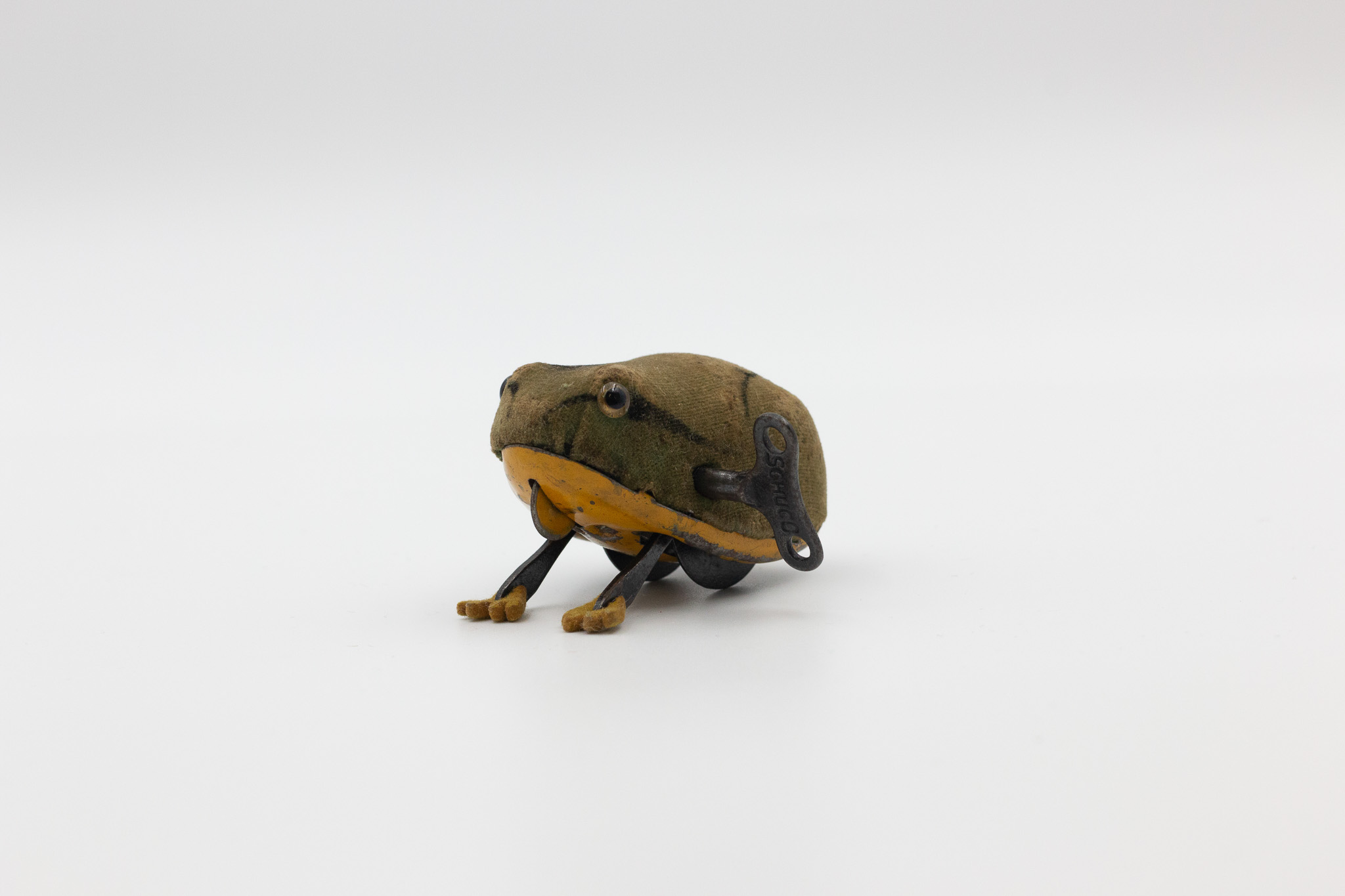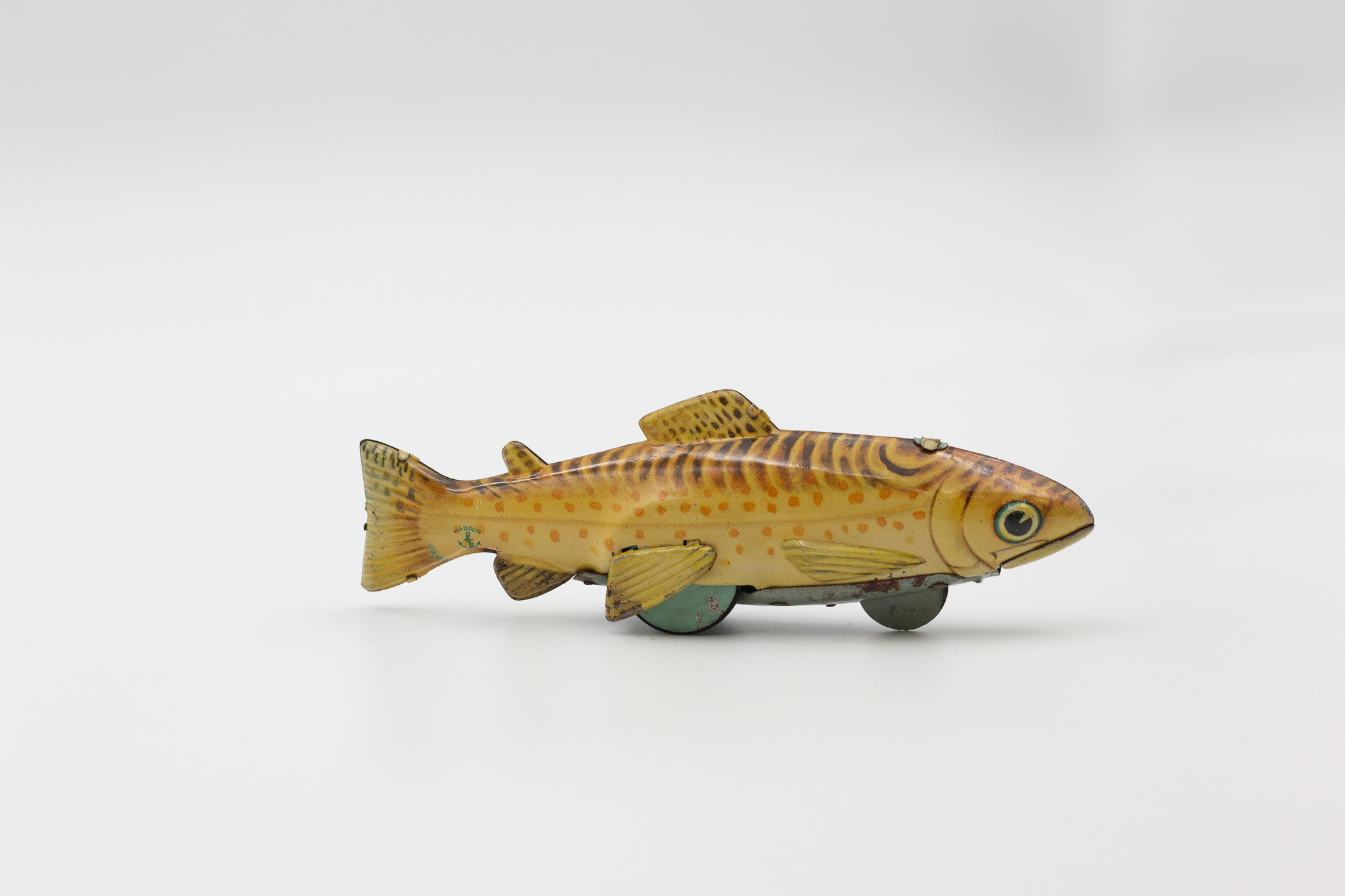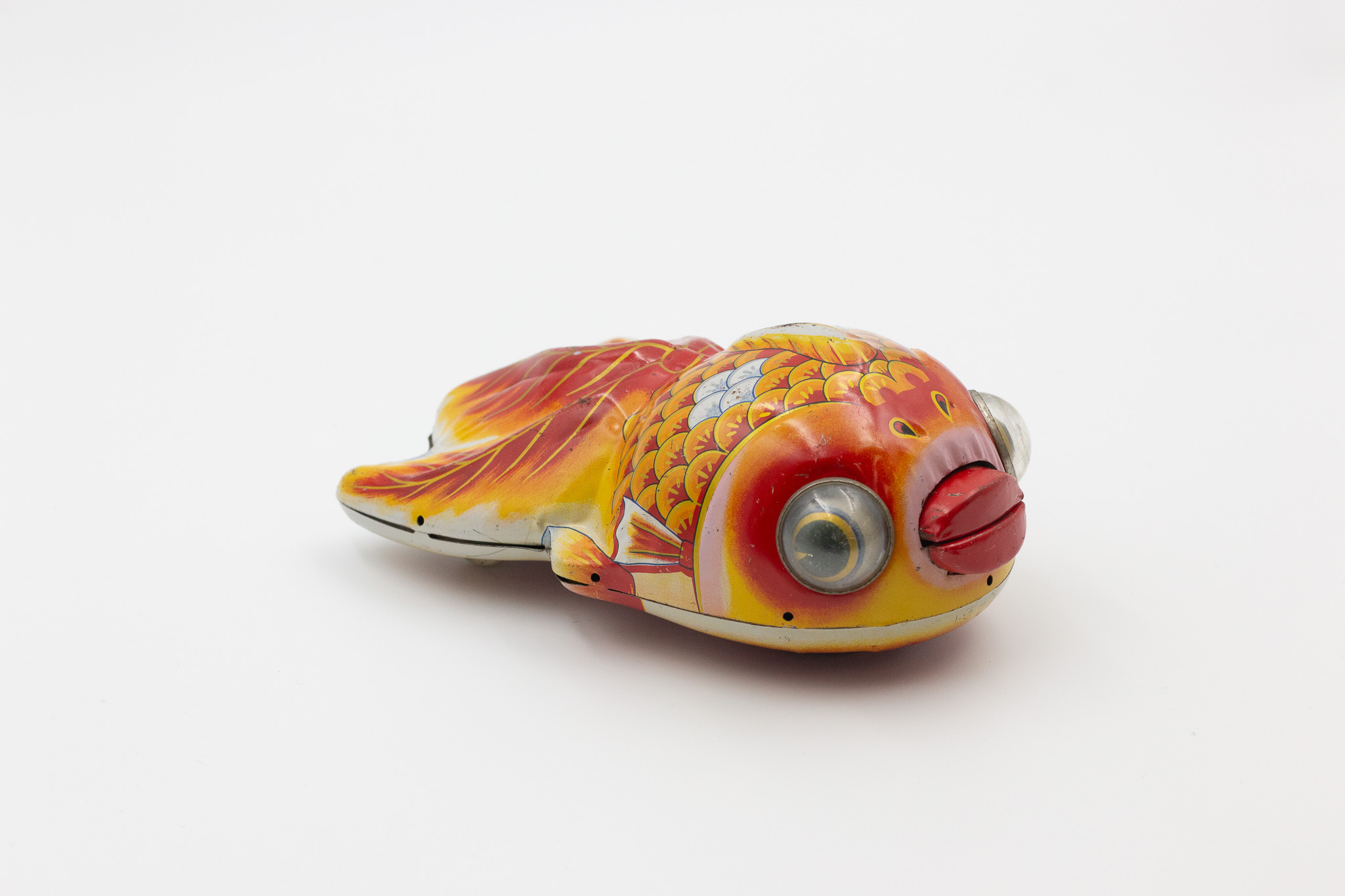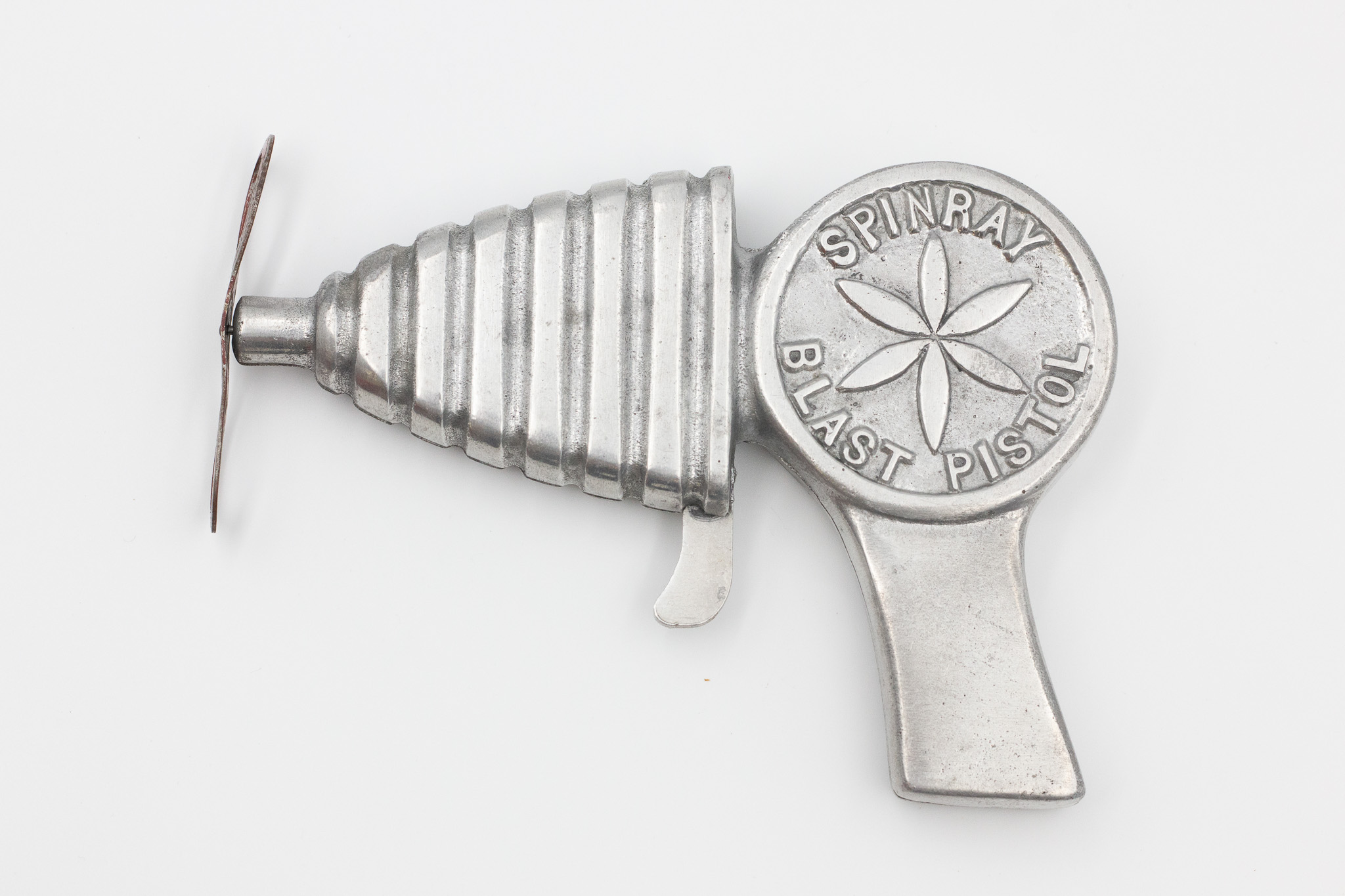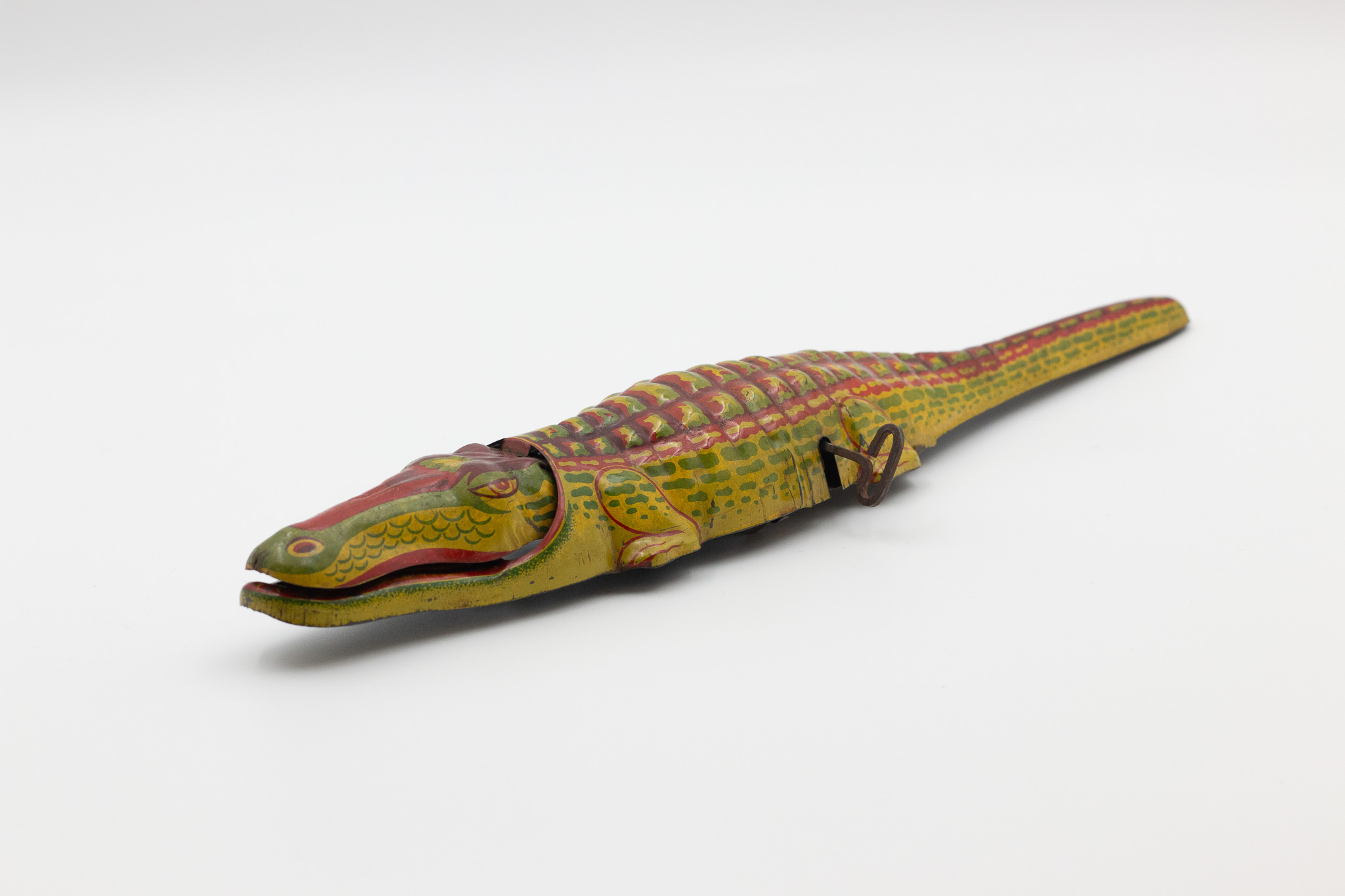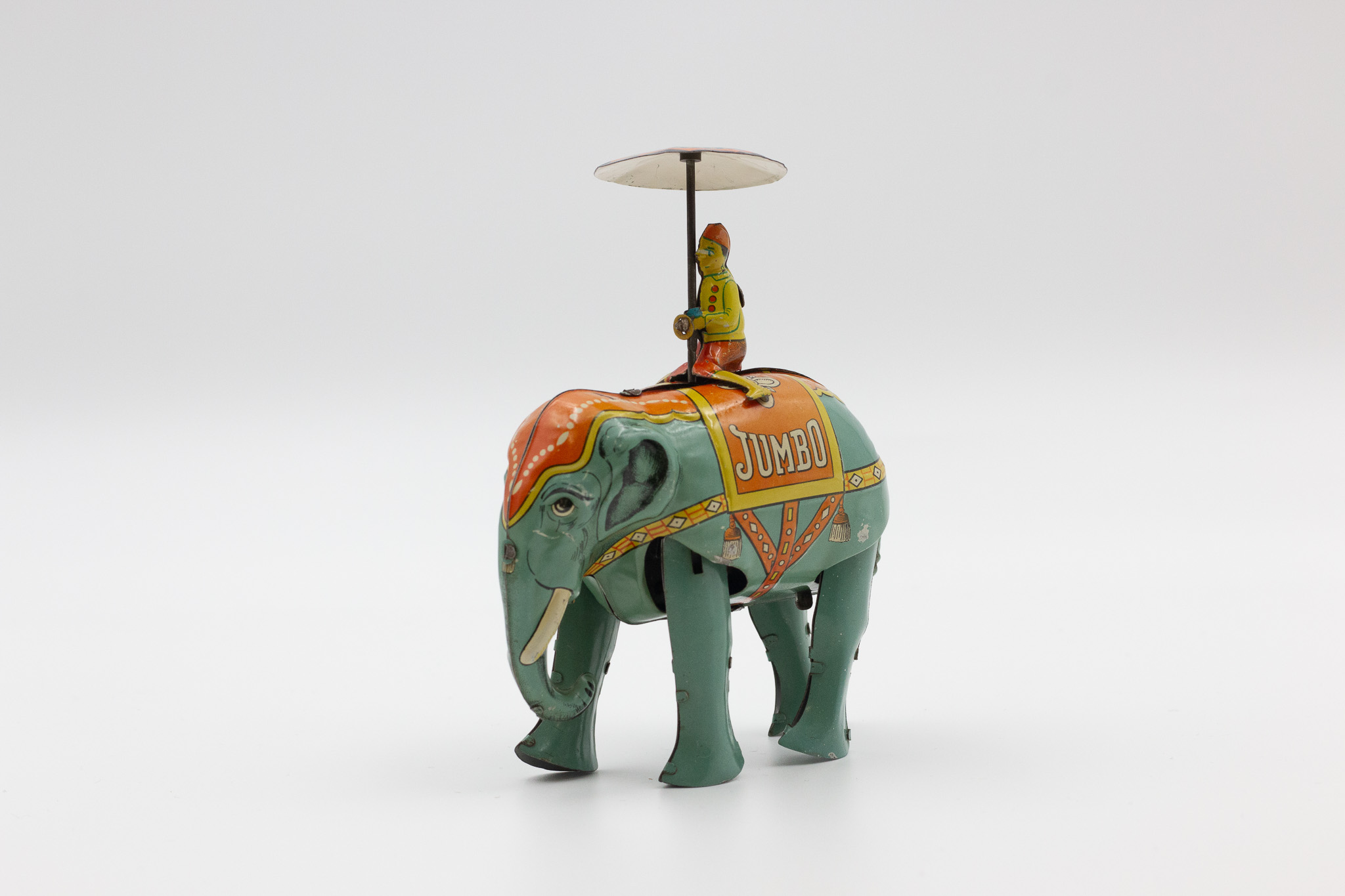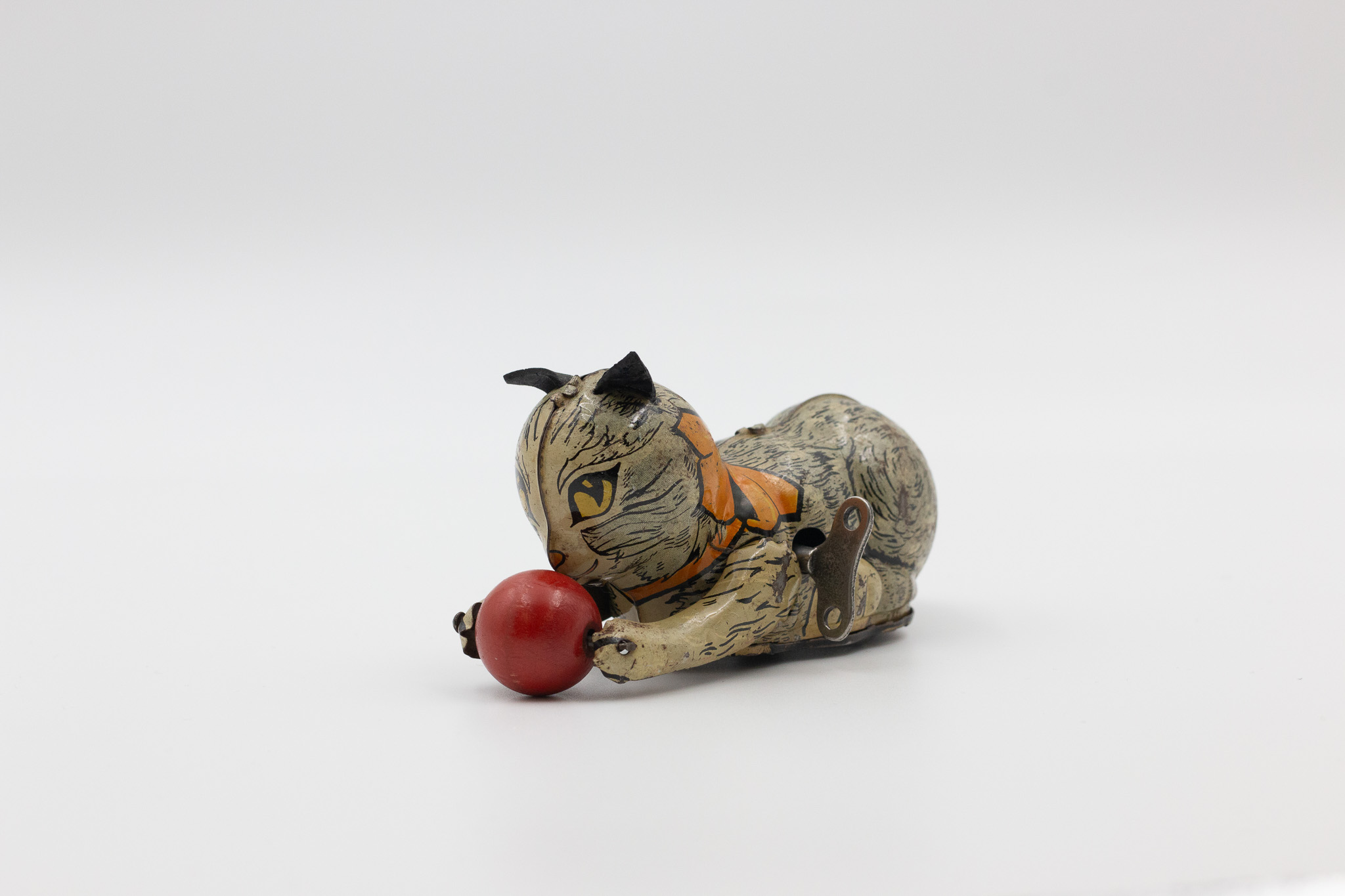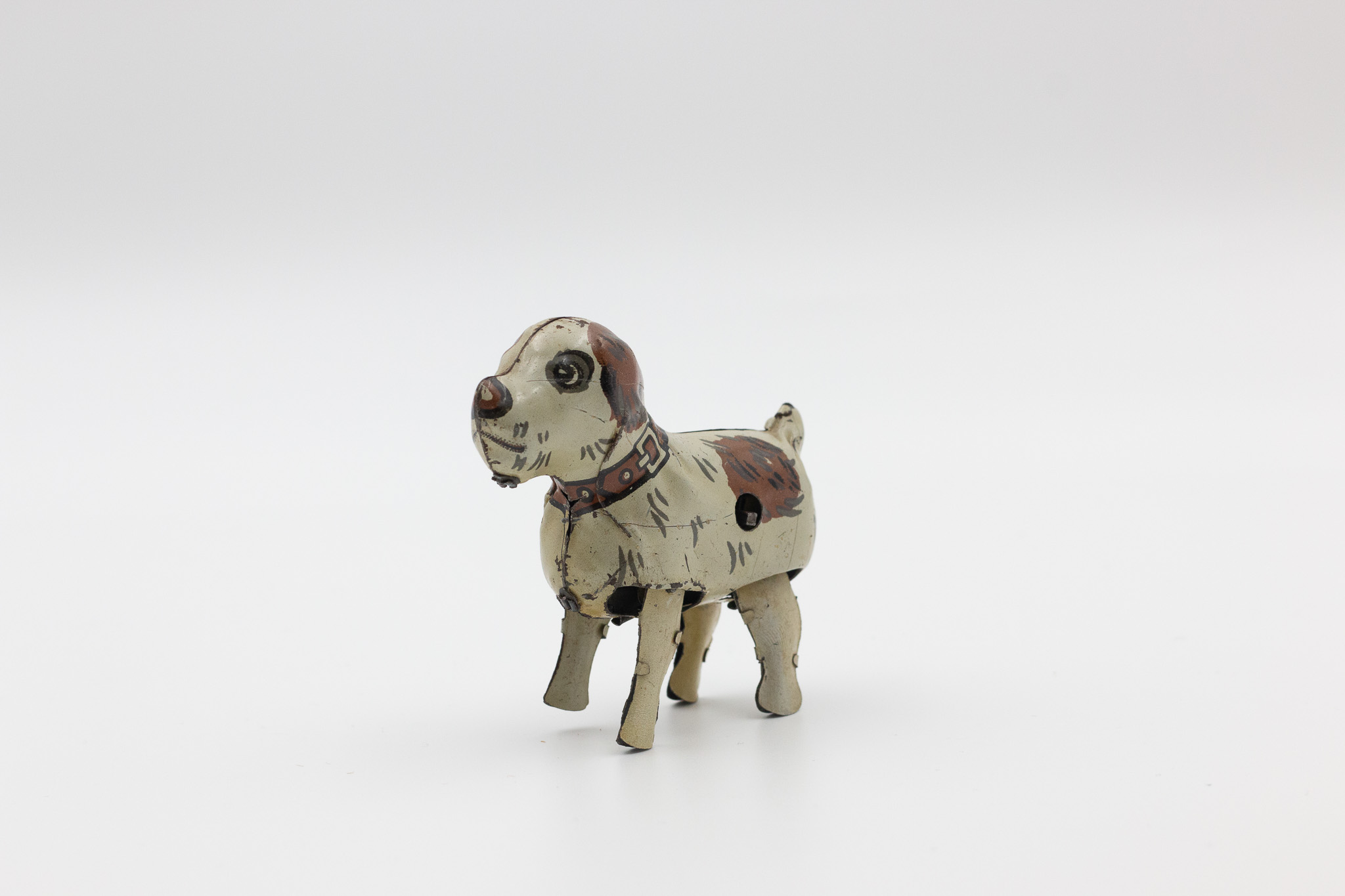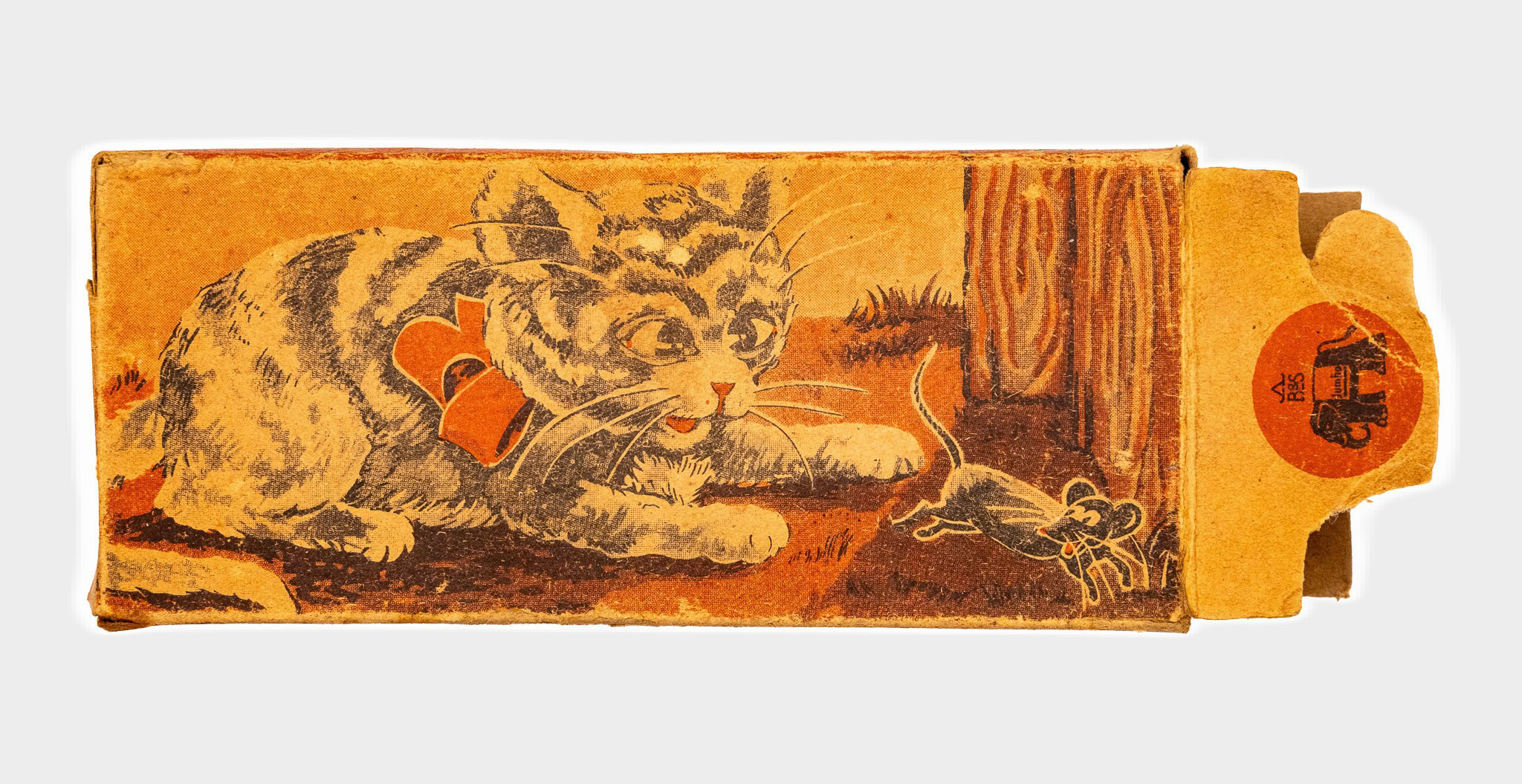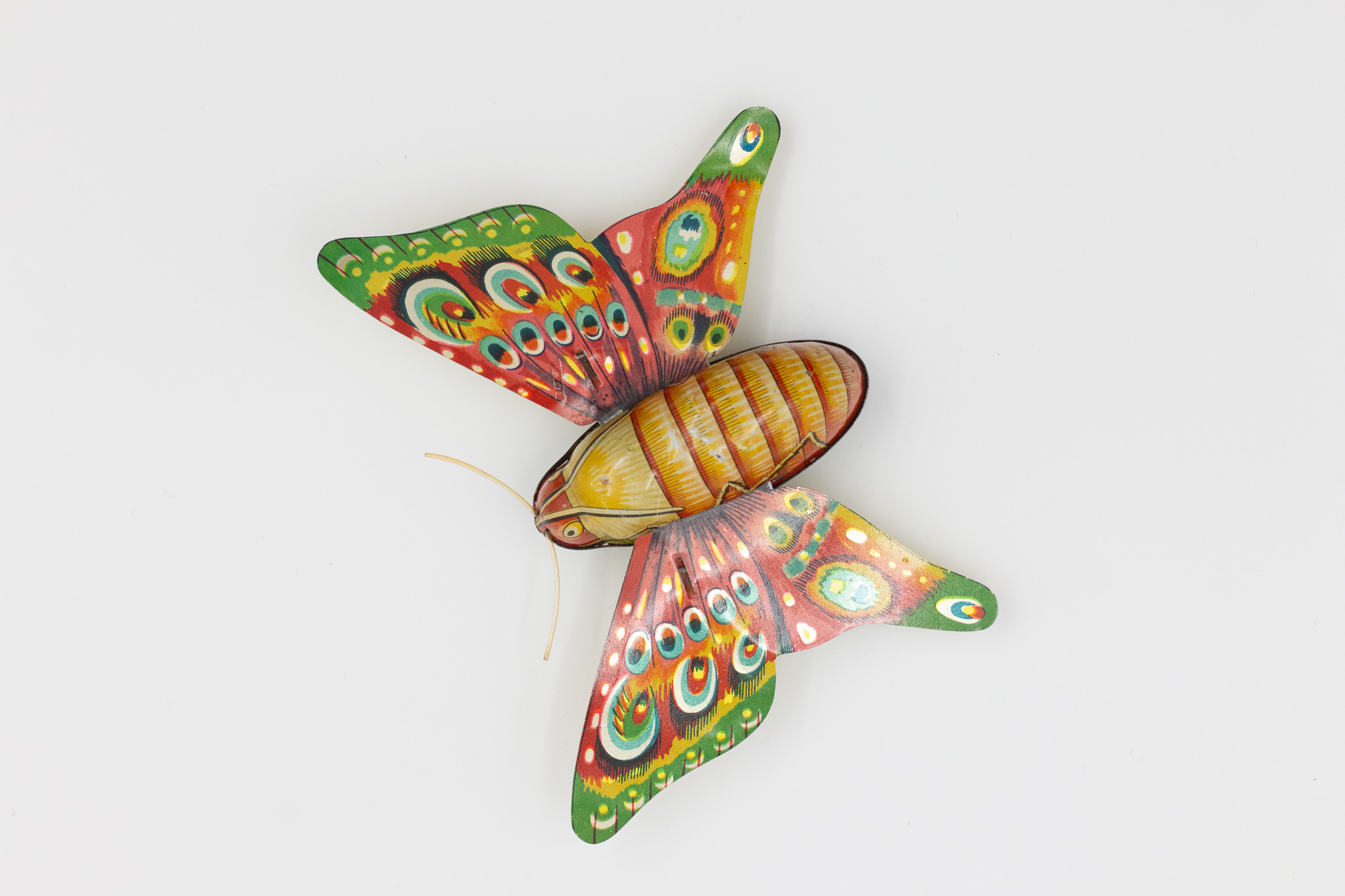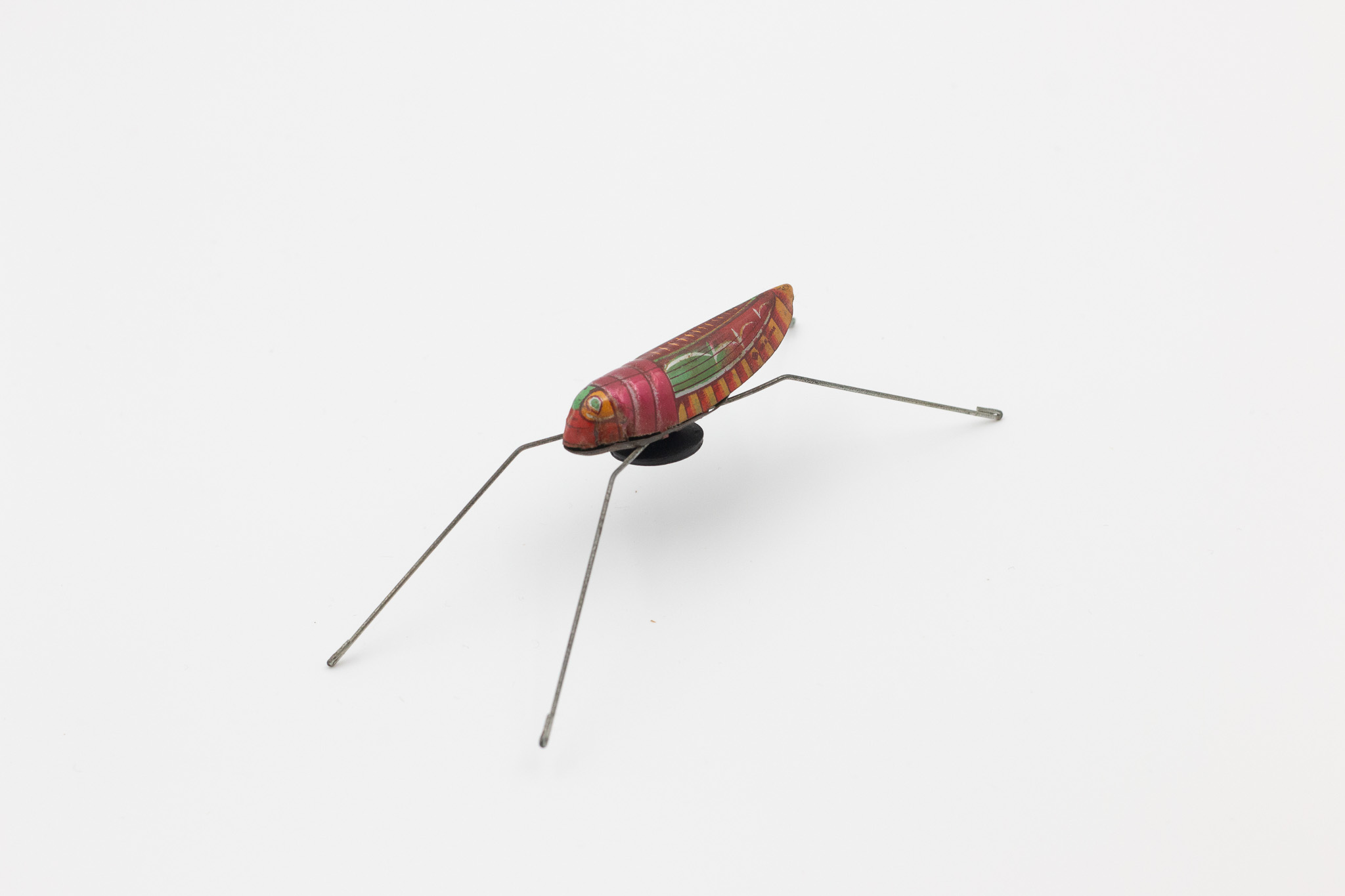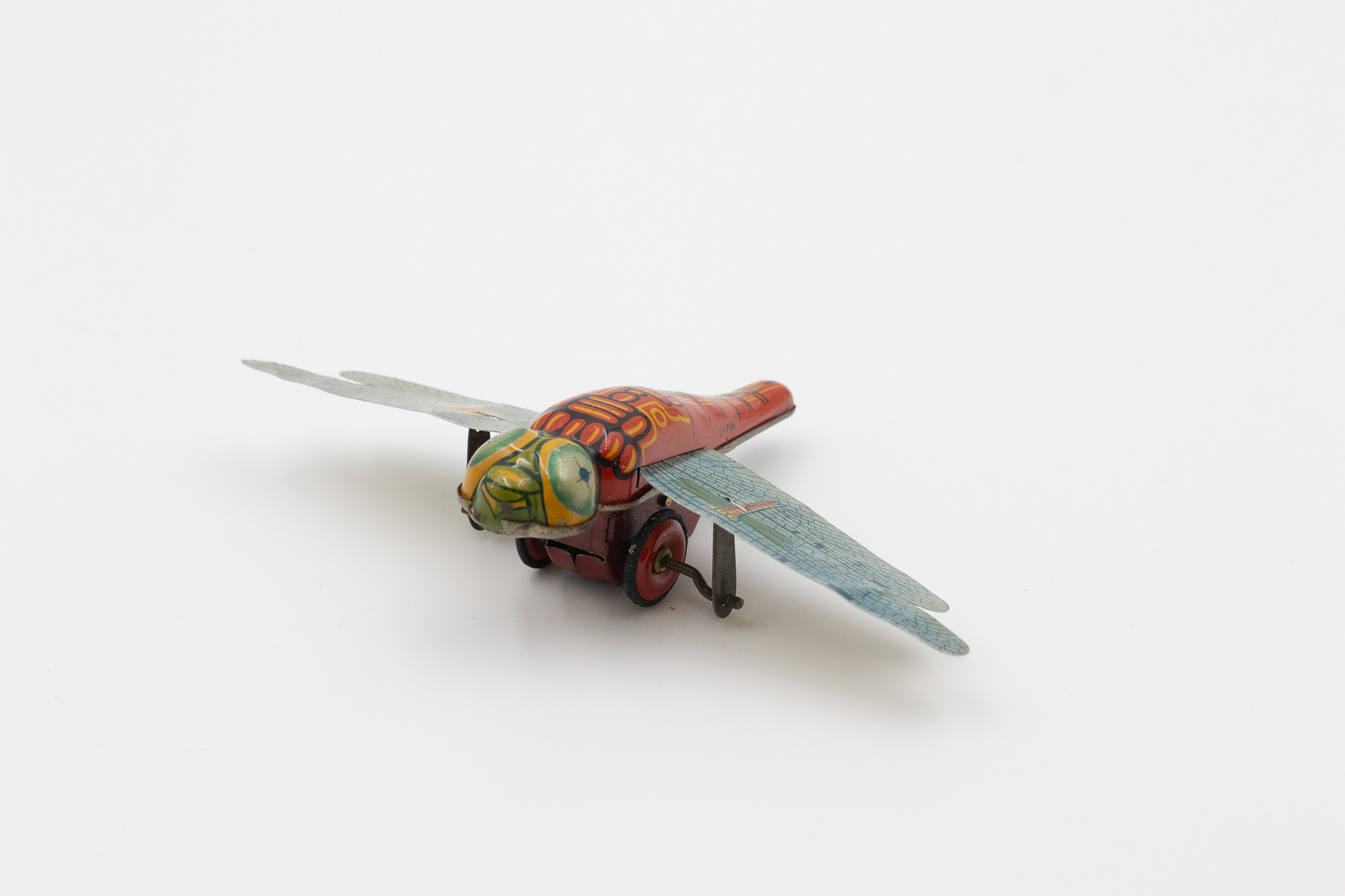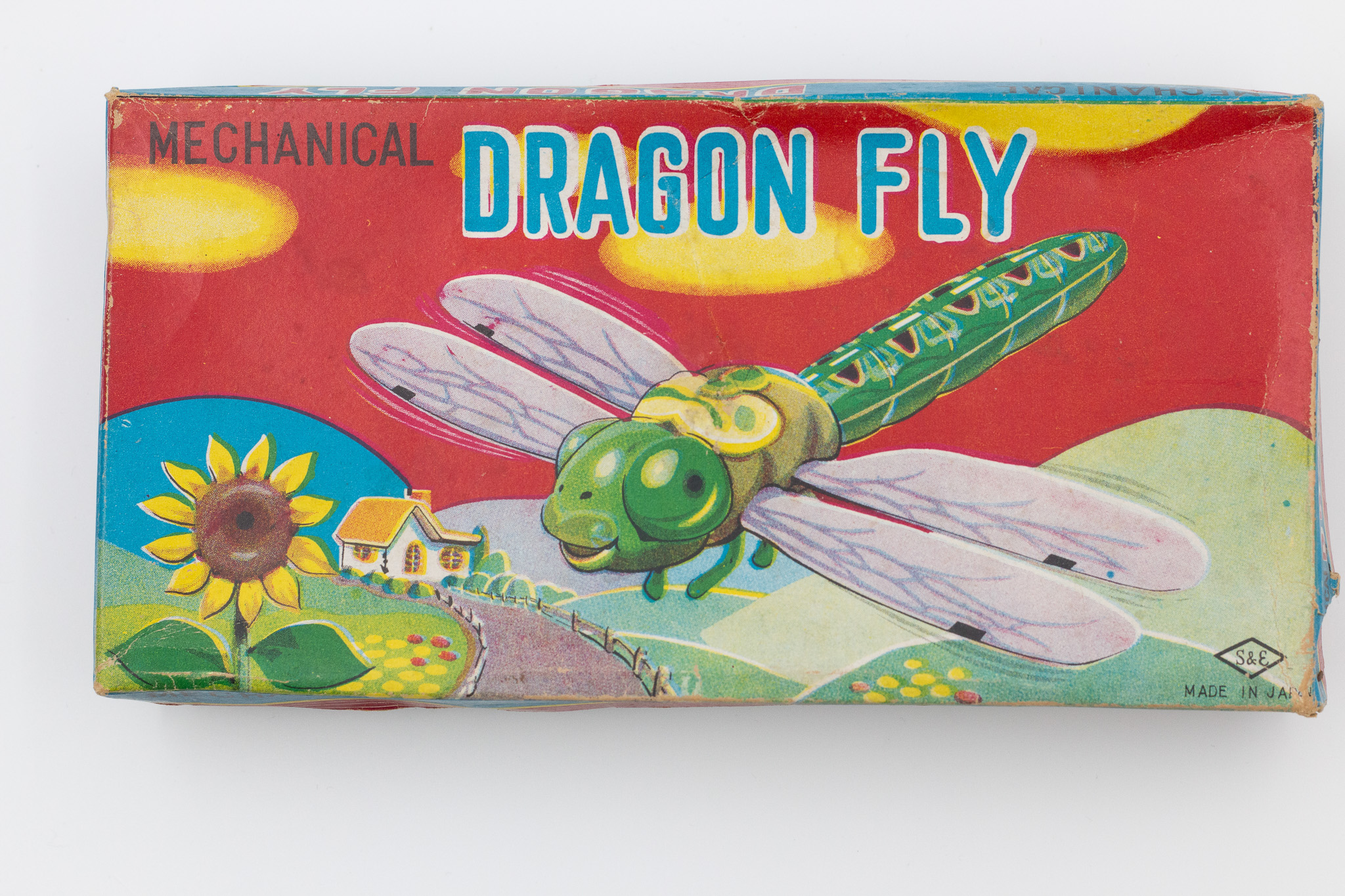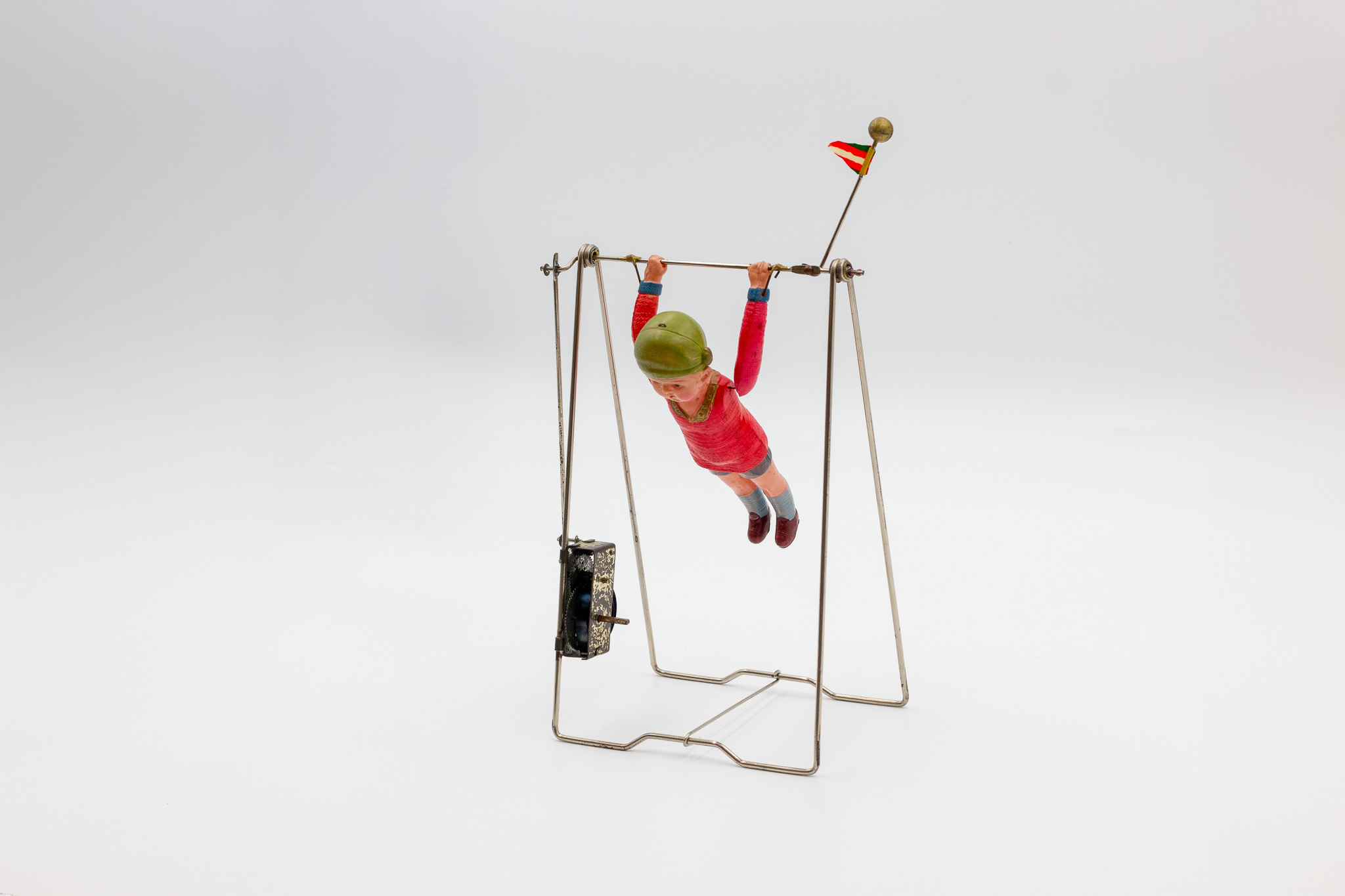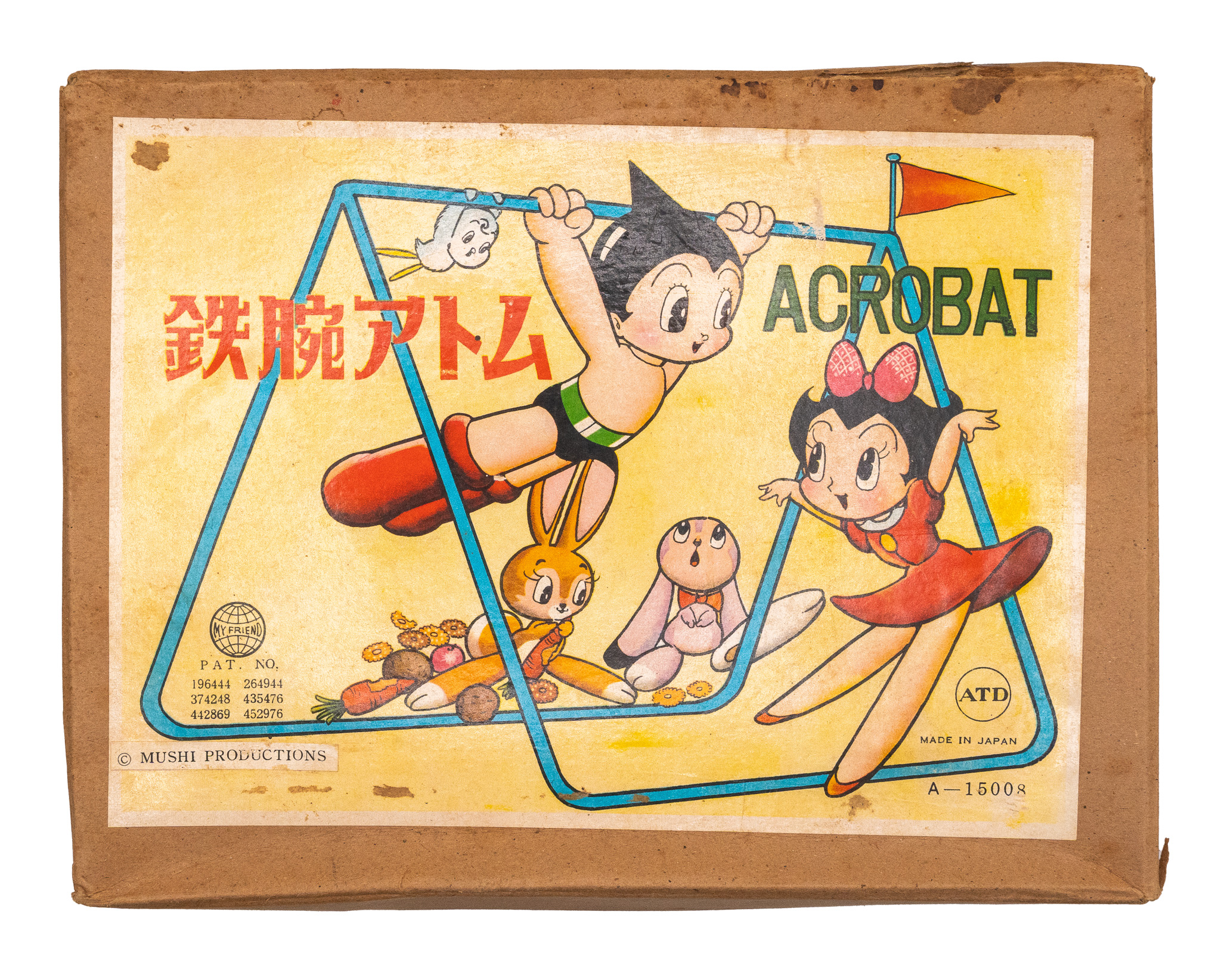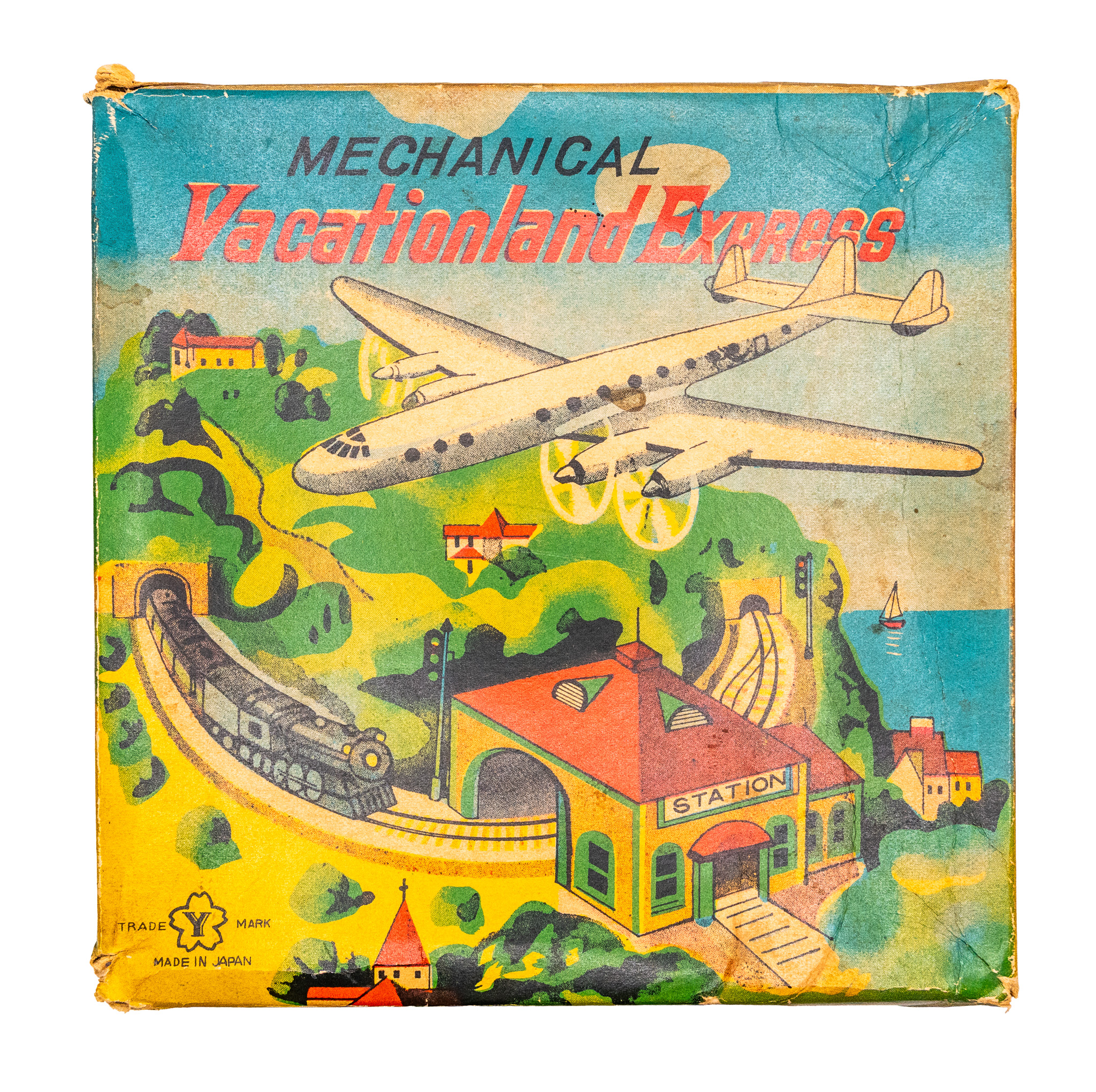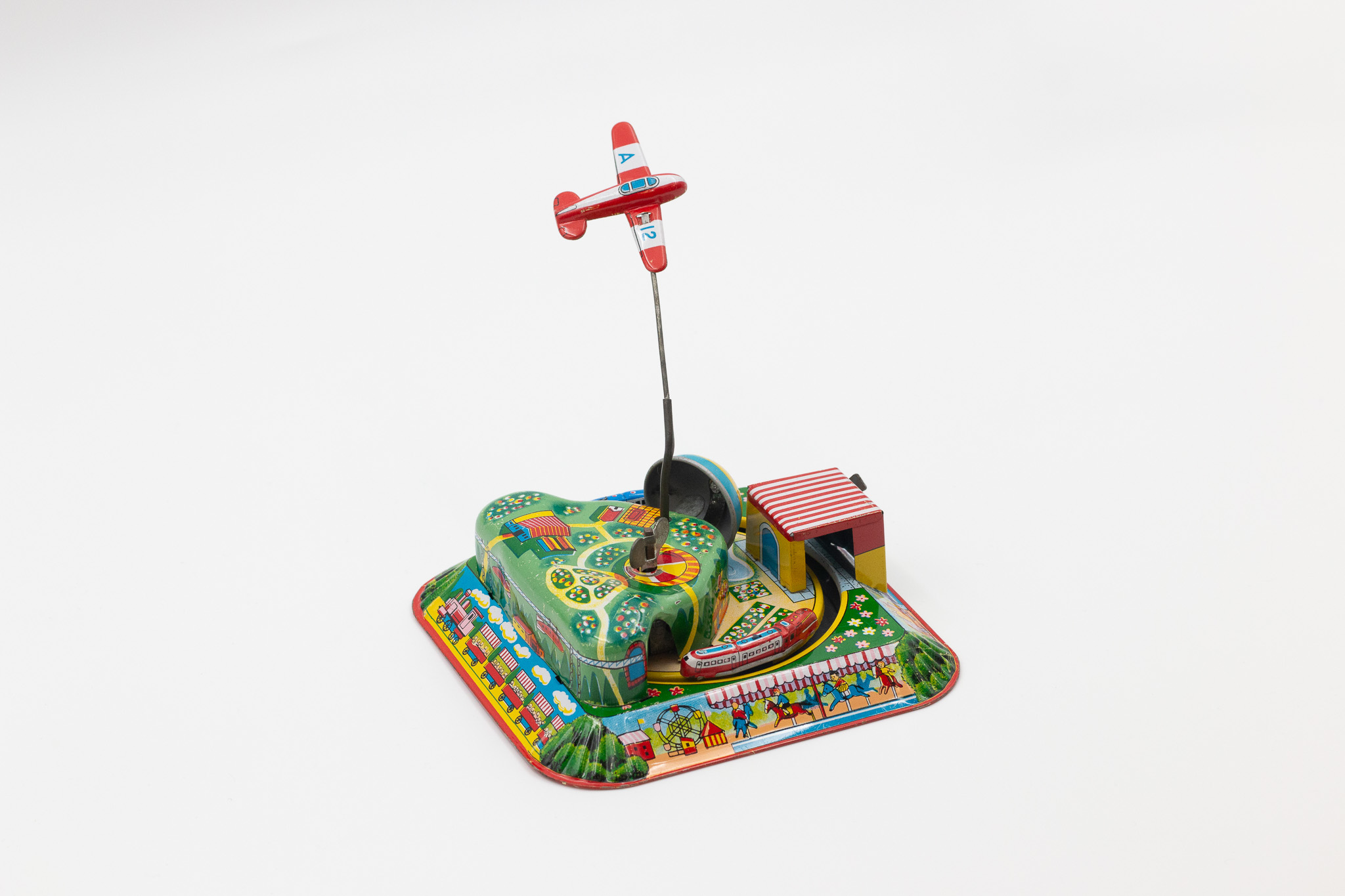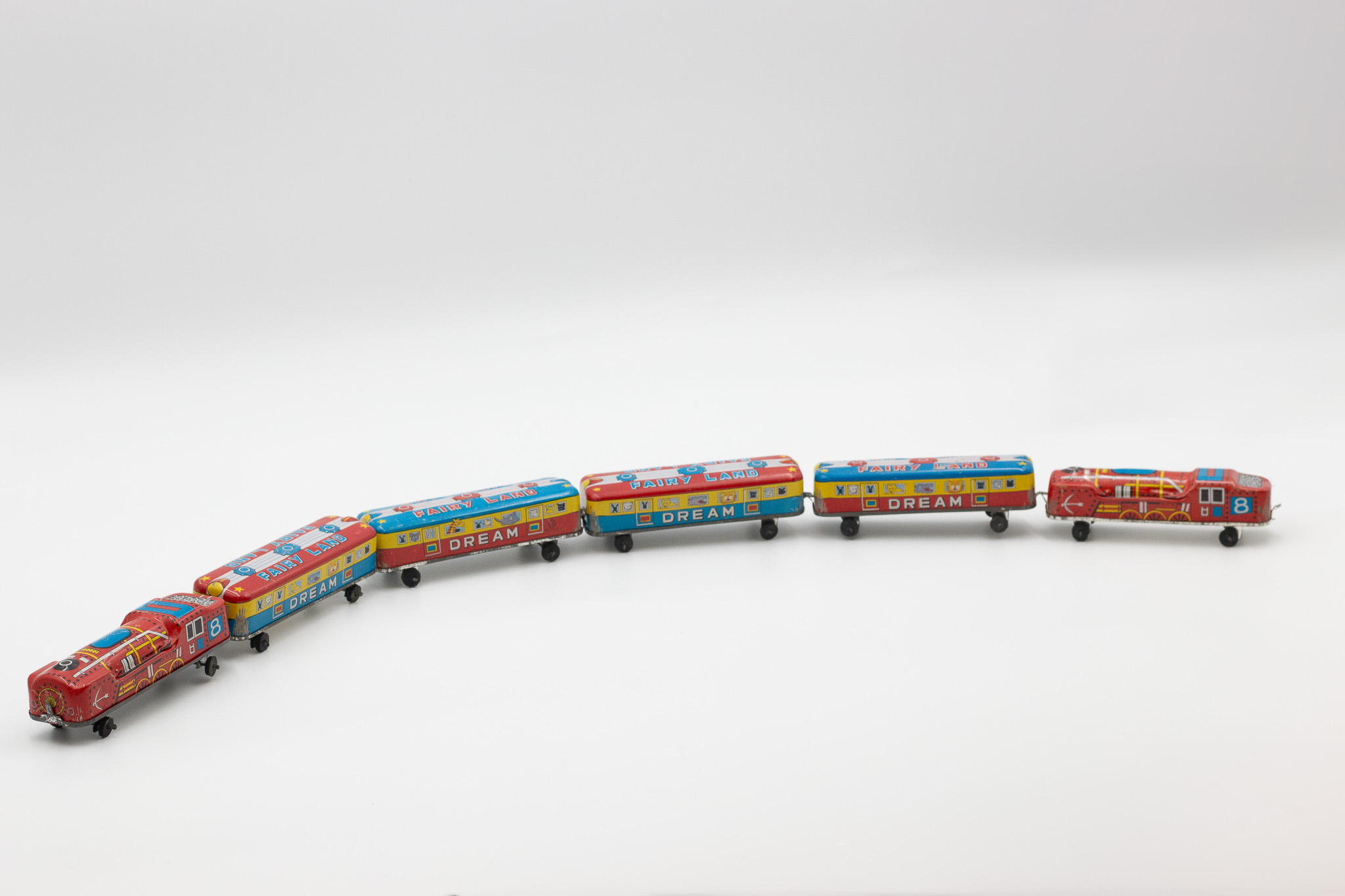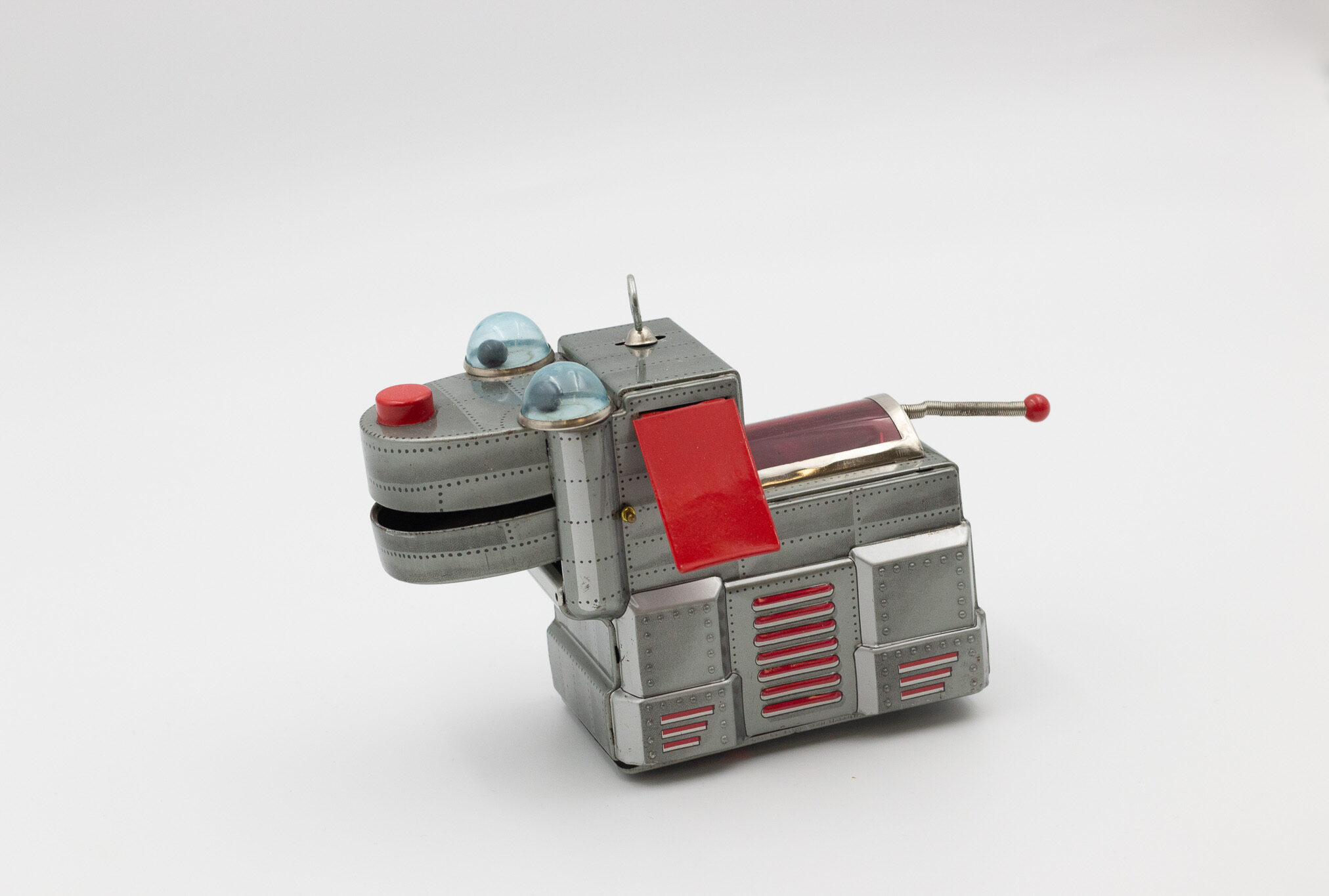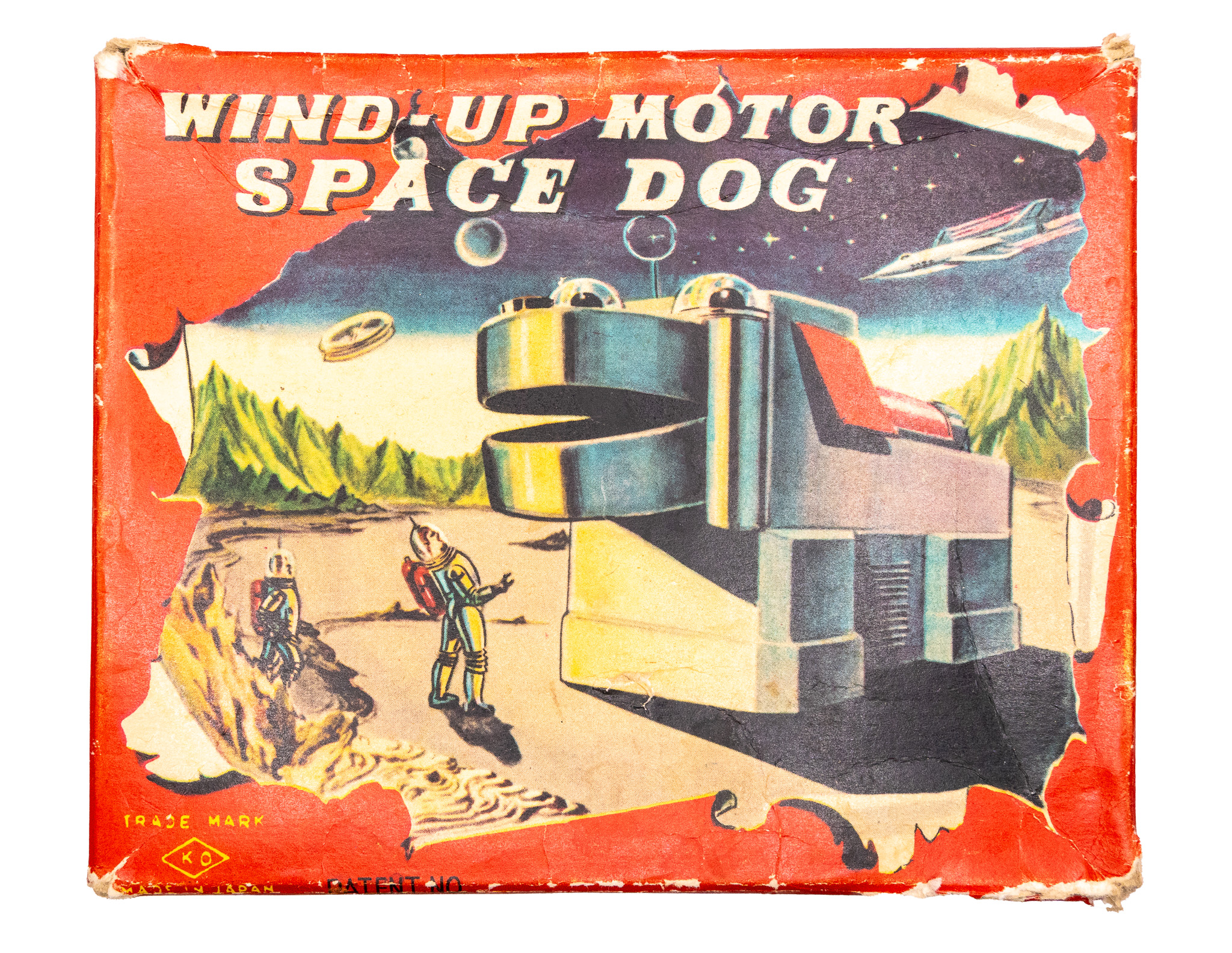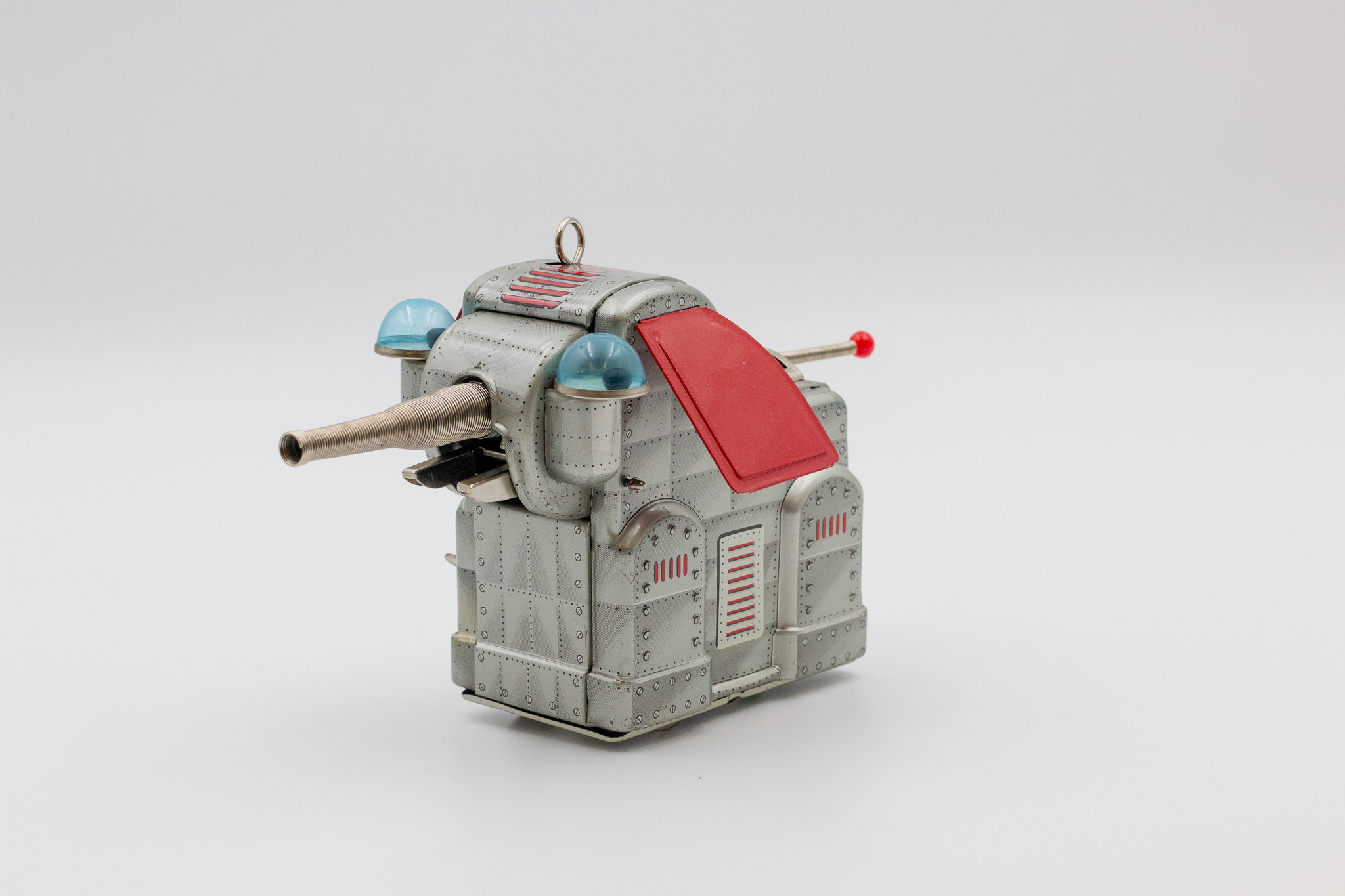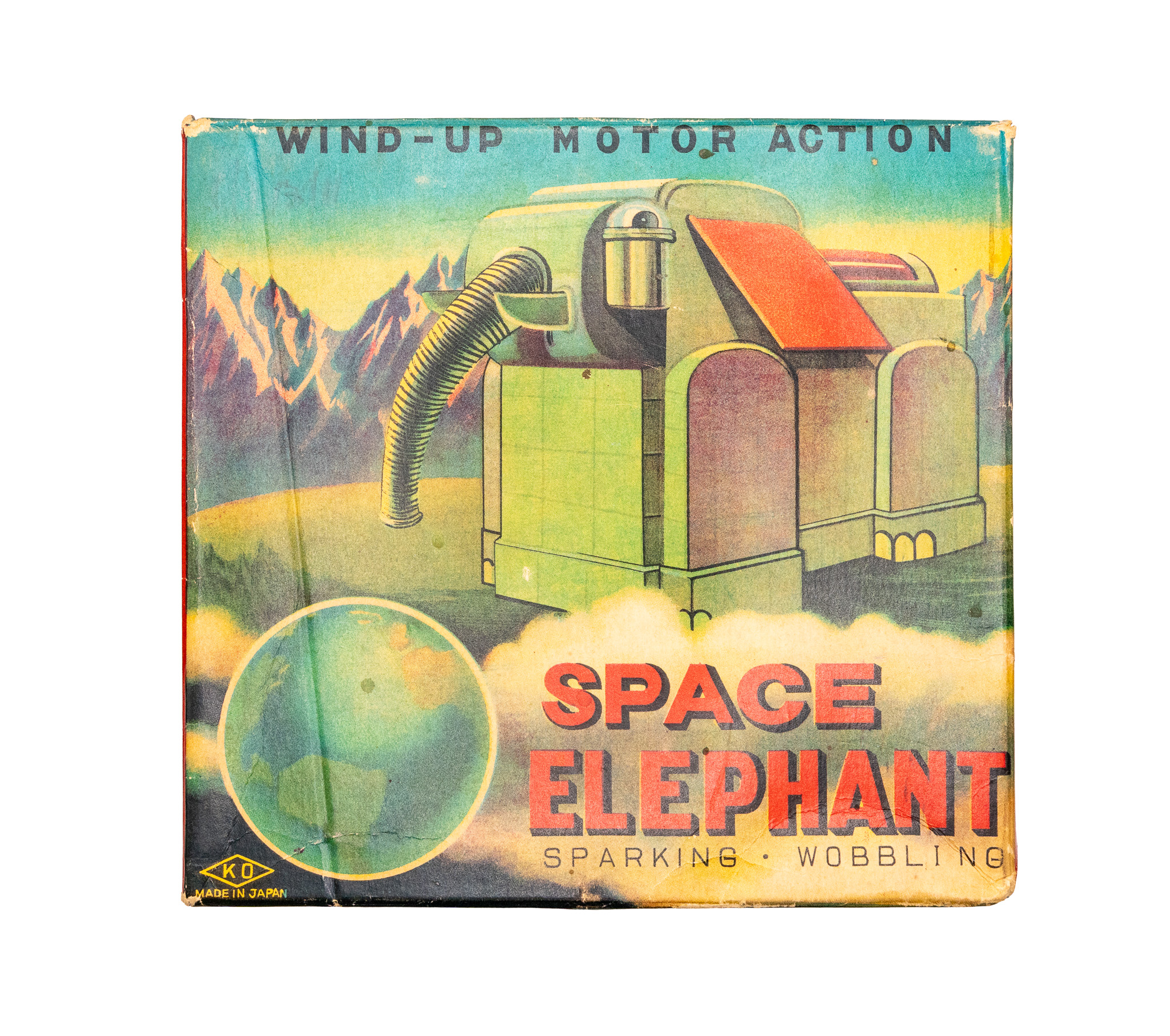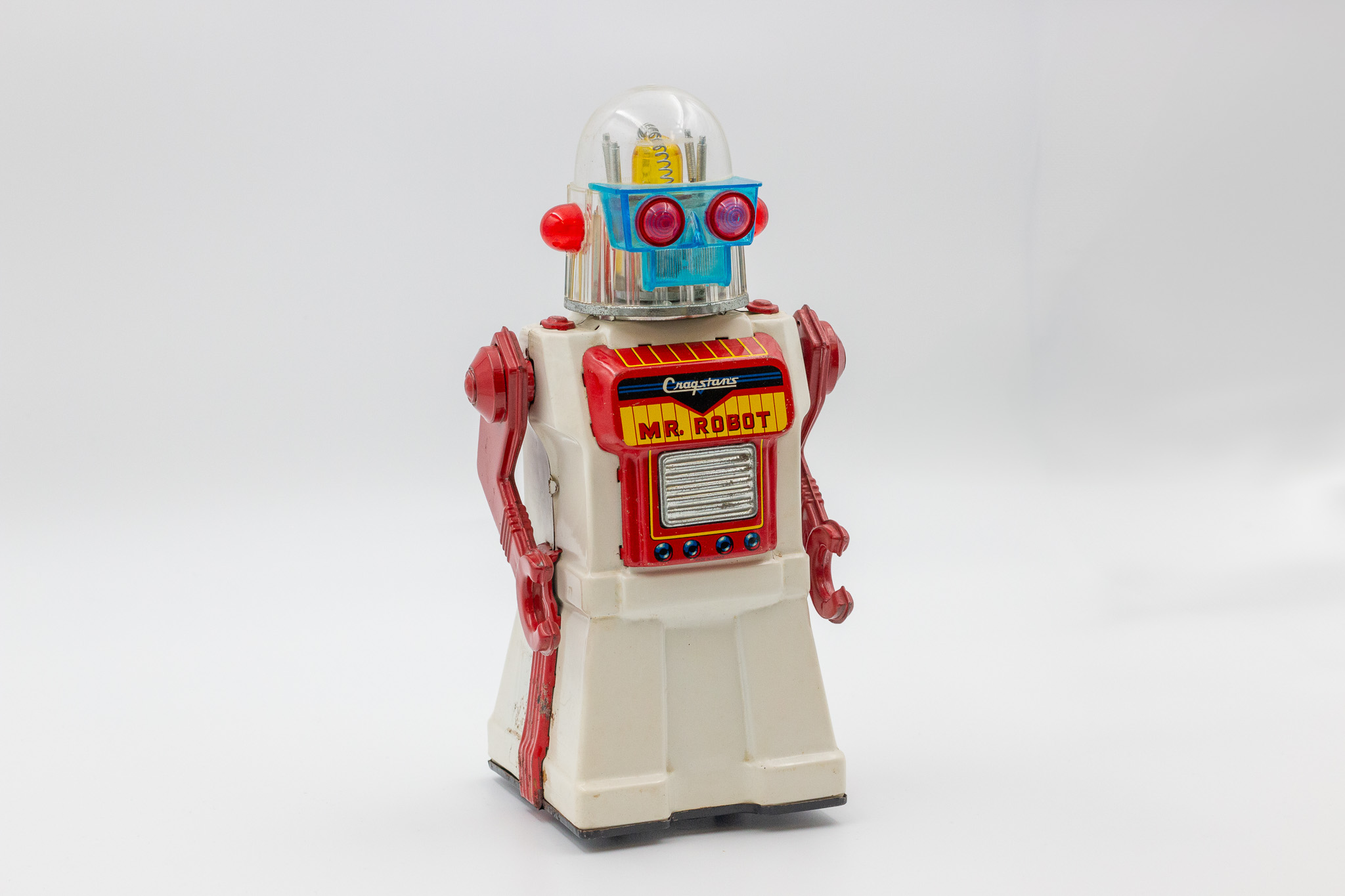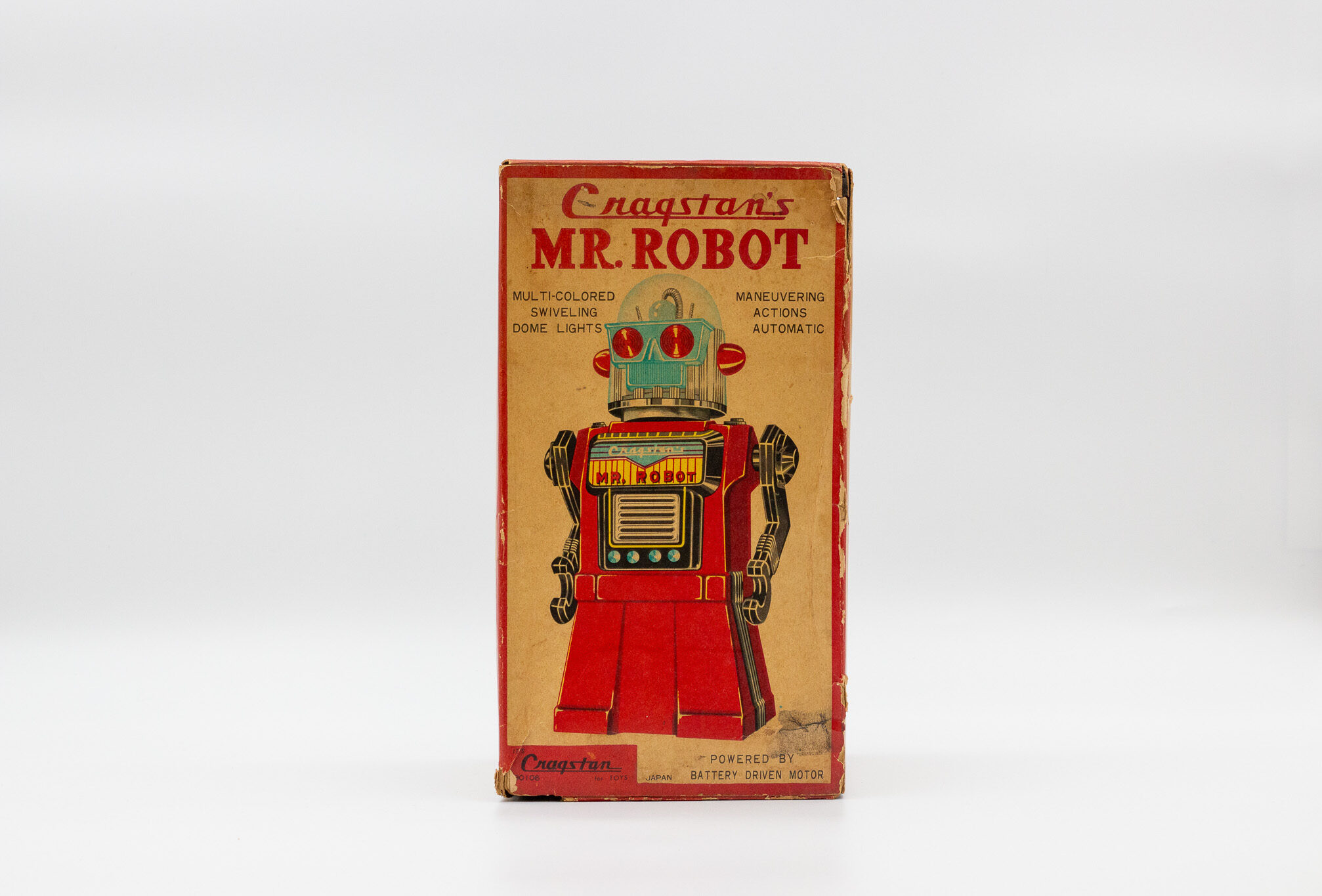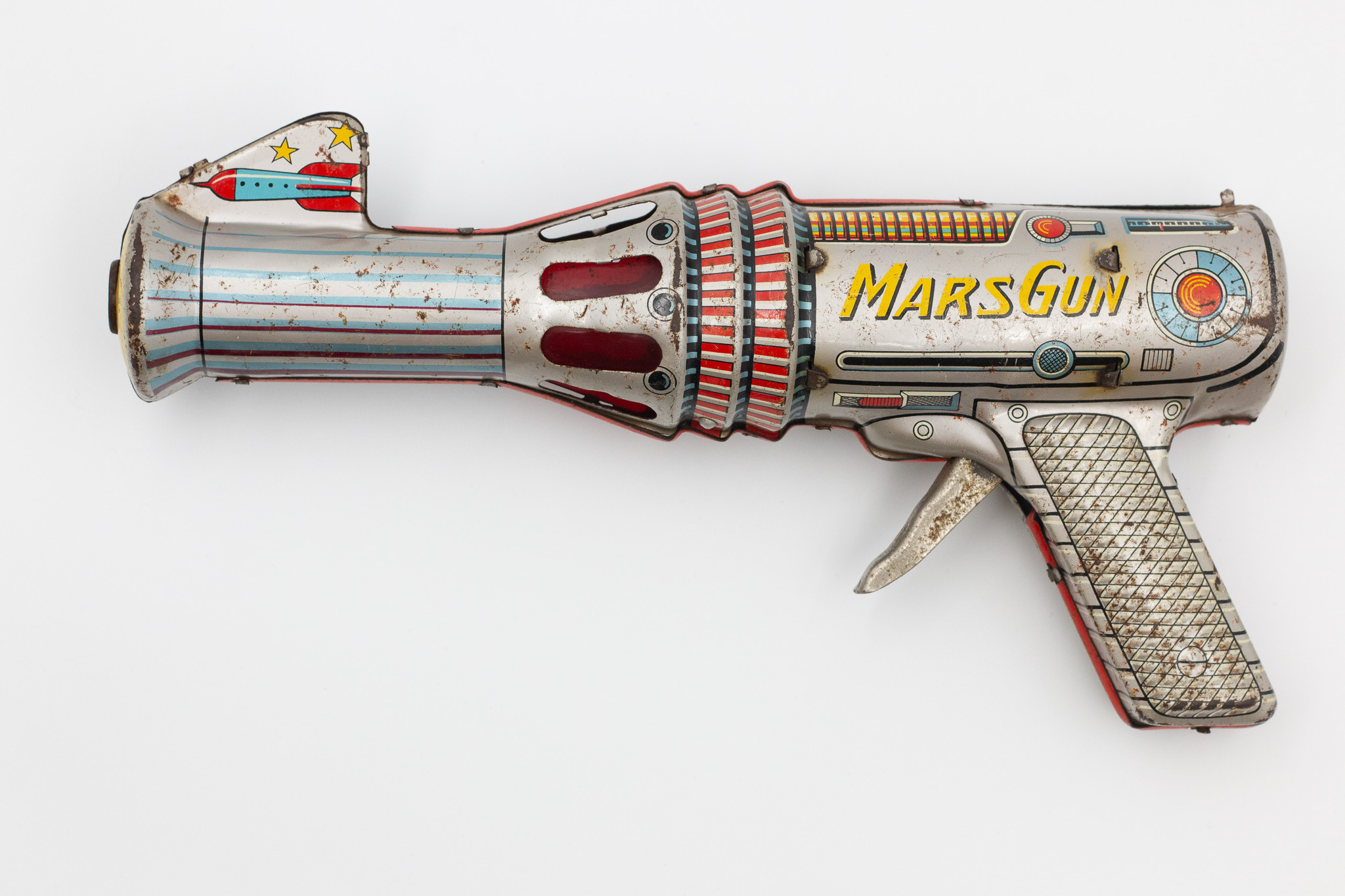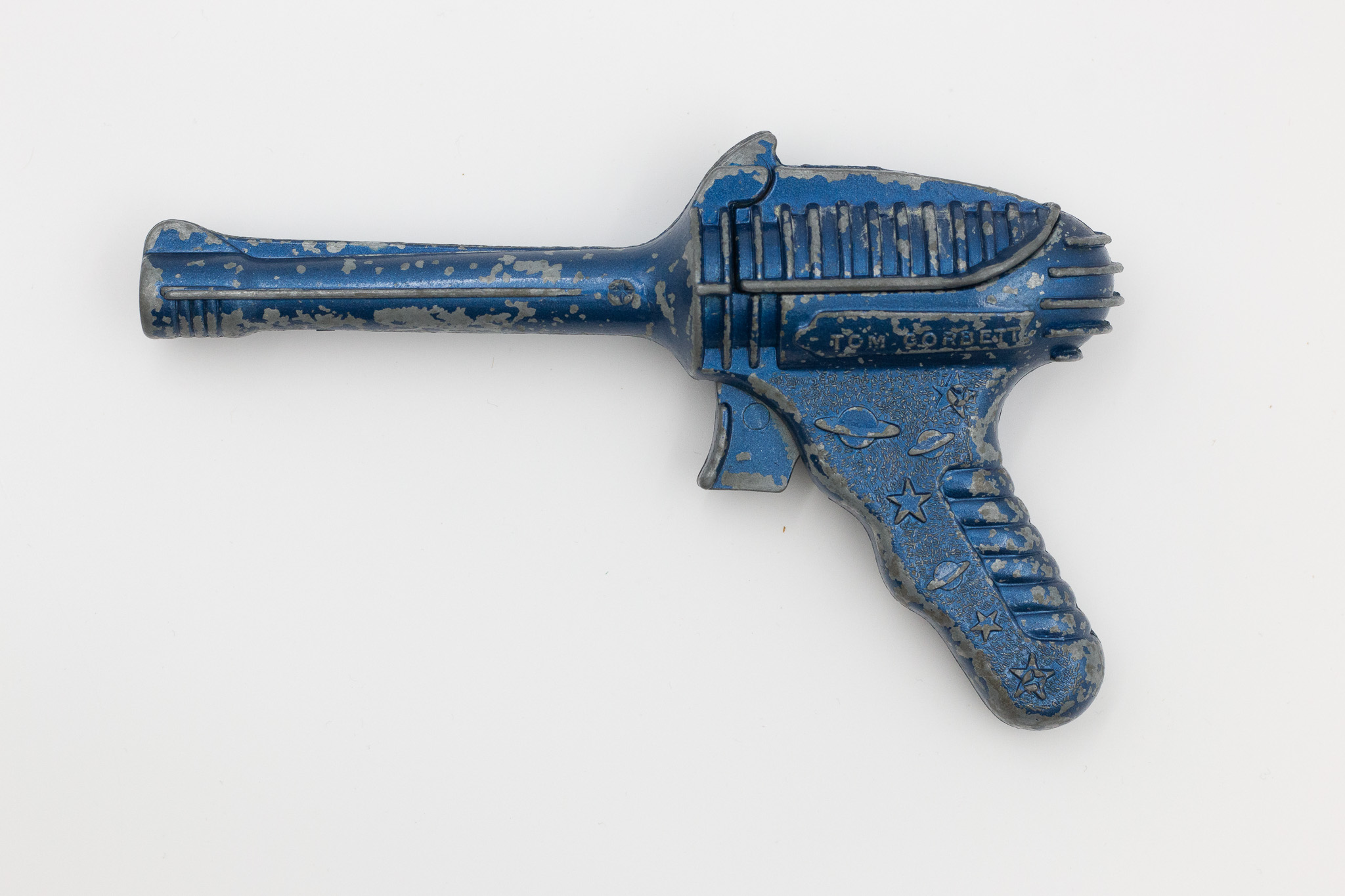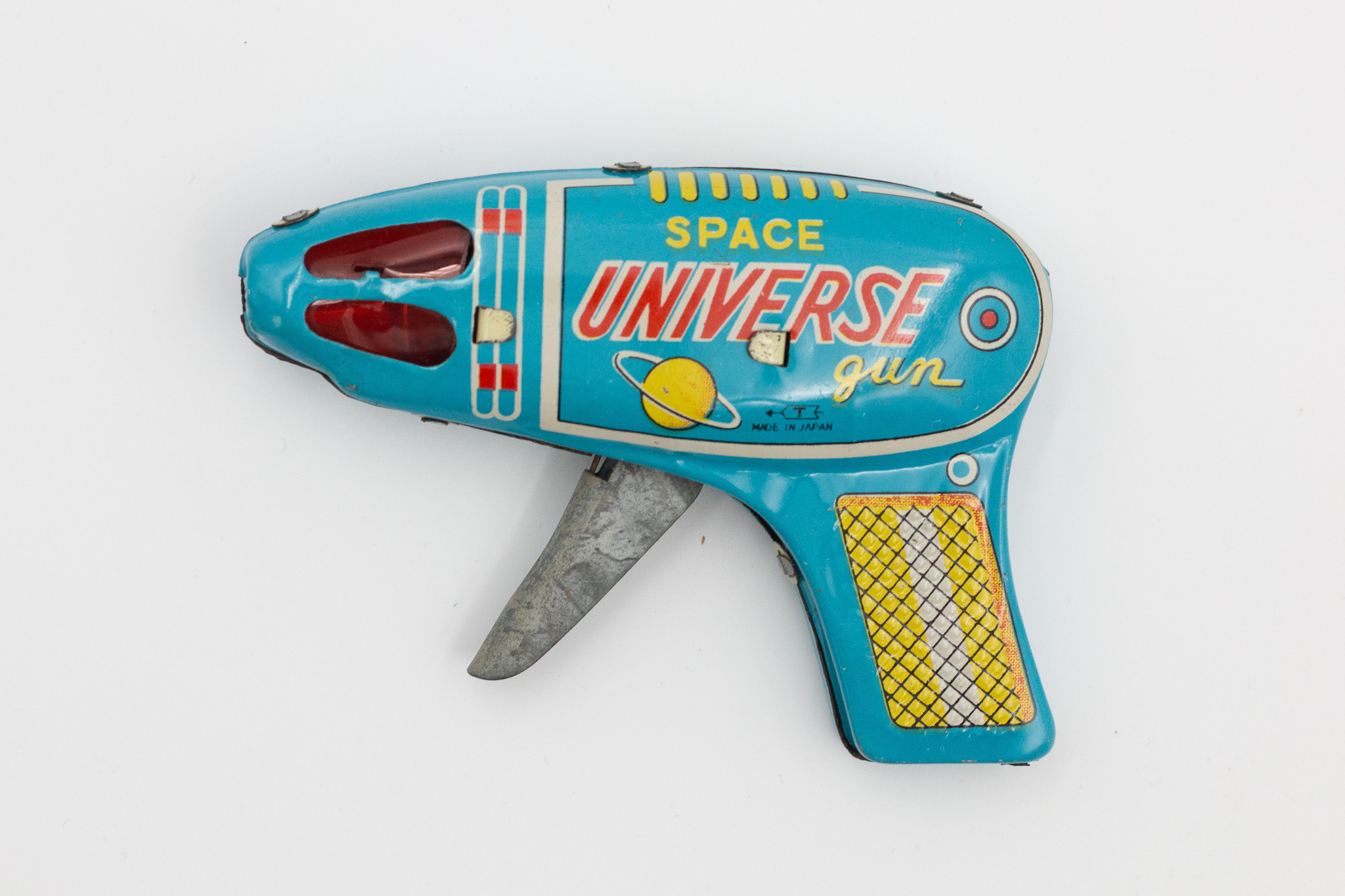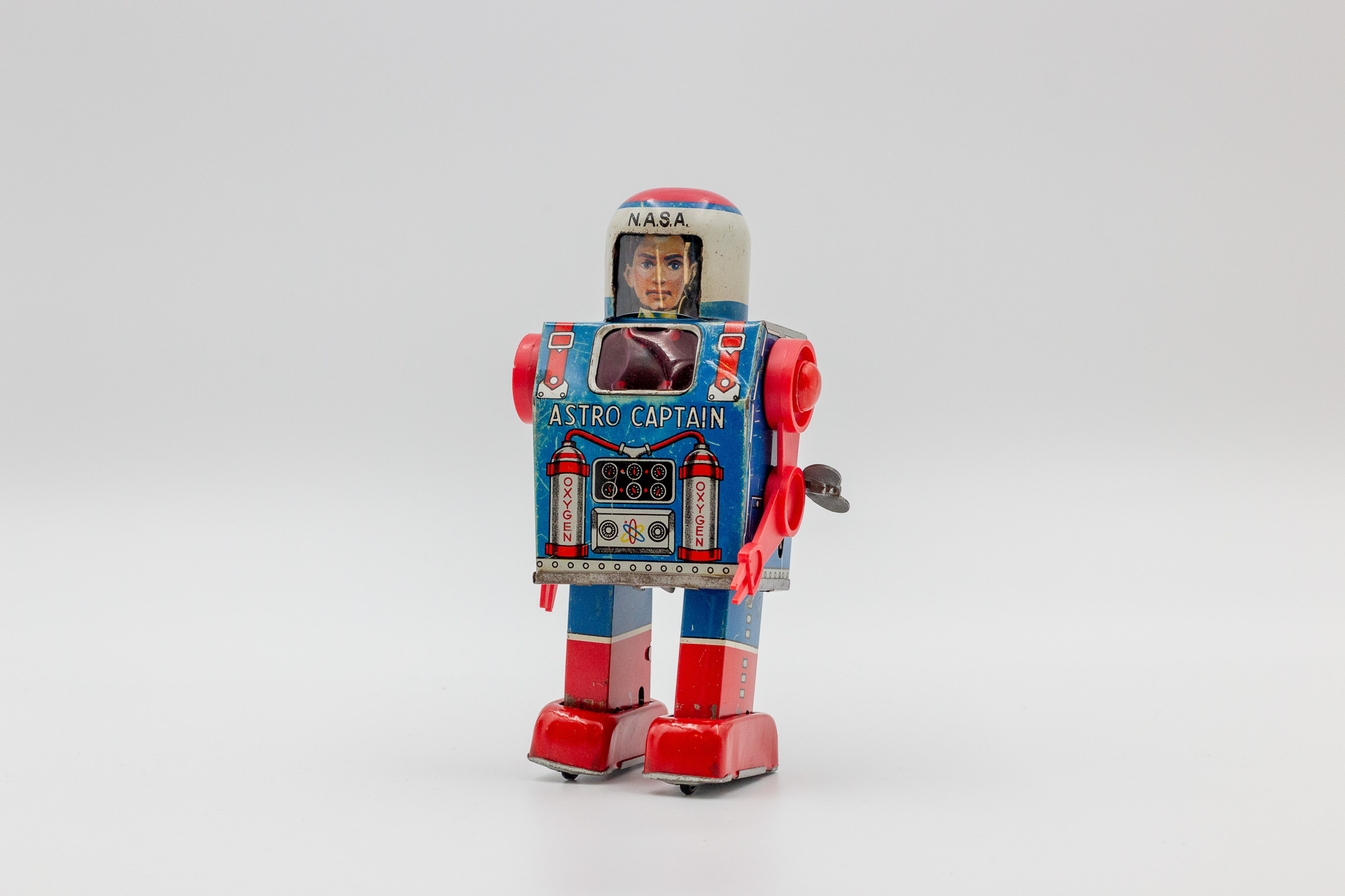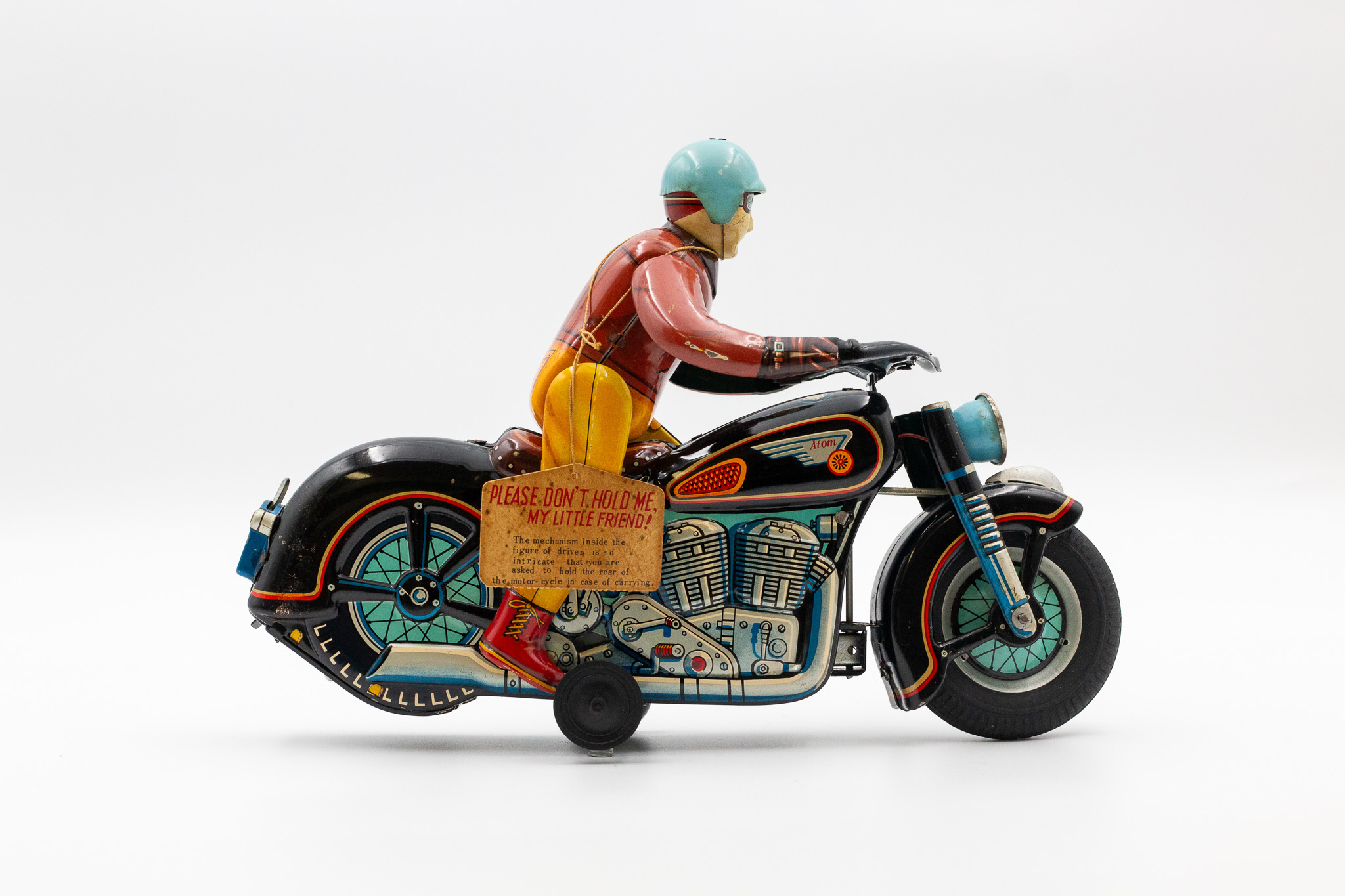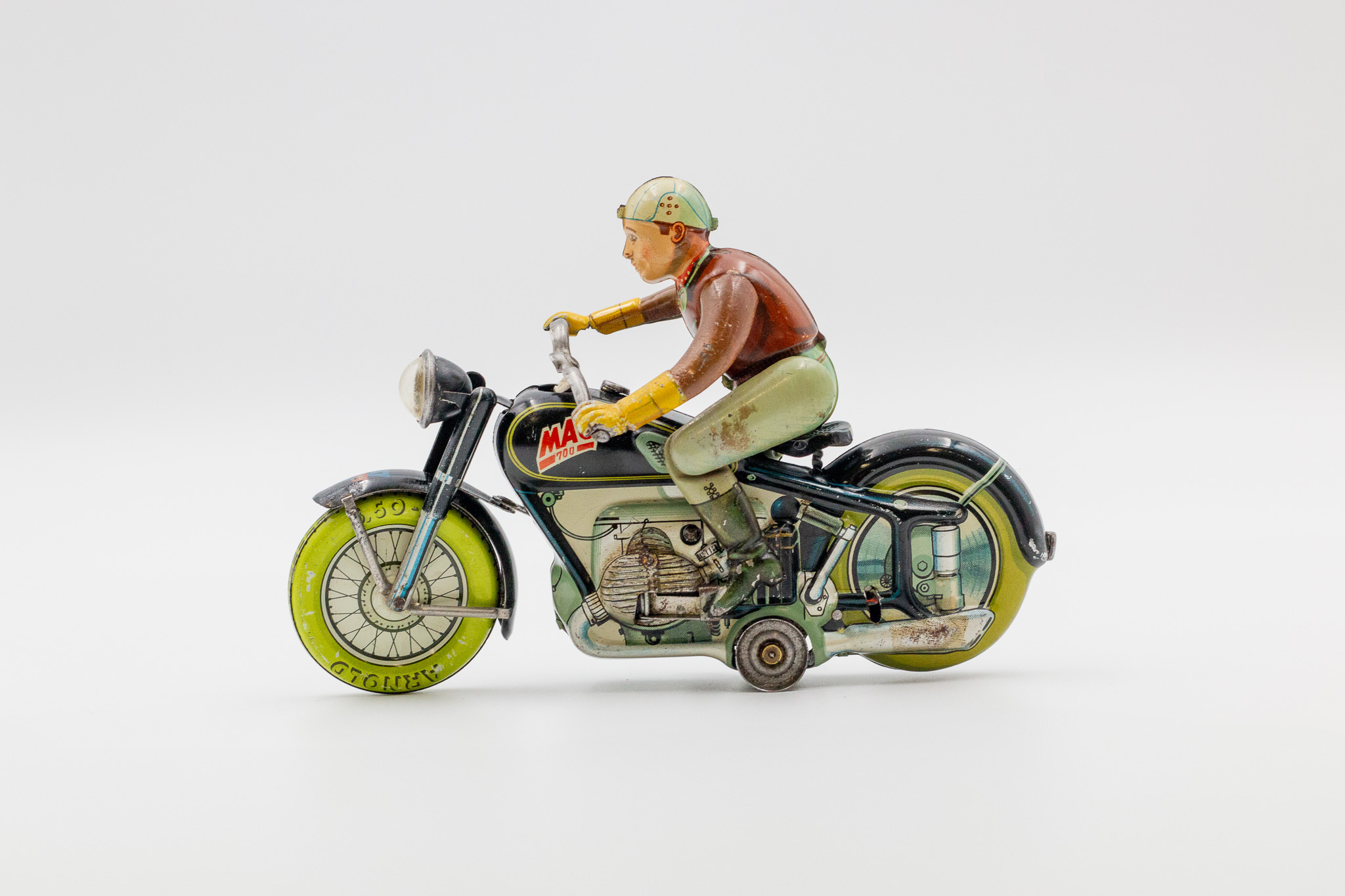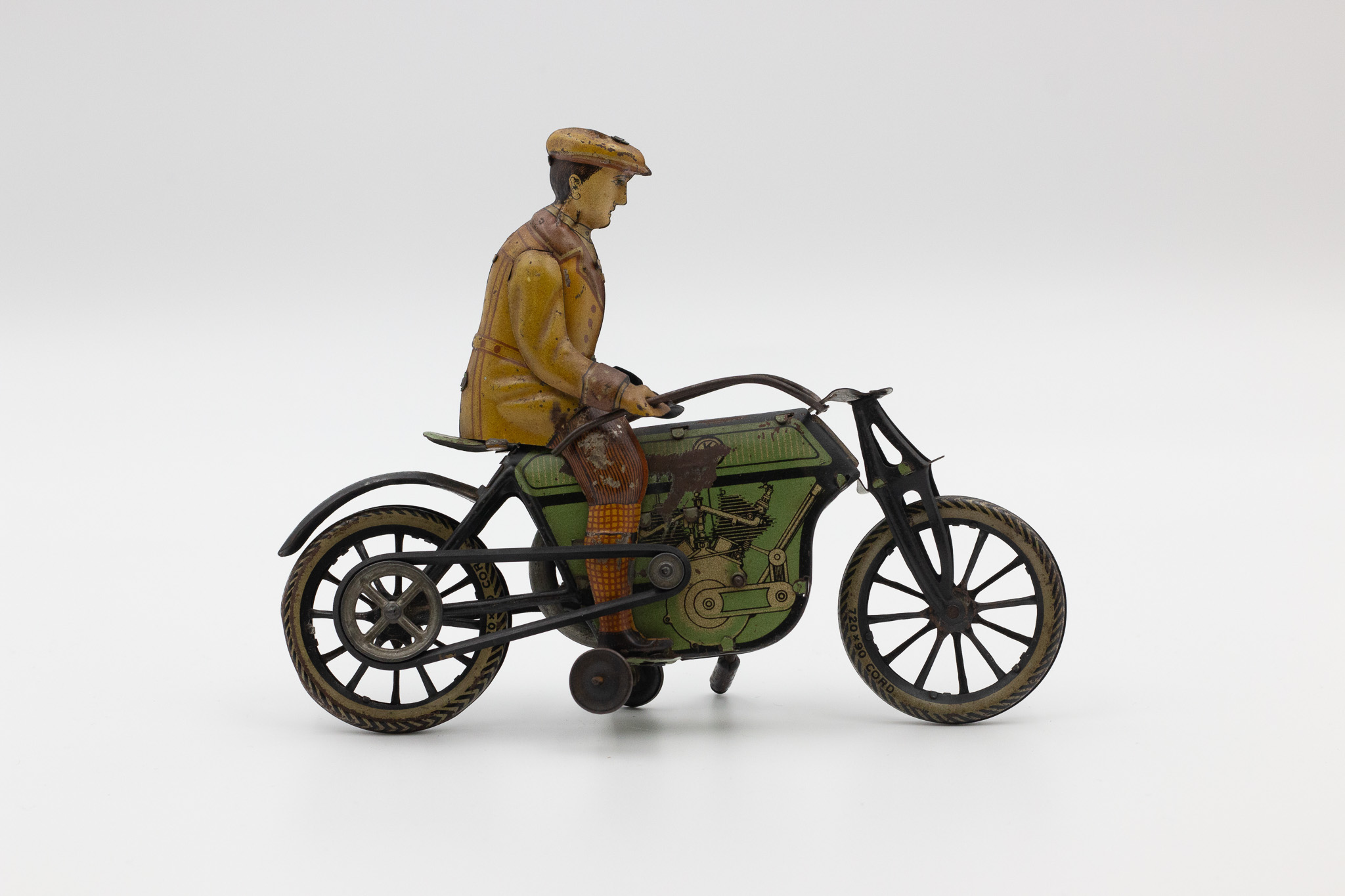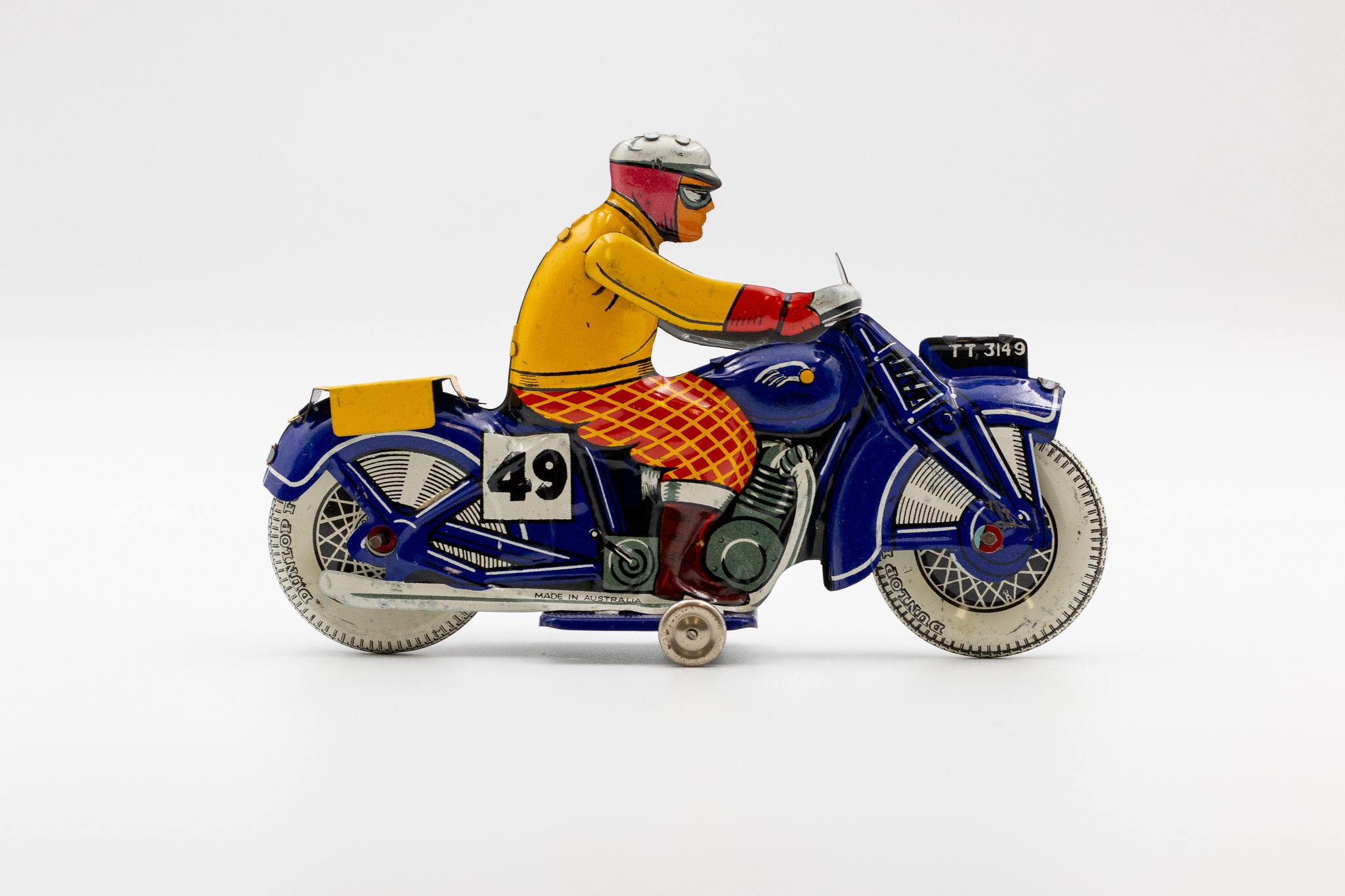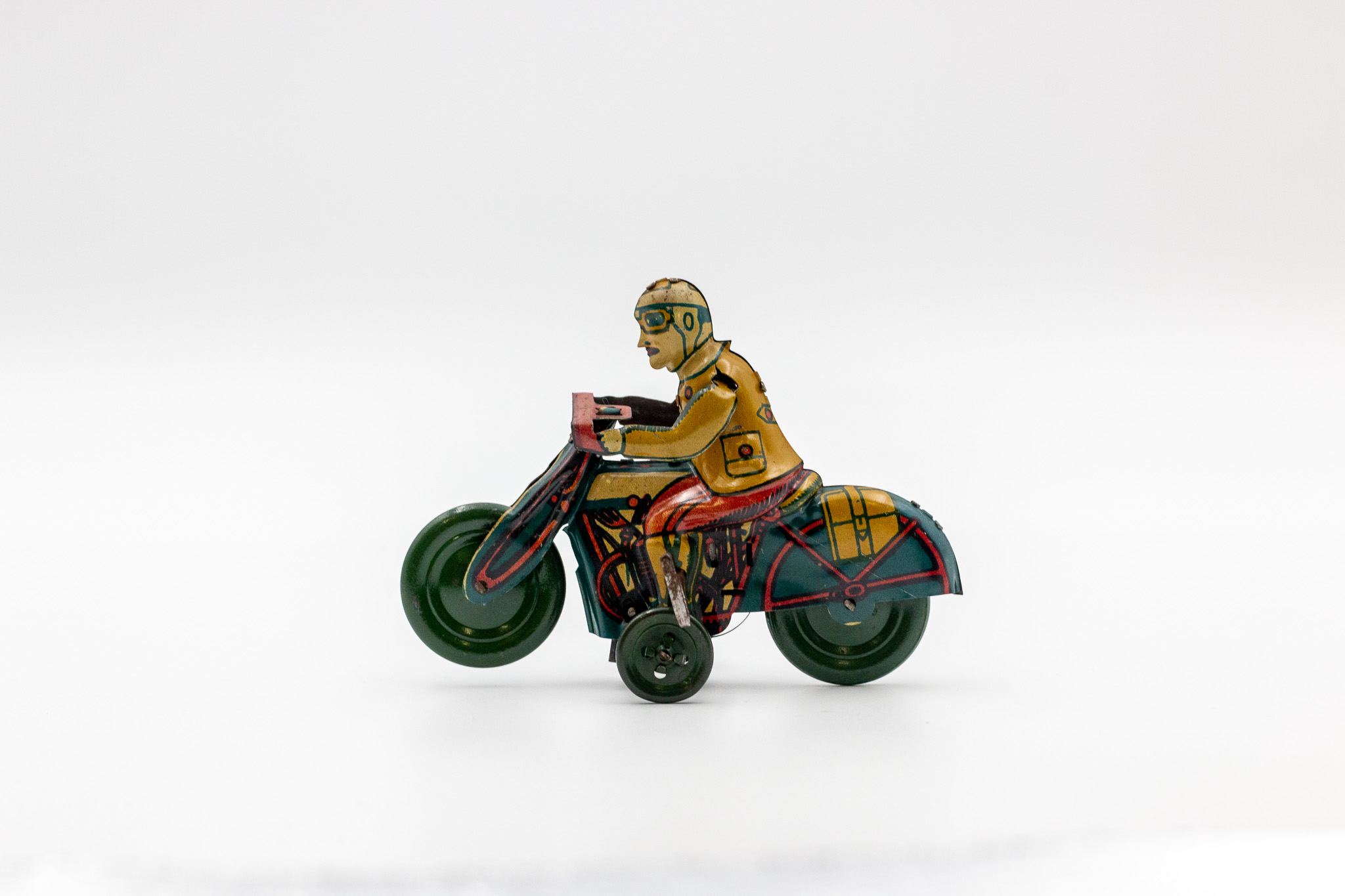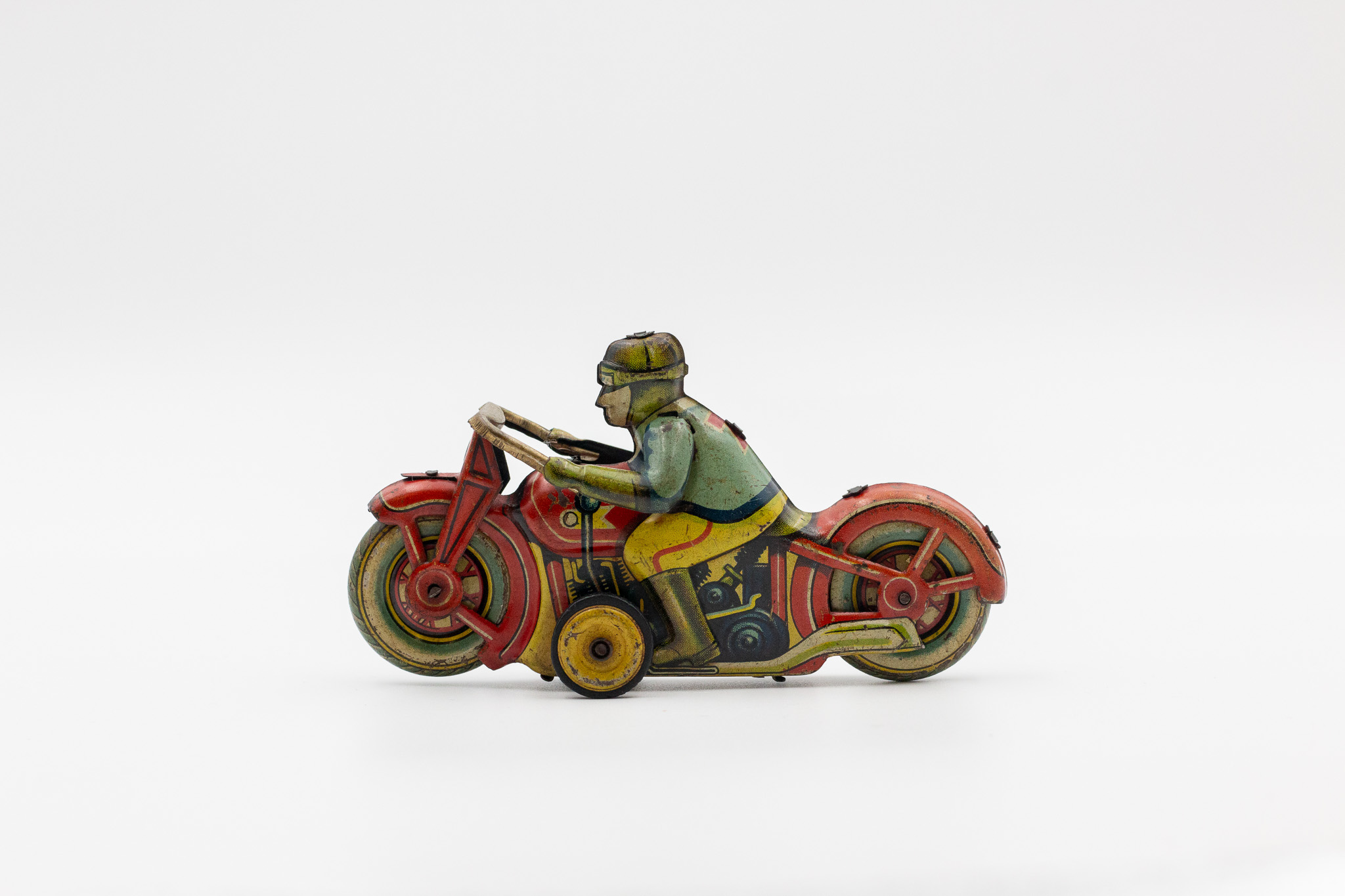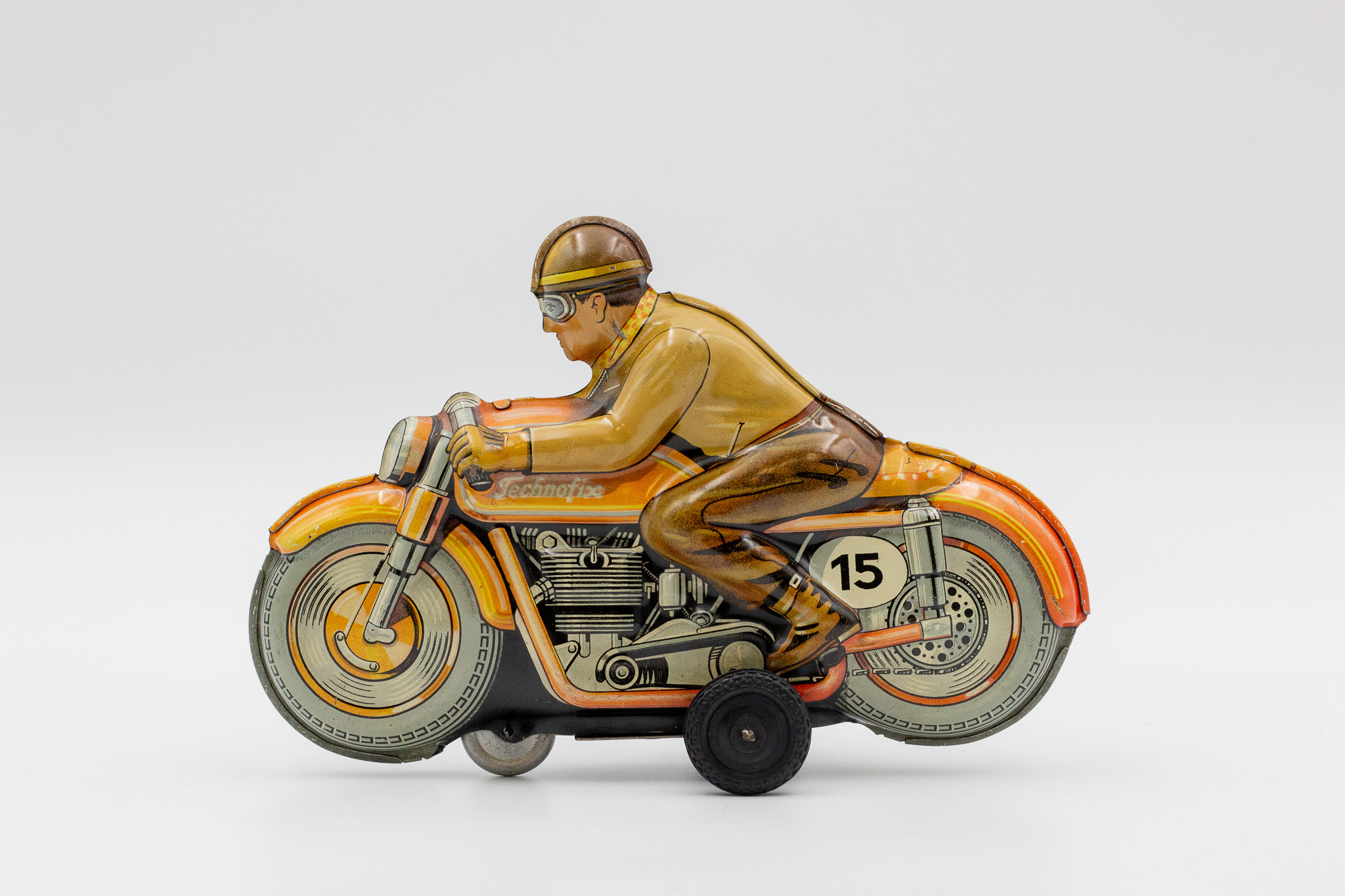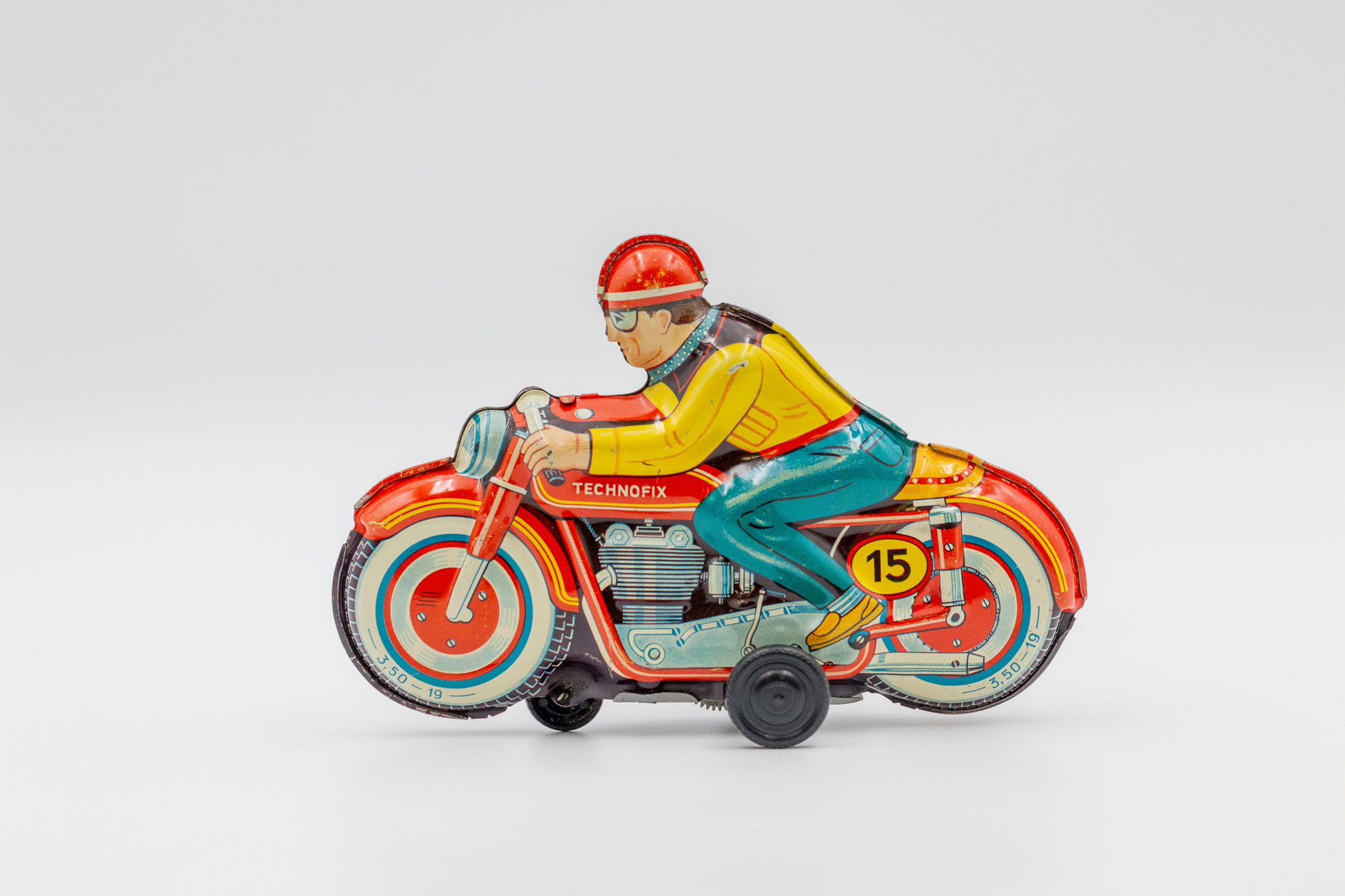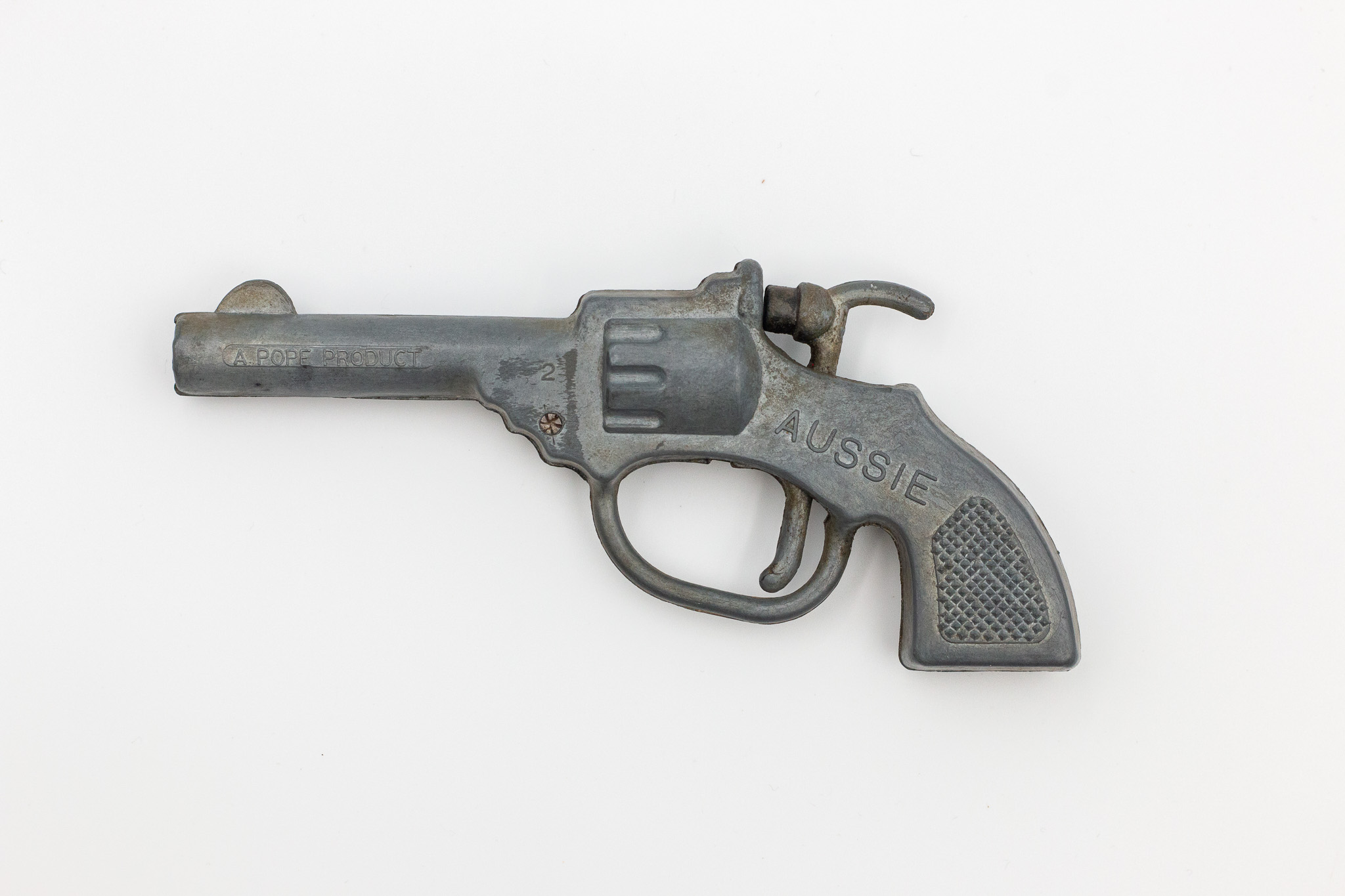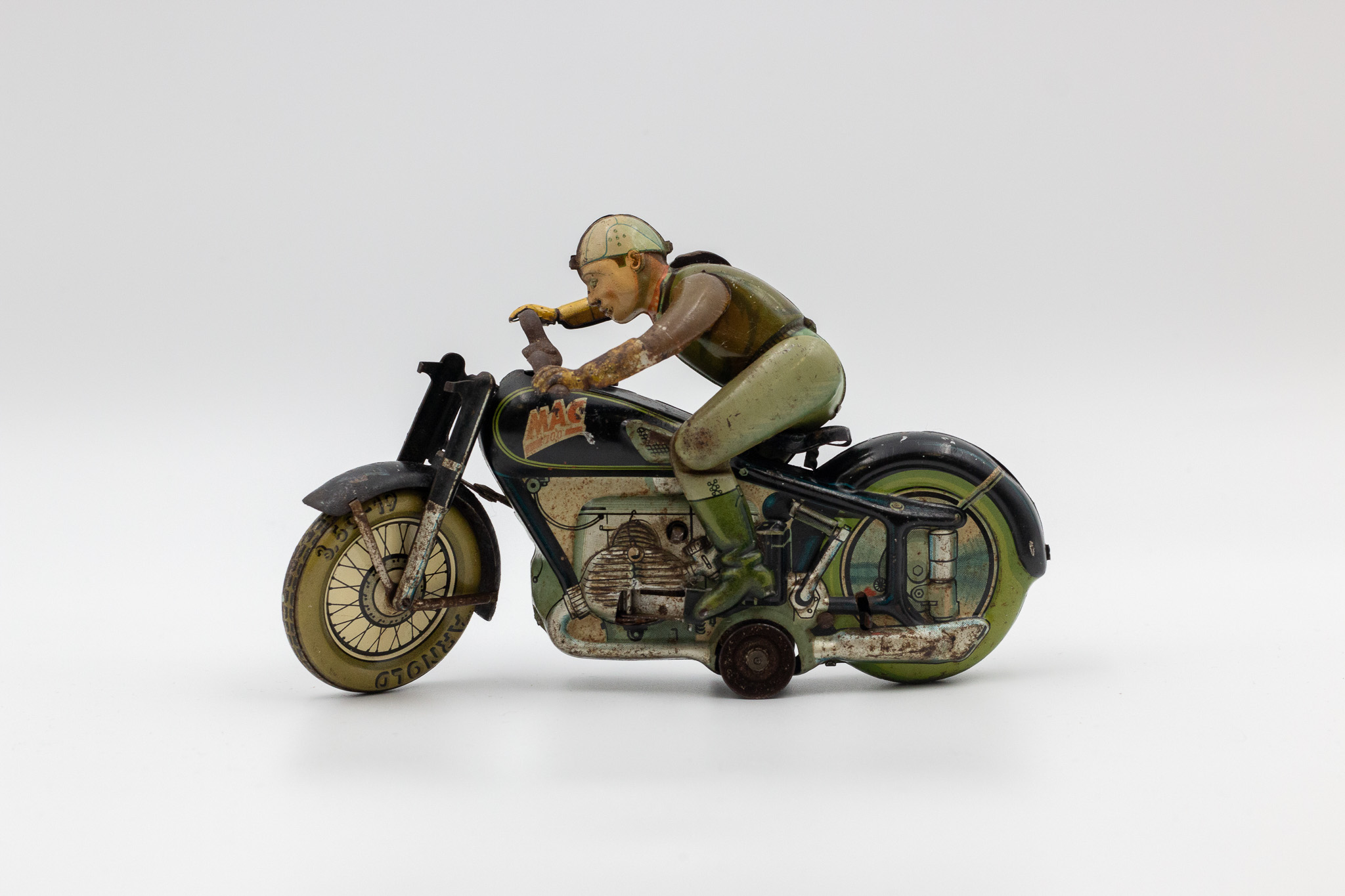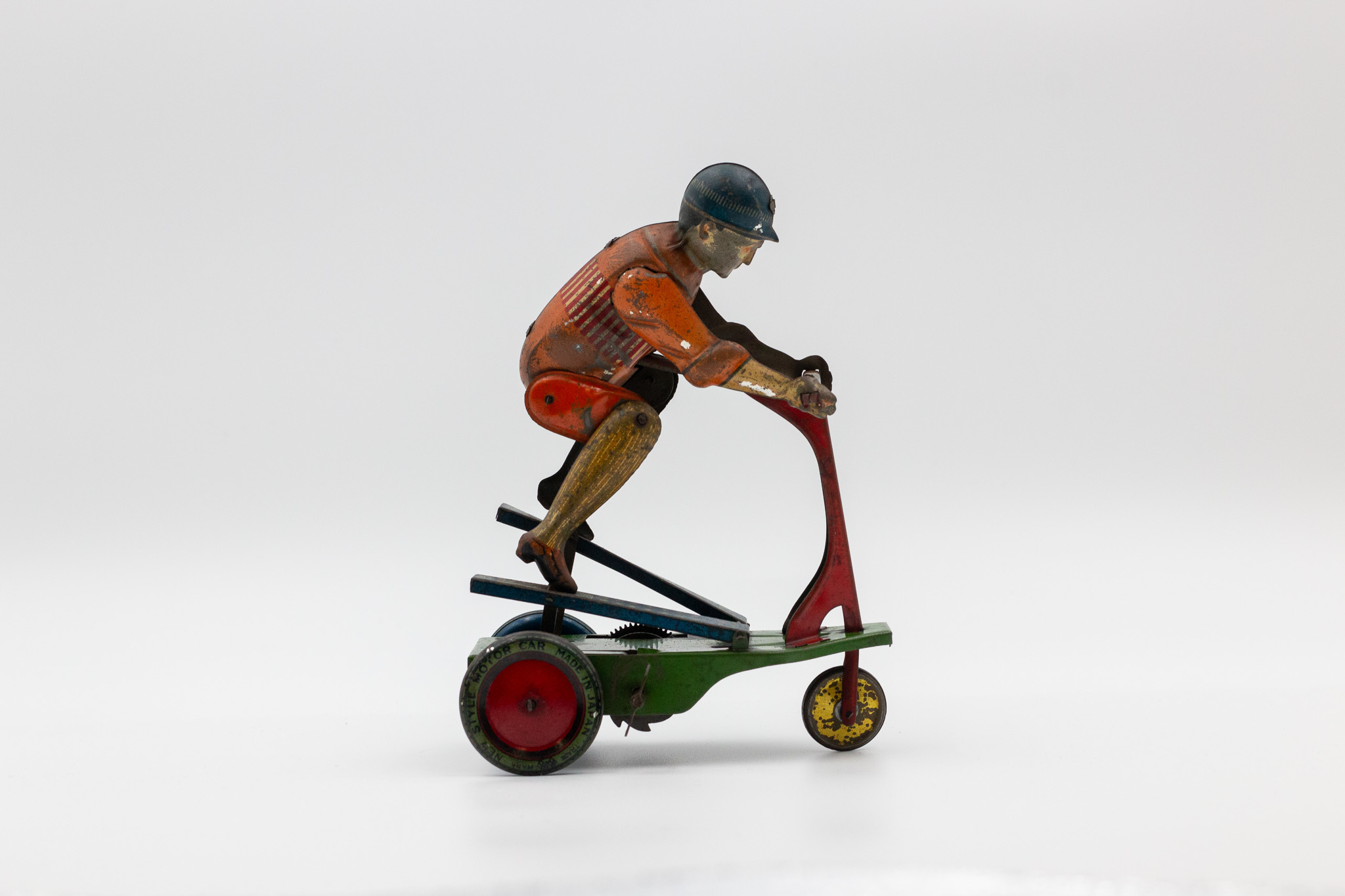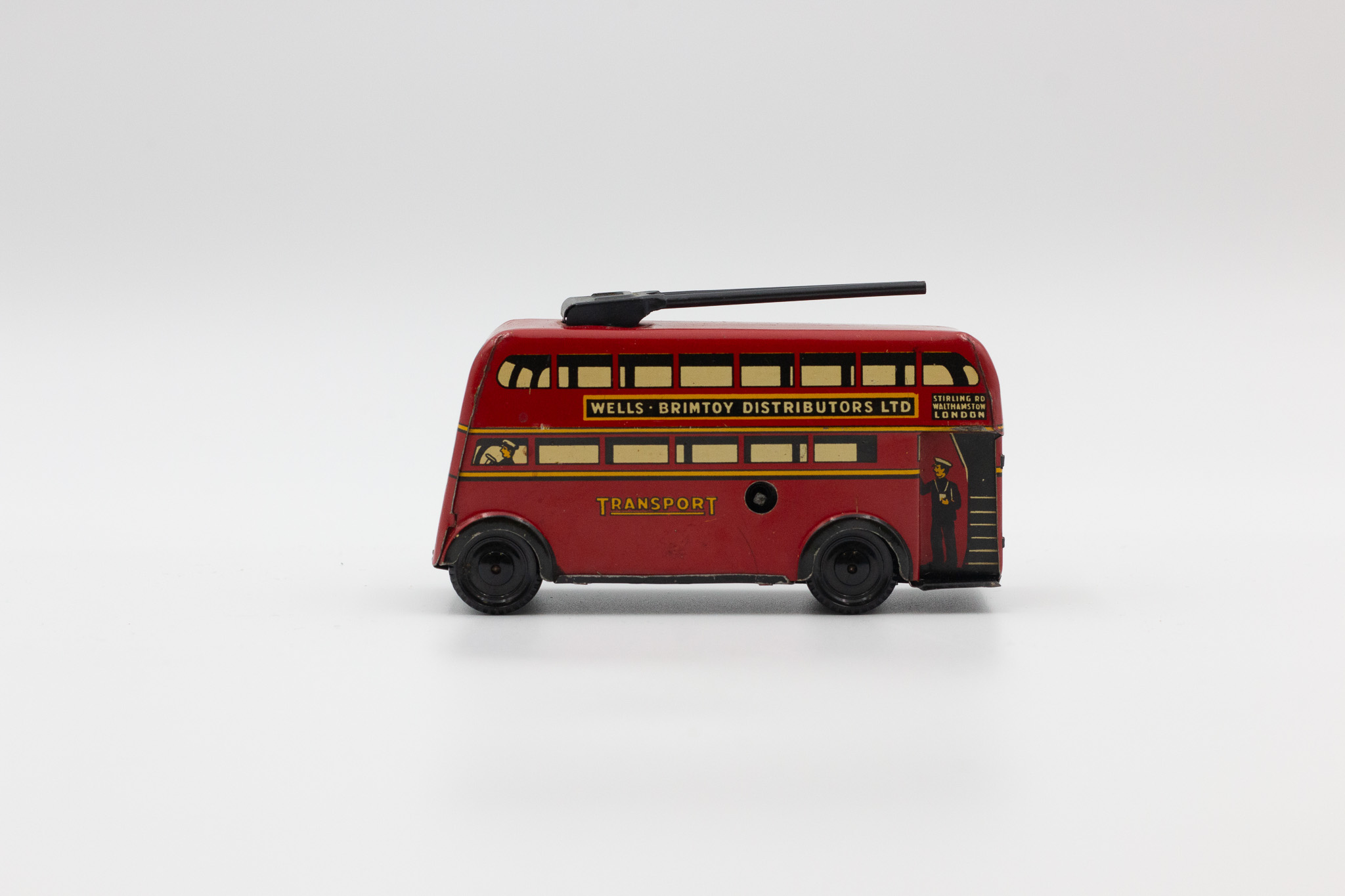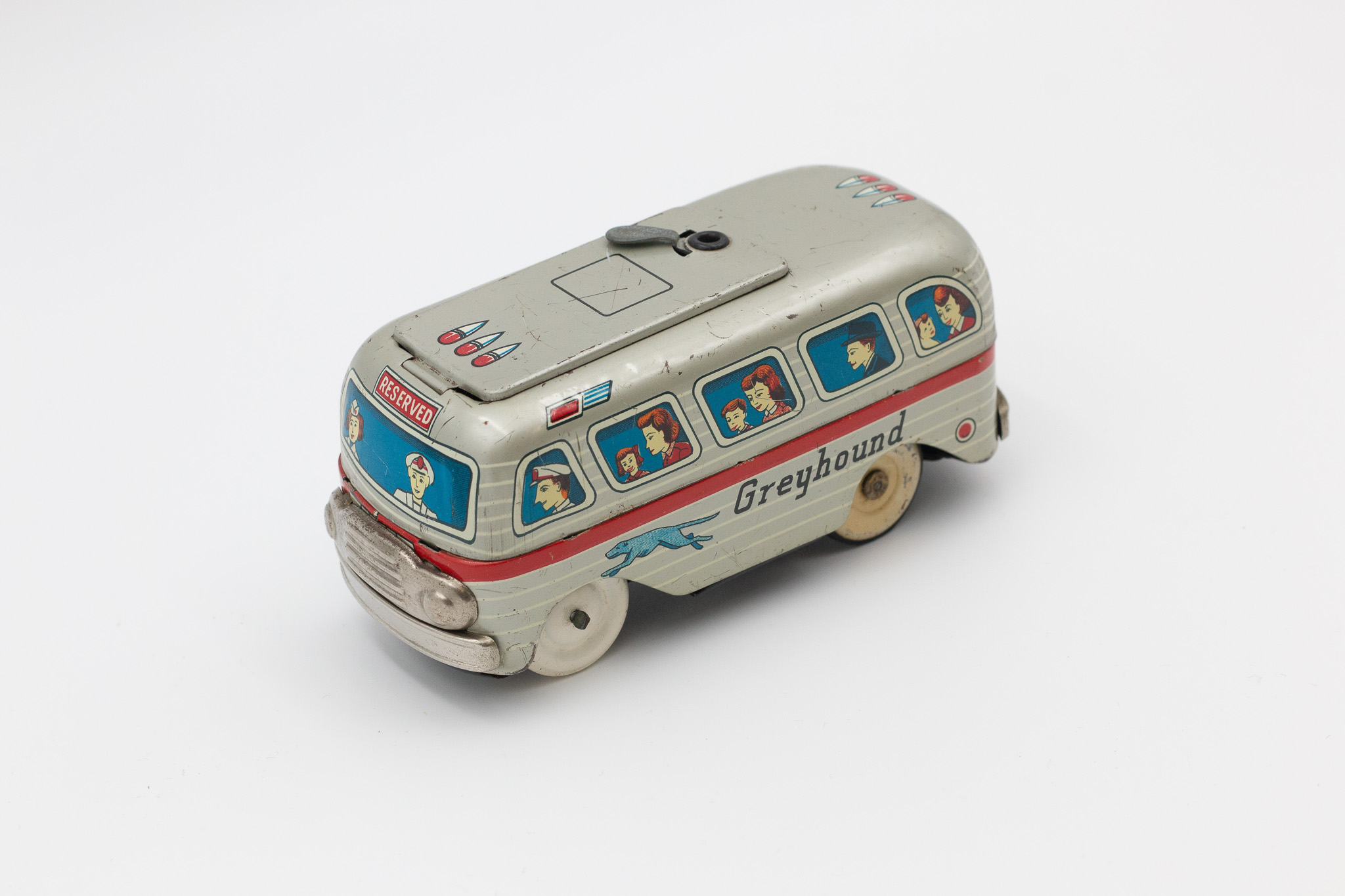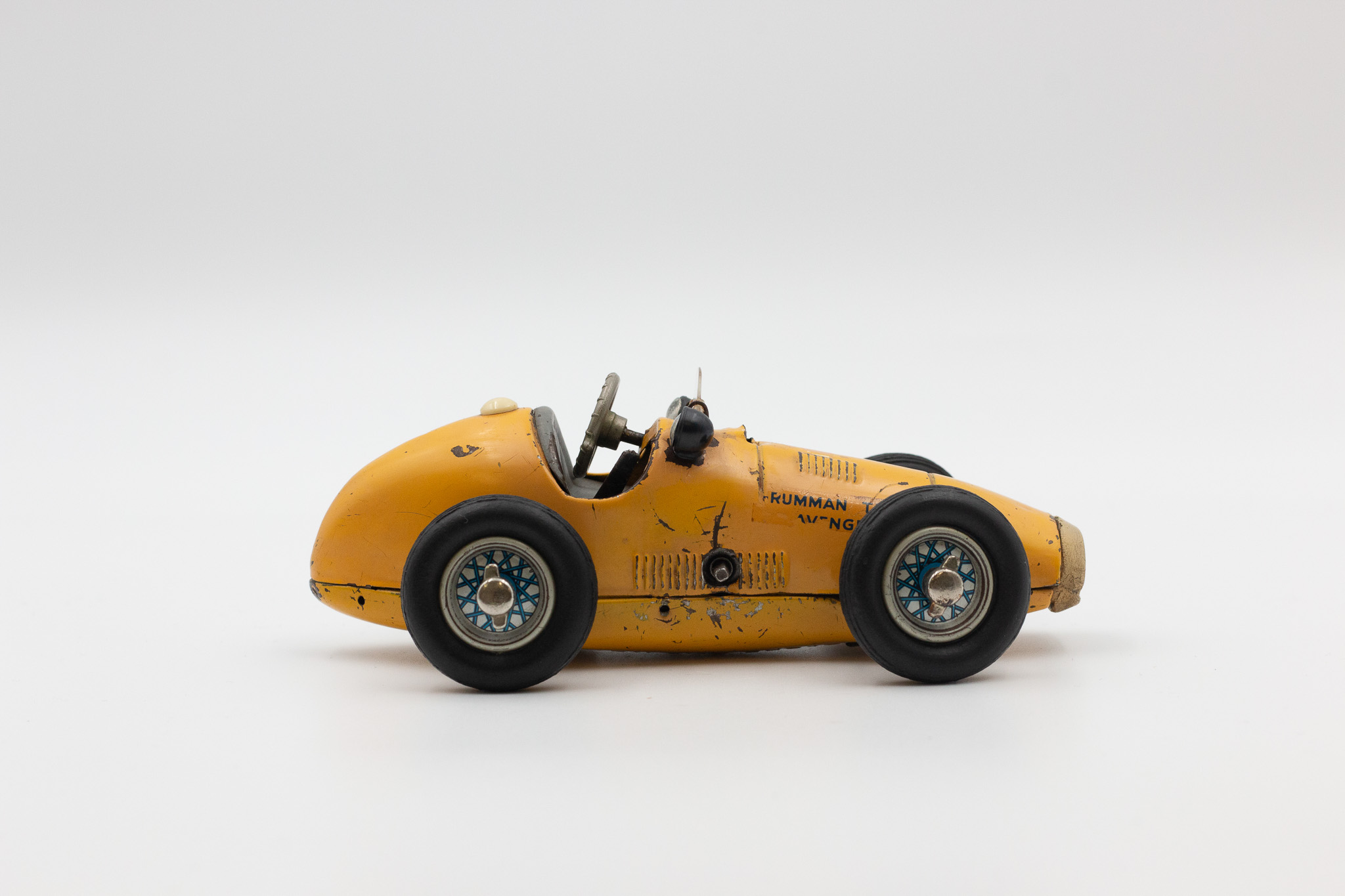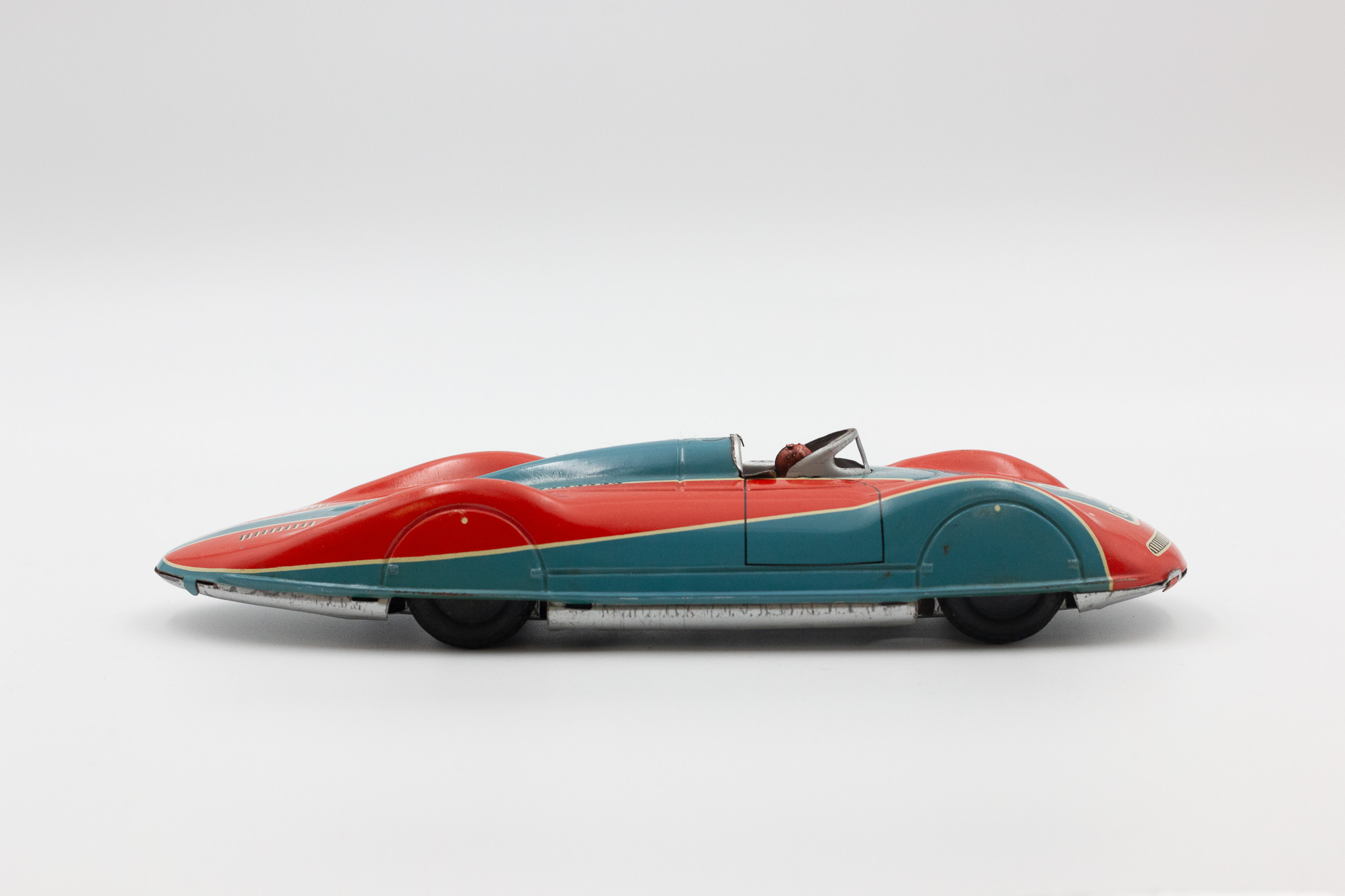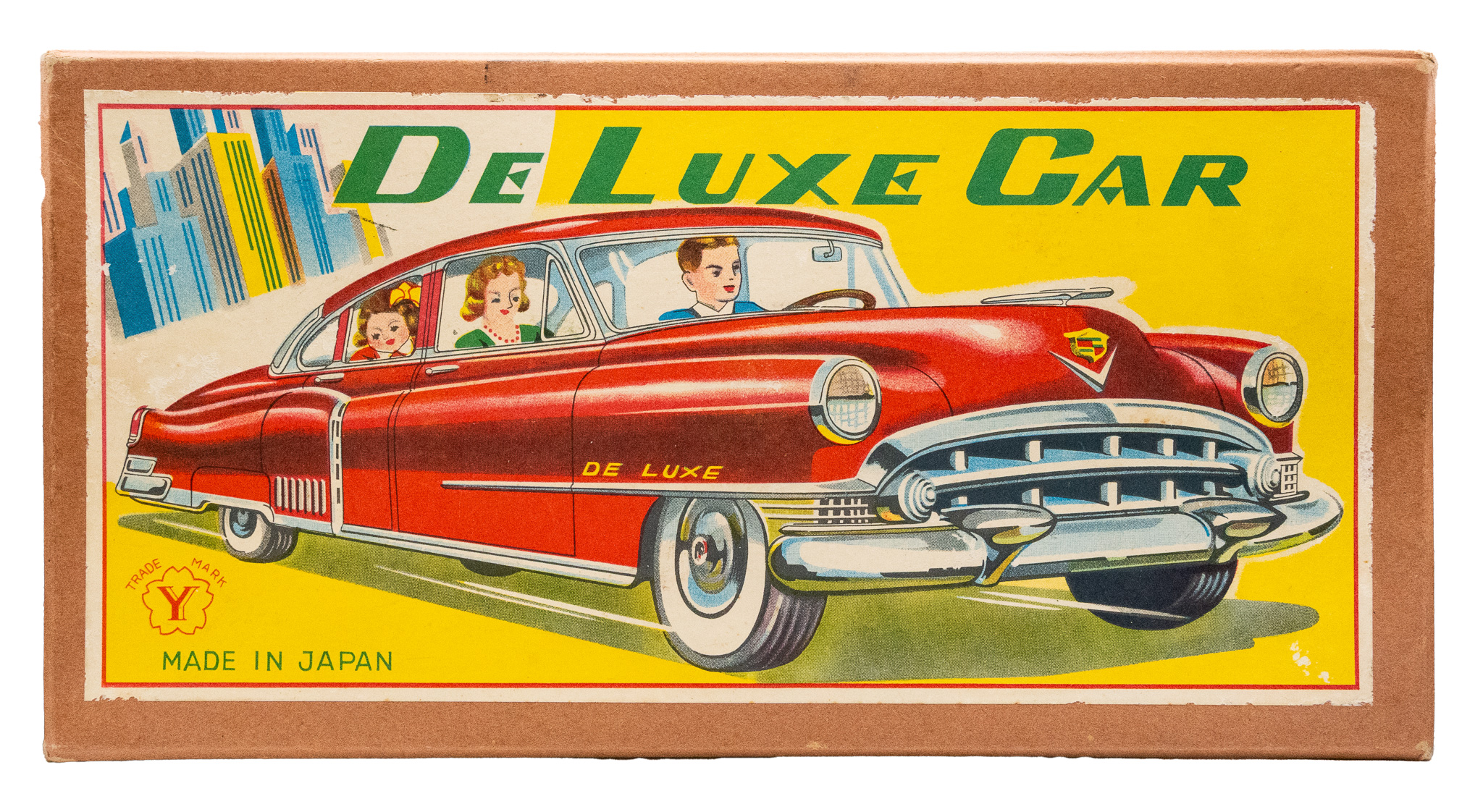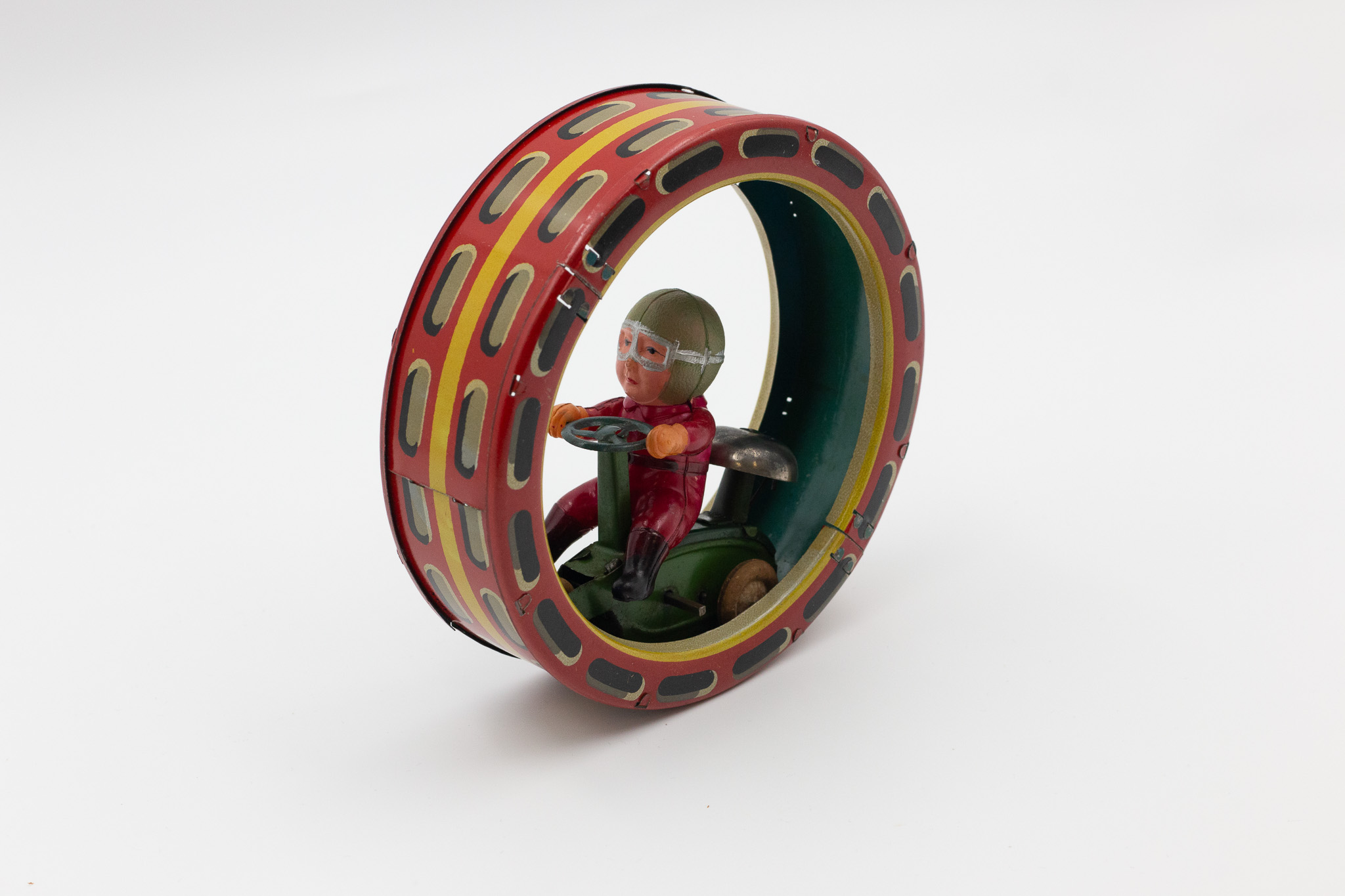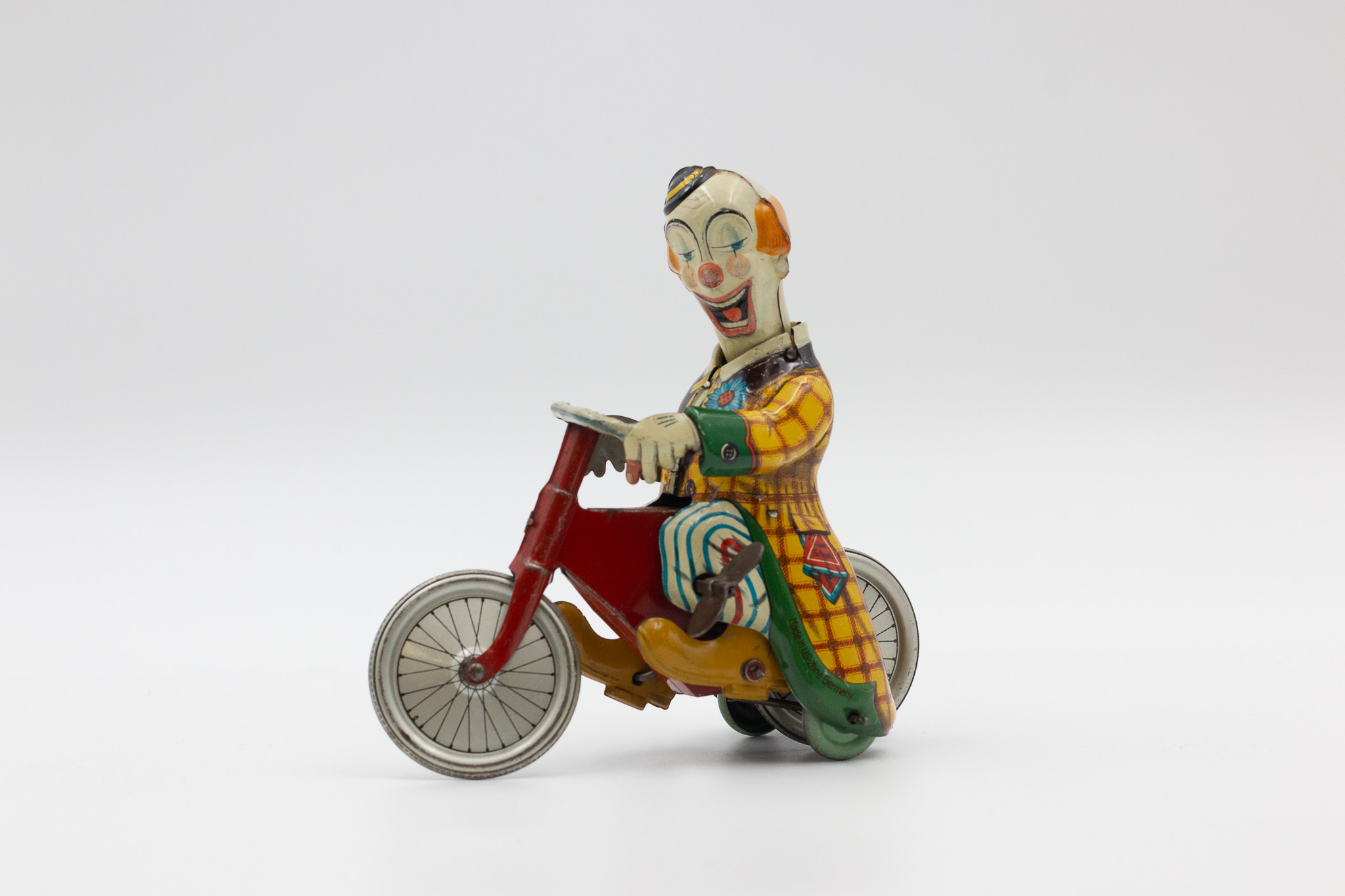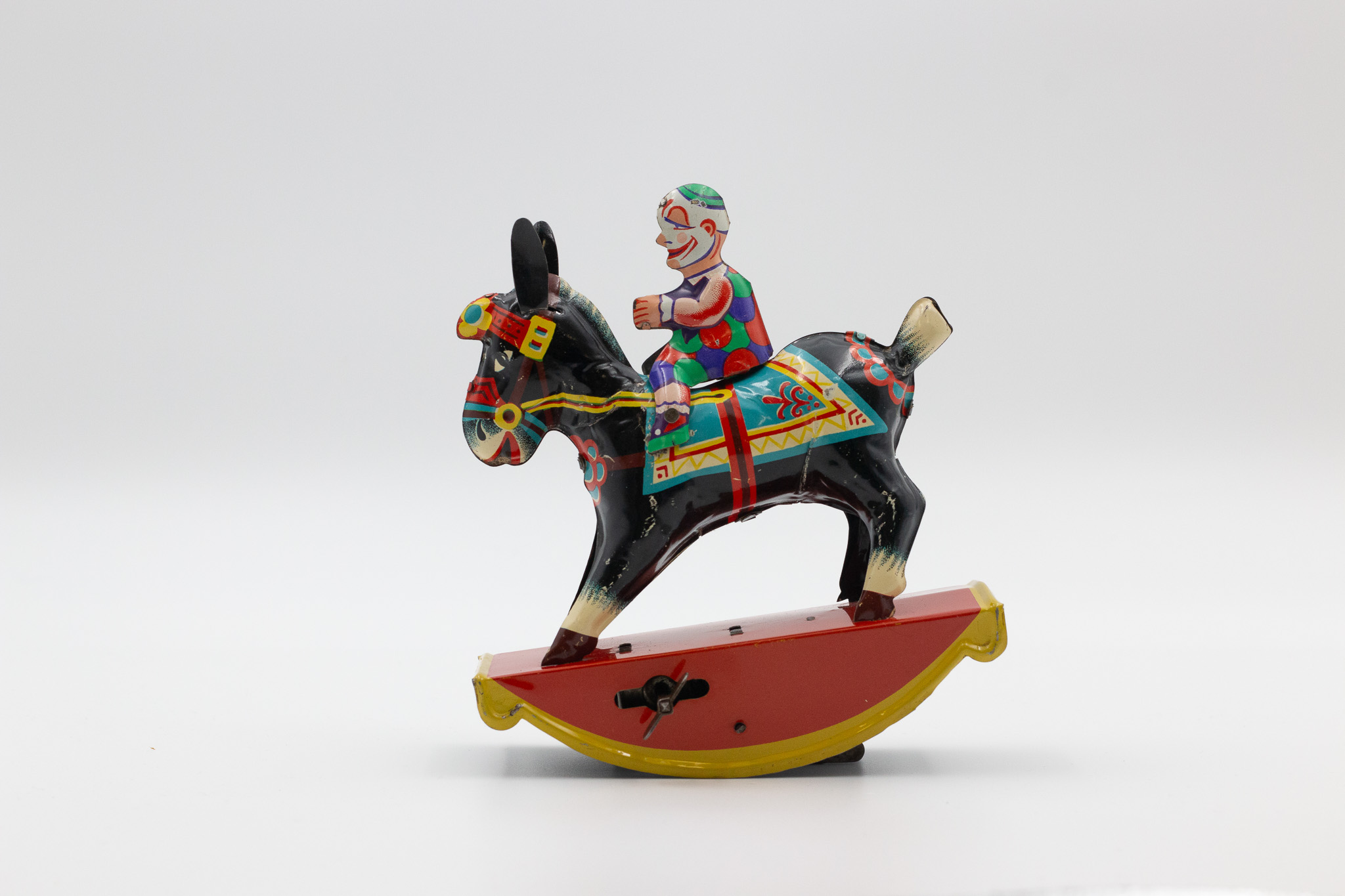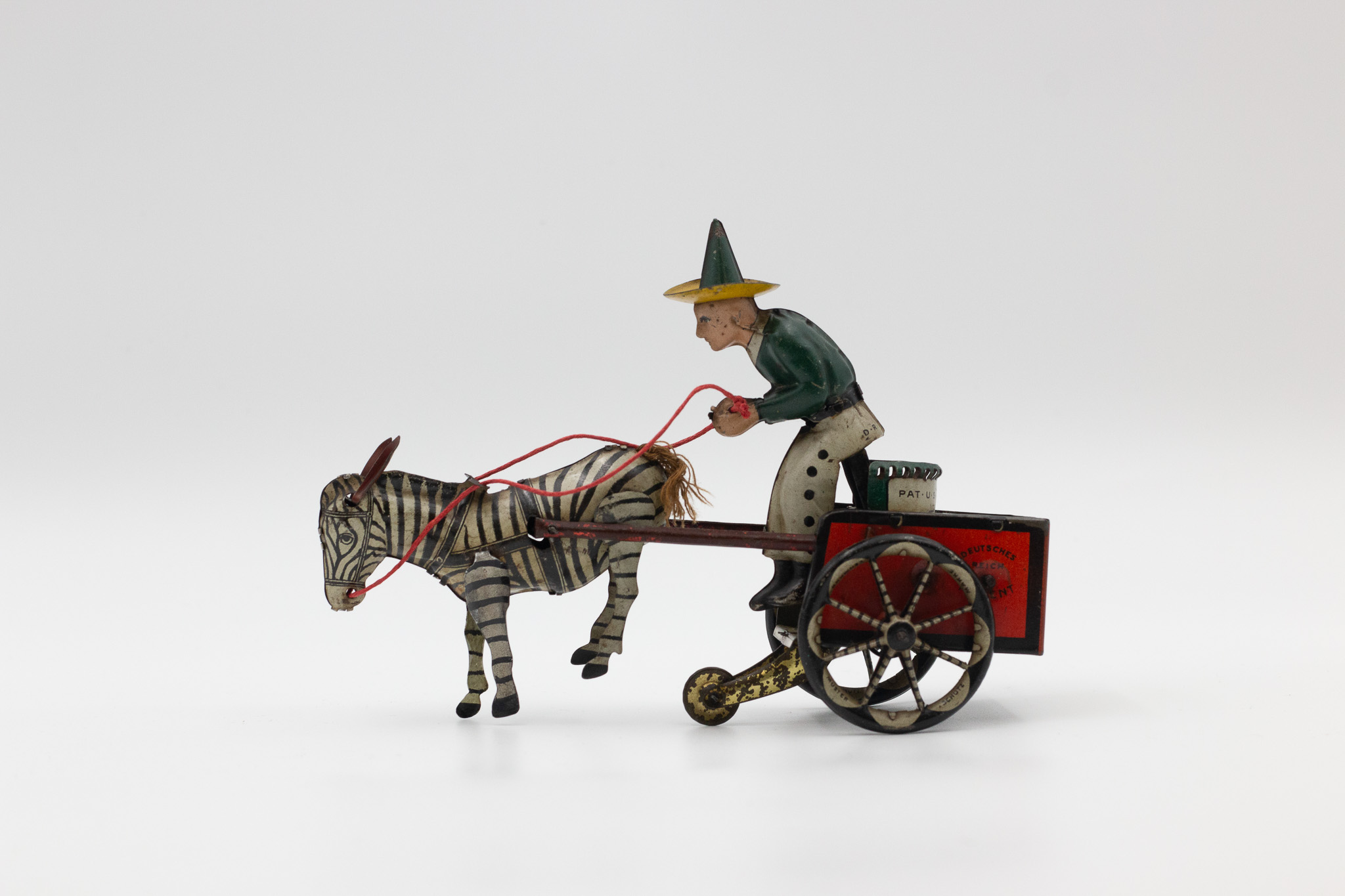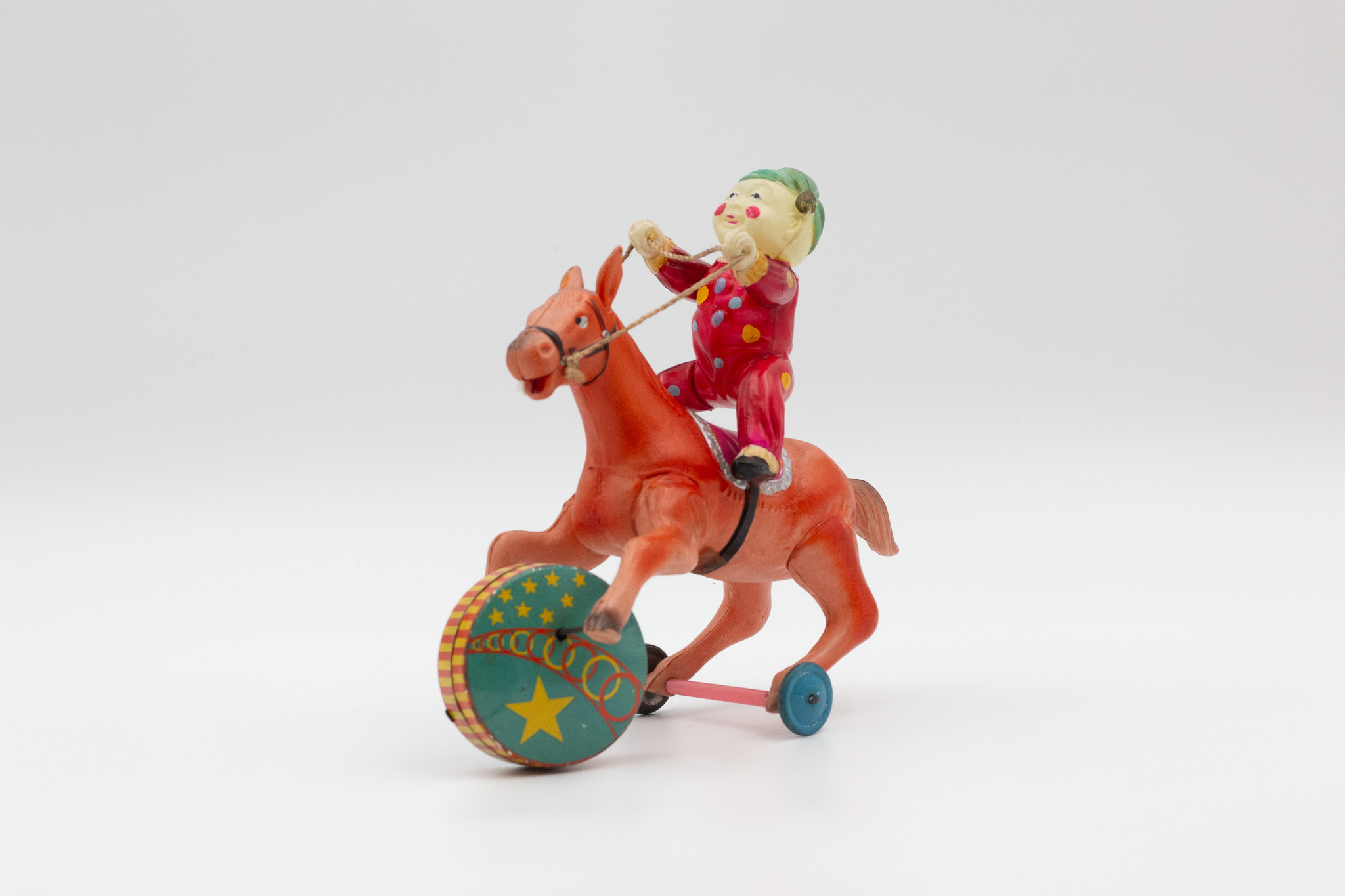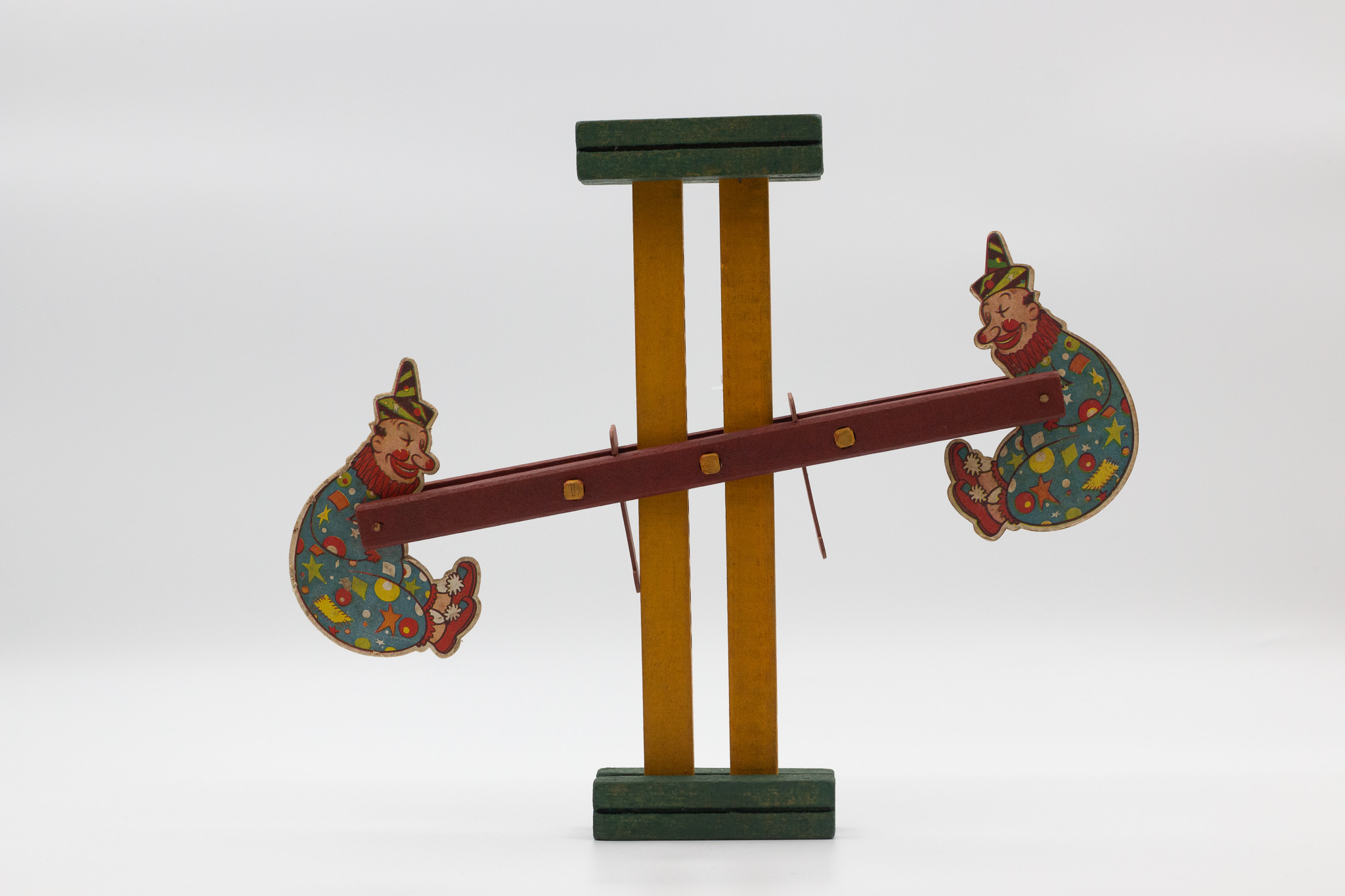Space outlaw atomic pistol
This 1960s die-cast Space outlaw atomic pistol by BCM Co (Derby) Ltd measures 25cm (L) and is marked inside the cap chamber with Reg Design No. 876355, patent pending.
Two versions of this pistol were available: a chrome-plated model made in England and a nickel-plated version produced in Portugal. The nickel-plated version is the earlier model and is held together with screws rather than rivets.
Both versions fire paper roll caps, with transparent side panels that act as flash chambers, revealing sparks. The red panels can be easily removed for cleaning, and both pistols feature recoil barrels. A telescopic sight and laser rangefinder add to their futuristic appeal.
Due to their popularity, similar versions were marketed under different names. In Spain, the company Bernabeu Gisbert produced a nearly identical model called the "Pistola Espacial." This unique and eye-catching space gun remains a prized collectible for enthusiasts.
Celluloid clown with red jacket and umbrella hat
Some of the most beautiful toys are those that utilise movement with restraint.
This celluloid clown absorbed in thought appears to reminisce. The umbrella on his head and a sequin of celluloid beads mimic raindrops. When the clockwork is wound, the umbrella begins to spin, and the beads appear to float away. The figure remains static, but momentum makes him shuffle around and he grows taller and shorter. Made in Japan by Asakusa Toys, c1930. Due to the fragility of material, this is a difficult toy to find in complete and working condition.
Two jockeys two horses
These clockwork celluloid jockeys on horses were made in the mid-1940s in occupied Japan, by an unknown Japanese manufacturer. They are hand painted with great detail and gallop synonymously with either horse winning.
Lehmann cowboy
'The Wild West.' Bucking Bronco is a hand painted clockwork toy by Ernst Paul Lehmann of Brandenburg, Germany. The factory later moved to Nuremberg and became one of Germany's largest toy manufacturers. This clockwork toy was made between 1920-30s and is still working today. When wound the rider is thrown from his galloping horse but manages to get back on his saddle, only to be thrown again. This action is repeated until the clockwork winds down, a realistic and amusing toy to watch.
Lasso cowboy on a horse
Made by Kuramochi (CK) Japan, this 1940s celluloid cowboy on a horse is quite detailed. When wound the cowboy spins his lasso rope round and round as his horse rotates on its own. A well-made toy from an established toy manufacturer made for export to foreign market.
Green prancing horse
Karl Arnold & Co maker of quality German toys made this lovely preforming circus horse. When wound, the tin horse revolves on its hind legs and tail, its head and front legs are also animated. Made in the U.S. Zone Germany it is a delight to watch, c1947.
Mary and her little lamb (joined by string to lamb)
This clockwork toy of Mary and her little lamb was made in 1930s by Kuramochi, Japan. The figure is removable from the base and when wound, Mary travels along pulling her little friend. The offset wheel on the cart makes the lamb's head nod. 90 years on, it's a miracle this toy has survived.
Boy riding rabbit
This mechanical celluloid boy on a hare by Kuramochi (CK) is unique. With the Kuramochi’s trademark under the rabbit, it is a sign of a quality toy. The adventurous boy in his pyjamas hangs on as hare hops forward in a circle while a bell rings from under the carriage. A dream like whimsical experience played out in toy form. This 1930s pre-war toy from Japan is rarely seen and I’ve only come across this one in my thirty years of collecting.
Girl under umbrella
‘Happy Life’ was made in Japan in 1930s by Kuramochi (CK), comprising of celluloid and tin, it depicts a tranquil beach scene, with a daydreaming girl cuddling a pond boat rocking backward and forward on her armchair, while a small duck next to her rotates and quacks and the parasol spins. A poetic and mesmerising toy watch.
Boy and girl swimmers
These celluloid swimmers are small and delicate, with a clockwork motor encased around a celluloid body, they were designed to swim and float, but no matter how well made, celluloid toys did not survive in hot water and these examples are from c1940s are rare, manufactured by Kuramochi (CK), Tokyo, Japan.
British airways aeroplane
Artlay Manufacturing Co., originally a tool-making business in the 1930s, later ventured into toy production under the name Boomaroo. Their toys, known for featuring a distinctive kangaroo-on-a-boomerang trademark, were undeniably Australian.
Based in Sydney, Boomaroo operated a factory in Surry Hills. Some of their early toys included a delivery truck, tipper truck, and the York Airliner from the 1940s. Made from heavy-gauge pressed steel, the York plane was impressively true to scale, considering the material limitations of the time.
Interestingly, while the wings bear a British Airways logo, British Airways never actually operated Yorks as part of their fleet. With a 37cm wingspan and four rotating propellers, this airliner was an instant hit. The green version with original decals, as shown here, is a rare survivor from the golden age of Australian toy manufacturing.
Circus train (4 parts attached)
This small train carrying circus animals is friction, when the train is pushed, the giraffe nods its head, while the tent revolves, and the little seal shows off a trick. Manufactured by Daiya, Japan, it wasn’t an expensive toy to buy new, but worth the pocket money.
Black robot cogs in chest
This 1960s blink-a-gear Robot was manufactured by Taiyo, Japan. One of the larger battery-operated robots, blink-a-gear walks forward with rotating cogs in its chest and lights up. It is one of the more desirable robots for collectors due to its size.
Wooden Bris-made plane
This wooden spitfire was manufactured in Brisbane by C.R. Gregg (Claude Richard Gregg) a woodworker based in Clayfield. Gregg registered a few designs for other wooden toys and aeroplanes in the 1940s with the (WOI) permit. Measuring 45cm x 40cm and stamped on the tail War Organisation of Industry (WOI) permit WQ5, Queensland, this toy was made for the local toy market when no toys were imported from overseas at the time.
4 spitfires (Spitfire fighters by Apex)
Little is known about this manufacturer apart from what was made during a short production in the mid-1940s. Based in Sydney, Apex manufactured this set of tinplate planes and a set of tinplate cars. The illustration on the spitfire box is attractive and detailed, compared to the toy. The spitfires’ propellers do not turn, and the planes came in four colours with a wingspan measuring 8.5cm x 6cm. On the underside of the box is stamped Permit No. N595 which indicate licence granted by the Sydney Office of the War Organisation of Industry (WOI) for manufacturing non-essential items like toys during war time. At a time when metal was used to make ammunition, toys like these helped children pass their time. An interesting period in history for Australian industries.
Toyopet
This 1964 Toyopet crown deluxe was manufactured by Nomura Toys (T.N.) Japan. True to scale, the toy looks just like the real thing, right down to the fine details on the badge and grill. Compared to the previous deluxe crown car by Yonezawa, this toy was made a few years later when toys were still constructed from tin not plastic. The fabrication process would have been quite a feat, but the Japanese have now perfected it. Measuring 45.5cm x 16.5cm, this Toyopet comes in a 2 tone metallic green with a friction motor that creates a revving sound when the toy is pushed. Attention to detail inside the tin interior is convincing. A large toy made in the golden age of Japanese tin toys.
Pope B29 supa-fort bomber
The B-29 supa-fort was a four-engine propeller-driven heavy bomber. In 1945 the B-29 played a decisive role in bringing an end to the war in the Pacific. The B-29 is one of four diecast toys produced by Pope Products, a manufacturer of sprinklers and irrigation products in Adelaide. During and after WWII Pope diversified its production into making toys for the Australian market and these were the only 4 toys Pope Products made: Ned Kelly repeater, Aussie cap pistol, Buick roadmaster and B29 supa-fort bomber.
Dragonfly from box
Japanese toys are not just original but clever and wacky. This mechanical Dragon Fly was made in the 1960s by toy manufacturer Suzuki & Edwards (S.E) Tokyo, Japan. Made of tin except for the thin polythene wings, the harmonisation is kooky. When wound the dragonfly's eyes roll around surveying its surroundings and the four wings rotate mimicking the fluttering. The tail can collapse for ease of storage.
Wyn-Toy tip truck (red & blue)
This Wyn-Toy tipper truck, made of pressed steel, measures 17cm x 5cm and was manufactured in Australia during the 1950s.
Large Wyn-Toy tow truck
Wyn-Toy, an Australian toy manufacturer based in Sydney in the mid-1940s, was a direct competitor of Boomaroo. Though their products were similar in design, Wyn-Toy specialised in pressed steel and some tinplate toys.
A 1964 brochure from Wyn-Toy stated: "Toys that give the child something to do. Working toys will occupy hands and stimulate the mind."
Their marketing also claimed: "Our toys are made from the same gauge steel as the family car, making them more durable and tougher than any toys on the market."
This 1950s breakdown truck, or tow truck, is a Bonzer with its original paint and decals. Measuring 30 cm x 13 cm, it is made from heavy-gauge steel, features solid moulded wheels, and includes a working hand winch. True to scale, this truck was owned by its original owner for over 70 years before joining this collection of Aussie toys.
Boomaroo tip truck
A Boomaroo tipping truck, made of pressed steel, measuring 17cm x 5cm, produced in Australia during the 1950s.
Pope Buick roadmaster
This 1940s die-cast motor car is modelled after the Buick roadmaster and is true to scale. Measuring 13.5cm x 5cm, it was one of only four toys produced by Pope Products.
After the war, Pope Products returned to manufacturing sprinklers and irrigation equipment, a business they continue today, serving Australia and the world.
Boomaroo big truck
Artlay, a Sydney-based manufacturer, began producing pressed steel toys in the late 1940s. The company’s mission was to create locally made, high-quality toys for Australian children. Their trademark—a kangaroo on a boomerang—soon became synonymous with Boomaroo Toys.
This mid-1950s pressed steel delivery van, measuring 38cm x 14cm, was available in red, yellow, blue, and green. Featuring a two-door storage compartment and robust steel-rolled wheels, it was perfect for transporting toys and storing treasures. The decal on the side showcases some of Boomaroo’s popular toy range, mimicking real delivery vans of the era.
Today, many of these vans are found in various states of disrepair, having been left in playgrounds and sandpits. Finding one in pristine condition is increasingly rare.
Schuco monkey
The Schuco yes/no monkey, made in Germany in the 1920s, is covered in mohair and has glass eyes. This charming toy features a unique tail mechanism that allows its head to nod or shake side to side, earning it the nickname "Yes/no monkey."
Black terrier cloth
This 1930s clockwork Scottish Terrier, known as "Tippy", was produced by Schuco, Germany. Measuring 13cm, it has glass eyes and a felt-covered tin body. When wound, Tippy runs in circles, much like an excited puppy eager to greet its owner.
In later versions, Tippy was given a dog coat, and the underside was stamped with "U.S. Zone Germany."
Bad Mickey sitting
A clockwork tumbling Mickey Mouse, made by Schuco, Germany, with a felt-covered steel body. Measuring 8cm x 5cm, this playful figure somersaults when wound.
Pope Ned Kelly repeater pistol
In 1925, a South Australian company was founded as Pope’s Sprinklers and Irrigation Company. By 1931, it had rebranded as Pope Products. Like many manufacturers of the era, Pope began with a specialised product before diversifying during the war years. In 1948, the company expanded into toy manufacturing for Australian children.
The Ned Kelly repeater pistol was one of just a few die-cast toys produced by Pope, along with a smaller Aussie pistol, a toy plane, and a toy car. These cap guns fired paper roll caps.
The Kelly pistol is marked with (WOI) and WS1680, indicating it was manufactured with permission from the Department of War Organization of Industry in South Australia. At the time, toy manufacturing in Australia was prohibited without this government-issued permit.
Today, surviving examples of these cap guns are increasingly rare, making them highly collectible.
Small scary monkey
A pre-war clockwork tumbling monkey, manufactured by Schuco, Germany. Made of steel with a felt-covered body, it measures 8cm x 7cm.
Bulldog with shoe
This small tinplate bulldog, clutching a shoe in its mouth, is an adorable mechanical toy. When wound, the bulldog rotates on its feet, powered by a gyroscopic tail that spins.
Manufactured in Japan during the 1950s, the maker remains unknown.
Rabbit with carrot
This clockwork rabbit, made in Japan (c1940s–early 1950s), exhibits a lifelike motion. When wound, the rabbit moves forward, pauses, then sits up on its hind legs to survey its surroundings before dropping back down and continuing forward. This cycle repeats until the clockwork mechanism winds down.
Measuring 9cm x 6cm, the manufacturer remains unknown.
Kangaroo
This clockwork kangaroo, made in U.S. Zone Germany, hops forward with the aid of a rubber stabilising tail. Although unstamped, it is likely produced by Georg Köhler, a well-known German toy manufacturer.
Dog in skirt with ball
This clockwork fox terrier, produced in U.S. Zone Germany after World War II, is a beautifully lithographed tin toy. When wound, the circus terrier, wearing an apron, pushes a ball with its front paws, while its hind legs, designed like a wheel, help it roll forward.
The manufacturer is unknown, but it is possibly the work of Georg Köhler. A best-in-show collectible!
Rabbit with felt ears
Similar to the hopping kangaroo, this tin clockwork rabbit moves on its hind legs. The spring mechanism only activates when the rabbit is placed on a flat surface.
Made in U.S. Zone Germany, this toy is likely a product of Köhler, a German manufacturer known for novelty animal toys from the late 1940s.
Banana Joe
This 1950s English-made toy, known as Banana Joe, features vibrant lithography and colours. When wound, Banana Joe pushes his cart round and round, providing endless amusement.
Frog manufactured by Peter Pan Toys, England
Not quite Kermit but still cute. Flipo was manufactured by German firm Schuco in the 1940s. With glass eyes and felt covered tin, it was a popular line, appealing to both boys and girls. When wound with Flipo’s legs tucked under, Flipo hops forward, and with legs placed behind, Flipo rolls forward like if it was swimming. Measuring 7cm x 11cm, Flipo is a clever in design and concept.
Fish on wheels
This tin trout by Hadson Toys Japan, was made in the 1940s and is realistic. With a tiny friction motor the trout rolls along as if it was swimming.
Big koi
This crank operated bump & go fantail goldfish by Yoshiya (KO), was made in Japan in the 1950s. With an unusual wind-up mechanism and goggle eyes it is made to look more animated and comical than the trout.
SpinRay blast pistol
Manufactured in the 1940s by Brewer and Armstrong, Michigan, USA, the SpinRay blast pistol is an interesting and rare toy that was only recognised by ray gun collectors about 10 years ago.
Measuring 16cm x 12cm, this cast-aluminium toy features a lever, flywheel, and spring mechanism connected to a propeller. When the trigger is pulled, a small gear attached to a long rod spins the propeller, creating a dynamic visual effect.
Now over 80 years old, the SpinRay blast pistol remains a fascinating piece of toy history, with surviving examples still in working condition.
Crocodile
This clockwork snapping crocodile is by an unknown English maker. Measures 40cm long, the crocodile snaps its jaw when it wound, a simple and amusing action with various versions made in in different countries.
Jumbo with mahout
This clockwork walking circus Jumbo elephant was made in the U.S. Zone Germany around the mid-1940s. Like the Lesney/Matchbox version called Moko, this walking Jumbo is carrying a mahout with a detachable parasol. When wound the elephant walks slowly but steadily swaying side to side as his feet lifts off the ground. Surprisingly just like a real walking elephant. With no maker’s mark it could be by Blomer & Schuler, a German toy manufacturer specializing in unusual walking animals.
Elephant with monkey
Toy manufacturers sometimes copied one another. Although clearly not the same toy as the German Jumbo with mahout, this small clockwork walking elephant with monkey was made in Japan by San. It has a mechanical trunk and flapping ears. A lovely comparison toy from early 1950s.
Blue Jumbo
This German Jumbo elephant by an unknown maker is very similar to the English Lesney/Matchbox Jumbo walking elephant. Circus and fairground toys became popular in the 1950s when this was a form of entertainment grew and families visited the circus.
Cat with red ball
Clockwork cat with ball by Marx Toys, USA. When wound the cat rolls over with the aid of its tail to mimic a feline playing. From the late 1940s, it is one of many versions of the cat with ball toy.
Dog with red collar
Kuramochi Shoten (known as CK) was a well-known Japanese toy manufacturer from Tokyo in the 1920s. This little dog was made around 1940s. It has tail that rotates when wound and a gyro mechanism that makes it shake and spin on four feet when placed on a flat surface.
Dog with studded collar
This small mechanical walking dog is made of tinplate, when wound the little dog stride along proudly with its head held high. It is from an unknown Japanese manufacturer, c1940s.
Cat and mouse German
This clockwork toy cat chasing a mouse was manufactured by Blomer & Schuler in the mid-1940s, marked on both the box and toy, are the inscriptions U.S. Zone Germany. Its action is clever and amusing. When wound, the cat chases the mouse around, but he never catches it.
Big yellow cat and mouse
This toy of a cat chasing a mouse was made in Japan 1950s. Made completely of tinplate, it has a more unusual pull mechanism. When the little mouse is pulled away from the cat, a spring retracts, and the cat eventually catches up to the mouse after a chase. A clever toy by unknown Japanese maker.
Butterfly
This beautiful tin butterfly flaps its wings when pushed, made in Japan by unknown maker, c1950s.
Water Hopper
With a suction cup underneath, this water hopper can spring up when pressed, made in Japan c1950s.
Budgie
Beautifully constructed friction budgie, with detail lithography, made in Japan by unknown maker, c1950s. When pushed along the budgie flaps its wings.
Dragonfly
A realistic dragonfly with beautiful lithography that can travel along when pushed. Made in Japan by unknown maker, c1950s.
Kikatasio Shitsuganchu gymnastic toy
Kikatasio PATENT SHITSUGANCHU gymnast is a fabulous toy by Kuramochi (CK). A painted celluloid gymnast on an A frame trapeze. When wound the little boy performs a variety of realistic moves just like a real gymnast and his routine goes for a while. With a counterweight flag that helps his balance, he is amazing to watch. On the box states, ‘The Best Made Toy.’ Made in prewar Japan, he comes with his original box.
Box for Astroboy acrobat
This acrobatic toy by Asakusa Toys, was made under licence by Mushi Productions in the early 1950s. Based on a Manga comic series by Osamu Tezuka. 鉄腕アトム Tetsuwan Atomu was a robot built by Dr Umataro Tenma, a robotics engineer after the death of his son. Atomu/Mighty Atom was different to any other robot. He was a robot-boy with human emotions. There were often references suggesting that the energy source of Atomu was nuclear power, but it was never clearly explained how nuclear power was used to generate the robot's energy.
The box also features Atomu’s younger sister Uran, a name derived from a chemical element uranium atom 92. When wound, this celluloid Atomu would swing on his trapeze just like a real gymnast, with random forward and backward manoeuvres which make him look like he is flying. Not a common toy with the original box.
Atom ray gun
This 1940s Atom ray gun (Water Pistol) by Hiller Mfg, USA is made of cast aluminium and beautifully designed to reflect the futuristic Atomic Age of the 20th century. With a large water capacity, it can fire 50 long-range shots before needing to be refilled.
Plane tower ride
Japanese toy manufacturer Asahi (ATC) produced many wind-up and battery-operated toys in the 1950s. With their distinguishable trademark logo of Santa Claus carrying his sack of toys, Asahi toys produced quality toys for a overseas market. This 1960s Lever action TV Tower toy was produced in two versions, one as the Eiffel Tower and the Tokyo Tower. Both toys are near identical except for the lithography. The Eiffel Tower’s graphics depicts the Parisian landmarks with Arc de Triomphe and Notre-Dame. This toy operates by a pull lever, the children inside the tower move round looking at the view, while two planes circle by and a Sputnik style satellite with a monkey inside orbits above. With so many elements, this toy ticks all the boxes and is one of my favourites in the collection.
Vacationland toy
This mechanical Vacationland express with box by Yonezawa Toy Co is marked with Yonezawa’s distinctive five petal cherry blossom trademark of quality. Yonezawa Toy Co is one of the larger tin toy manufacturers in Japan. The Vacationland express is small and compact but has lots of things happening. A detachable plane circles, while a passenger train with tourist runs in and out of the miniature scape and a bell ring to notify you of its arrival. There is even a gate at the station which can be shut to stop the train. The lithography on the side is charming and features some attractions that you could visit while on vacation. A lovely little toy from the 1950s, made in Japan.
Failyland 1-6 dream train
These colourful tin trains decorated with animal passengers were made in Japan during the country’s post-war economic recovery, c1947-49. This toy reflects a happier time for the nation. Measuring 12cm x 3.5cm, each carriage bears the Sinko logo, a lesser-known Japanese toy manufacturer. The crudely cut rubber tyres and thin tin were most likely repurposed from surplus material from other industries. The appeal in this toy is the misspelt names on the box, Faily Land Dream Train, Faily Lani Dream Train. An inexpensive toy back in the day, but a hard-to-find toy complete with the box today.
Space dog
1950s space dog with wind-up motor by Yoshiya (KO), Japan. Yoshiya toys released several versions of the space dog, in red and silver with wind-up motor, an orange battery version and a remote-control blue space dog. With detail lithography and a strong clockwork motor, just wind and off he goes flapping his ears. A sparking mechanism is viewable from inside the red window on his back. The antenna also acts as a stop and go switch. Space dog’s wheels are offset, so it doesn’t just roll along, but waddles slowly in zero gravity. Measuring 15cm x 12cm, the space dog joins a troupe of bizarre hybrid animals, the space whale ship and space elephant exploring galaxies far away.
Space elephant
In 1957 the USSR launched a Sputnik satellite into space. It was the first man-made object to orbit the earth and send back radio signals. The satellite continued to stay in orbit for two months and inevitably triggered the space race. The appetite for anything space grew, and hundreds of space toys soon appeared on the market. This mechanical space elephant is futuristic in appearance. Made by Japanese manufacturer Yoshiya (KO) in the 1950s, it has a flexible wobbly trunk, bubble goggle eyes and sparking action. The elephant’s ears also flap when it moves along, leaning from side to side. With offset wheels to mimic a weightless feeling, the space elephant travels along at slow speed. The antenna on the elephant is also an on/off switch, and the box’s illustration of a lunar landscape is ahead of its time. A hard-to-find toy in silver grey, this space elephant joins the space dog in a space race.
Buck Rogers gun
The XZ-31 Buck Rogers 25th Century Rocket pistol, produced by Daisy Manufacturing Co., Plymouth, Michigan, was released in 1934. Measuring 19cm (L), this ‘Pop’ ray gun became the signature weapon of Buck Rogers.
Featuring a fin recoil absorber, muzzle blast deflector, and converging target focus scope, this toy was a must-have for young space cadets of the era. With its sleek, futuristic design, the XZ-31 rocket pistol set the standard for other ray guns that followed. Nearly 90 years later, it remains an iconic piece of sci-fi history and has been reproduced in numerous designs and pop culture advertisements.
Mr Robot
One of the favourites from the vault is Cragstan's battery operated Mr Robot. With multicolour swivelling zoetrope dome and mystery bump and go action. Made in the 1960s by Yonezawa and released through Cragstan Toys, Mr Robot was available in red, grey and this rarer white version. A difficult toy to find today, especially with the original box.
Atomic jet gun
1950s Atomic-jet gun (water pistol) manufactured by Crescent Toys, England. Made of cast Aluminium, the jet-gun is an English copy of the American Hiller atom ray gun.
Tom Corbett (Aus) gun
Tom Corbett space cadet cap gun was manufactured by Brentoy, Melbourne, Australia c1950s.
John Brent and Company was a toy manufacturer based in Melbourne and traded under the name Brentoy in the 1940s. By the 1950s toys produced under the Brentoy name include diecast vehicles, plastic toys and tinplate beach buckets. The diecast Tom Corbett space cadet cap gun was made in the early 1950s. Inspired by the American toy by Pyro, the U.S. version was made of plastic and didn’t fire caps. The Brentoy’s space cadet control gun has a self-feeding cap mechanism, each time the trigger was pulled. A hidden lift hinge incorporated into the casing makes the design easy to reload. The only identifying mark of Brentoy is in minute letters on the rings of Saturn, on the left handle. A 70+ year old Aussie space toy that has been through countless intergalactic conflicts and is still in working condition today. A rare find.
Spaceman England gun
This 1950s spaceman space gun by ‘Limit’, is slimline and futuristic. Made of press metal with a side pull spring load mechanism that locks before firing. It can shoot harmless cork bullets over a short distance and look the part in metallic hammer tone finish. The spaceman space gun measures 22cm x 12cm and is in original play-worn condition with its yellow wood knob. An unusual space pop gun toy from England.
Space control gun
Nomura Toy Industrial Co. Ltd, Japan, was a prolific manufacturer of tinplate toys from the 1940s. Many of Nomura’s toys were made for export to a foreign market. This small tinplate space control space gun is from early 1950s. Measuring 9cm x 8cm, it is just the right size for little hands. With a futuristic design and decorated with planets, rockets & astronauts, it was one of Nomura’s best sellers. A cheaply made toy with sparking flint action inside the barrel.
Space universe gun
Space universe sparkling ray gun, unknown maker (T-Arrow) trademark, made in Japan 1960s.
Brown gun atomic powerpop
L&I Glenn Pty Ltd was a Melbourne based plastic manufacturer from Hawthorn East in Victoria. In 1946 L&I Glenn imported a 2oz “Windsor” injection moulding machine from the UK to Australia. This was the same machine that Lego bought in 1947. Injection moulding became a game changer for Glenn and the company was able to produce a range of plastic toys for the Australian toy market, including kewpies, plastic vehicles and this wonderful atomic power pop space gun. To my knowledge this was an Australian designed space gun, not copied from any space toys from overseas. The powerpop is 98% plastic, but also use a brass plunger system to shoot a cork and create a Pop! It is surprisingly heavier than it looks. The powerpop came in a variety of colours including red, yellow, blue, black and this bronze variation. There is even a whistle built in the handle for when you are in distress. In a clipping from 1951 the Pow’r Pop was described as an ultra-modern design and fired harmless cork ammunition with a good loud Pop. The cost back then was 10 shillings and sixpence. Today this Aussie space gun is highly sought in any condition and is regarded in collectors’ terminology: ’rocking horse poo.’
Planet patrol rex mars
Louis Marx & Co was an American toy manufacturer from 1920 to 1980. Their claim to be one of the world’s largest manufacturer of toys could be true. With a head office on 200 Fifth Ave, New York. The company manufactured a large range of toys, including tin toys, plastic soldiers, toy guns, scaled trains, doll houses, Disney figures and anything you can think of. With a distinctive logo of MAR and X in a circle that looks a bit like a railway crossing sign, Marx also manufactured toys in the UK, British Crown Colony of Hong Kong and Japan.
This clockwork planet patrol tank was from their (Official) rex Mars space toy line. Copied from an identical toy called sparkling Doughboy windup tank, it's now transformed into a space tank. Marked X-1, the Planet Patrol is loaded with an array of lithographed missiles, launchers and ammunition, ready for any outer space encounter. Just like the Marx Doughboy World War I tank; the Space Patrol's figure pops up intermittently shooting from the rear of the tank as it moves in random directions. The flint under the cannon sparks and like many of Marx’s mechanical toys there is even an on/off switch that can override the clockwork. The timber wheels make the tank spin easily on different surfaces. The space patrol is not a small toy, measuring 25cm x 12cm, but like anything in the USA - the Bigger, the Better.
Planet bronze gun
The Planet gun is a rare and highly sought-after die-cast toy made in Australia during the 1950s. Manufactured in Melbourne by Janda Trading Company, this ray gun fires paper roll caps. It is one of only three ray guns known to have been produced in Australia and is now extremely hard to find.
Space survey Craigston
The X-07 outer space survey ship by Masudaya/Cragstan is a battery-operated teardrop shaped saucer with a built-in non-fall action that sense the edge of a table so you can operate either on the floor or a table surface. This non-fall technology isn’t new, with German toy manufacturer Schuco perfecting it in their clockwork cars and motorcycles in the 1940s and the Japanese incorporating it in their battery toys in the 1950s. With the space survey’s automatic orbiting action, flashing lights and signal sounds it looks amazing in the darken room. The tin astronaut inside the capsule even waves his arms at you when moving off. The 2D cell batteries in separate compartments adds stability to the ship while operating. Measuring 23cm x 19cm this is another cool toy by Masudaya, adding to their expanding range of spaceship & robots.
Astro captain
Wearing a NASA helmet and equipped with oxygen/booster backpack, this 16cm tinplate walking astronaut emits sparks inside the panel in his chest. Made in Japan by Daiya and distributed by Mego Corp in the U.S, this red arm version of astro captain is from 1960s. Later versions came with white claw plastic arms, both are cool.
Please don’t hold me the expert
The 1960s Atom expert motorcyclist is quite a large battery-operated toy by Masudaya/Modern Toys. Collectors believe it was Japan’s homage to the German motorcycle toy by Arnold, the Mac700. A larger, battery operated toy with working headlamp, a revving engine and the infamous hop on, hop off action, that has amazed toy enthusiast and young children for over 60+ years. This blue helmet version is more common than the orange helmet and comes with the original instruction card that reads, ‘Please don’t hold me my little friend’ the mechanism inside the driver is so delicate that you are asked to hold the rear of the motor - cycle in case you are carrying.
Mac700 black Arnold mac
The Mac700 is one of the most sophisticated motorcycle toys of its time. Manufactured by Karl Arnold & Co, in Germany c1945, it was produced for foreign market. Measuring just under 20cm long, the Mac's ingenious clockwork, can be set to make the bike travel in a circle with the rider seated and with a flick of a switch, the rider dismounts from the left and then remount before continuing with his journey. The 700 can also idle stationary with the rider hoping on and off while the clockwork rattles to mimic the engine sound. Complete and in working condition, unlike Tipp & Co police motorcycle, it is considered the holy grail for collectors of toy motorcycles.
Yellow rider in cap German
A very early c1915 Wilhelm Krauss touring cycle with advance clockwork motor and spring belt drive, connected to an internal lead flywheel. The lithograph is vibrant and shows a detail 2-cylinder Vee engine modelled from a real bike. The toy is a glimpse of life on early touring cycles and what rider attire looked like at the turn of the century. For a toy that is over 100 years old, it is in wonderful condition with only minor wear. Made in Nuremberg, Germany, it is the oldest tin toy I have found and a welcome addition to the collection.
Mettoy (Australian made), tourist trophy
This clockwork motorcycle with rider was made under license by English toy manufacturer Mettoy in Australia. Called tourist trophy, it was a copy of the English toy with notable difference, the colour.
The English version came in red, and the Aussie bike is blue. Manufactured from similar pressing through a local toy retailer Theo H.Levy, this Mettoy tourist trophy was stamped made in Australia, behind the rider's right boot and has the Mettoy logo on the tank.
With heavy tariffs placed on imported good to Australia in postwar years, this collaboration was an attempt to sell the Mettoy brand here without impositions and boost Australian manufacturing. Production ceased in 1953 with just three toys from the Mettoy range made. Today, this toy is hard to find even in Australia.
Paya motorcycle
An early clockwork motorcycle by Spanish toy maker Rico. This model was produced before and after the war, with unusual colours and graphics, it is equipped with a strong motor to propel the rider across the floor. Measuring 11cm and completely made of metal, this toy is bello!
Red bike yellow trousers
This 1940s tin friction autocycle in Harley Davidson style with rider measures 13cm long and is beautifully lithographed. The rider dressed in period race attire and goggles is lovely. Made by Nomura Toy industries Co. Ltd, Japan, it is stamped, "Made in occupied Japan" with Showa Trademark on the underside was destined for a foreign market. A rare gem from post-war era.
Orange Technofix friction motorcycle
This lovely, pressed tin friction motorcycle was made by Technofix, in U.S. Zone Germany, c1945. The detail on this bike is realistic and has different lithography on both sides. With the popularity of motorcycle toys growing, Technofix continue to make this model into the 1950s, see Technofix red motorcycle 15. The later bike is similar but has plastic wheels, reflecting the changing times and the move towards plastic.
Technofix red motorcycle 15
This Technofix No.15 friction motorcycle is colourful and smart looking, reflecting the lines and style of the 1950s. Made in West Germany, it is similar to Orange Technofix friction motorcycle, and has a bellow inside to makes a pop pop sound mimicking an exhaust backfiring when it is pushed along.
Tipp & Co Police Motorcycle This 1950s large friction tinplate motorcycle is by German manufacturer Tipp & Co, the bike and rider are realistic with the Police badging and colour it is true to scale. When pushed the friction motor revs and mimics a siren sound. Its battery-operated headlight takes one unusual size battery, unfortunately this battery size is no longer in production, which is a shame as it would look stunning lit up. This is one of the more desirable large Tippco toys in the day, it is difficult to find complete with the visor screen.
Aussie cap pistols
Pope, a South Australian company that began in 1925 producing sprinklers and garden products, rebranded as Pope Products in the 1930s. Like many Australian manufacturers during World War II, Pope diversified its production, making ashtrays, torch cases, tools, and toys.
Among the four toys Pope produced were: a Buick die-cast car, the Supa-Fort plane, two die-cast cap guns (one modelled after Bushranger Ned Kelly’s six-shooter, and the smaller Aussie Cap Pistols, each measuring 14cm x 6cm).
Although Pope no longer manufactures toys, the company continues to produce garden and irrigation products.
Arnold mac motorcycle
This Arnold motorcycle is the same as Mac700 black arnold mac, but missing components like the headlamp and the spring has been over wound. It has also been left outdoors for some time. Back in the day, toys like these were built for play, not collected like today’s brand collectables. To find a Mac700 in this condition, is still a joy as it shows it has fulfilled its function as a toy.
New style motor car
The new style motor car is a wonderful clockwork toy by Masudaya Toys.
Founded in 1724 in Tokyo, Masudaya is one of the oldest toy manufacturers in Japan, if not the world. To this day, Masudaya is still trading under the name Masudaya/Modern Toys.
This pedal propelled car from the 1920s resembles today’s life-style scooters. When the clockwork is wound, the cyclist pedals realistically and is even wearing a helmet. A lovely example of a scarce toy from the golden age of Japanese tin toys.
Wells Brimtoy bus
This London double decker bus is equipped with an ingenious clockwork. When wound, the bus travels along, then stops sounding a bell, before moving on again. This action is repeated a few times till the clockwork winds down. Made in England by Wells/Brimtoy, c1950s, and comes in the original box.
Greyhound bus
This small 1950s battery operated Greyhound bus operates on 1x D Cell battery. Made for a Foreign market, it has detail lithography on all sides. The bus works well and travels in a straight line. Made in Japan by unknown maker.
Maus in auto German
So, what’s more terrifying than a mouse zooming across the floor. A mouse zooming across the floor waving from a BMW 328 Mille Miglia Roadster. Inspired by Russell Hoban’s novel and later an animated movie: The Mouse and His Child. This Schuco sonny toy from 1945-50s measures 13cm. When wound the little mouse behind the wheel raises his left arm and drives off. The front wheels on the roadster can be set left, right or straight and it can travel backwards. Made of press steel and tinplate, Sonny is in fabulous condition and looks like he has never been played with. Stamped, made in U.S. Zone Germany, patent pending on the underside, Sonny is hard to find.
Yellow race car
Based on a 1953 Ferrari 500 F2 der doppelweltmeister. Schuco made this double world champion racer and a Mercedes Benz, Grand Prix racer as part of their studio series. Marked U.S Zone, Germany on the underside, this well-loved toy came with working steering wheel, interchangeable front and rear wheels with blue and red spokes that can be easily changed to suit the driver. The rubber tyres are also detachable from the wheel. Despite looking far from mint, the key wind mechanism still works, and that's exactly what you would expect from a Schuco toy. The Grand Prix racer also came in Ferrari red and silver arrow grey, but the yellow version is less common.
8 ‘Audi’ red & blue
This friction tinplate toy is a marvellous representation of a 1937 auto union type C streamliner. Manufactured by Distler, a renowned toy firm in Nuremberg, it is marked U.S. Zone Germany on the underside and Western Germany on the rear fender, most likely made between the transition period. A clockwork version was also available in the same colour scheme and on the bottom left is a hole punched out for the key wind version. Both cars measure 24.5cm x 9cm and are scaled models of the iconic speed car built for the Avus circuit, near Berlin.
Toyota crown teal
This 1950s deluxe car by Yonezawa, Japan is beautiful. Made of pressed tin, with the exception of rubber tyres, it does resemble an early Toyota of the time. Marked ‘Crown’ on the boot and on the side, it come in two tone green. The car’s friction motor revs when pushed and mimics an engine sound. Although the illustration on the box shows a different car, it is the original presentation box this toy came in. Measuring 27cm x 14cm, quite large, this would have been an expensive toy when new.
Loopy toy
Loopy is based on a prototype of a dynasphere, a mono wheel vehicle invented in the 1930s that was said to one day revolutionise modern transport, but of course it never happened. Seated in the hamster style wheel apparatus, a painted celluloid rider brave enough to travel along, pushing the wheel while ringing a bell. On the box in kanji is patent submitted & pending, not yet for export. Made in 1930s by Kuramochi (CK), Tokyo, Japan. This toy is hard to find with or without the box.
Clown in a handstand
Made in US Zone Germany by an unknown manufacturer, this colourful clockwork acrobatic clown can balance on his hand while shuffling in a circle without toppling over. Made at a time when the circus was a popular pastime, he is quite detailed and well made.
Clown on a bike
Made by Technofix this lovely clown on a bicycle was made in the U.S. Zone Germany after WWII. Einfalt Bros were known for their ingenious mechanical toys before the war and when production ceased during wartime their factory closed in Nurenberg but afterwards began making toys again under the name Technofix. When wound, the clown pedals along in a circle nodding his head. A beautiful and detail toy that is still in working order today.
Clown with chair and monkey
This clown juggler with monkey clockwork toy is made in the 1950s by TPS (Toplay) Japan. To set up the balancing act, place the chair with the monkey through the tube inside the clown, once in place, wind up the clown and his arms start to rotate, spinning the chair while the monkey is sitting precariously on top. A suspenseful balancing act but well worth watching, another clever toy by a well know Japanese toy manufacturer TPS.
Jockey on donkey on rocker
Clockwork clown on donkey wind-up toy. The donkey and the clown rocks back and forth when wound, made in West Germany, c1950s by Gama.
Zikra man and zebra
The Lehmann zikra is a curious toy made in Germany in the early 1930s. An interesting story about crossbreeding zebras from the wild with domesticated saddle animals at a zebroid farm caught the interest of toy maker Ernst Paul Lehmann. This unsuccessful proposition inspired the creation of the fabulous Zika toy, a man driving a cart trying his best to tame the zebra. When the clockwork on the toy is engaged, the seated driver bounces up and down as his cart steers erratically and at the front the disobedient zebra bucks and tries its best to break free. This is just one of the many imaginative toys by E.P Lehmann a well-respected toy manufacturer from Germany.
Celluloid clown on a horse (‘circus’)
This beautiful and imaginative toy by unknown Japanese maker is from the 1930s. Made of tin and celluloid, this marriage of different materials in the production of children’s toys adds a degree of realism, combined with clockwork to mimic movement. The clown rider is balanced on the horse as it gallops in a circle. Considering the fragility of material, it is a surprise to find this toy in near perfect condition. It has certainly stood the test of time in the hands of curious children.
Wooden rocking clowns tick tock
This timber and cardboard novelty toy was manufactured in the 1940s by Gamemakers & Novelties Co. Sydney. Based on a 1905 American toy The Never Stop See Saw by Gibbs Manufacturing Co. Ohio. The Australian version was advertised for sale from 1946 to 1950. The two cardboard clowns seesaw down the timber tower making a tick tock sound. When the clowns reach the bottom, invert the tower and off they go again for an encore performance.
Measuring 30cm tall tick tock the see-saw man was the only toy Gamemakers & Novelties Co produced. It may have been the original TickTok phenomenon of its day?
Digger Junior tractor
Digger Junior, a South Australian manufacturer, produced pressed steel toys in the post World War II era. The company operated for only a short time from Wilcox Street, Adelaide.
This 1940s clockwork tractor, measuring 23.5 cm long, is more crudely made compared to other Australian toys of the time. The company’s slogan, "A Toy Designed to Last a Lifetime of Hard Play," reflects its sturdy construction.
The toy features a water decal logo depicting a smiling boy wearing a slouch hat in front of an Australian flag—a design that remains just barely visible today. Given the company's short lifespan, surviving Digger Junior toys are extremely rare in any condition.
Puzzle Cat
Wind up puzzle cat by Japanese toy manufacturer Nakayama Ishizuka. The playful cat with ball travels along on a surface e.g.: a table. A guide wheel under the cat detects the edge and prevents the cat from falling off the table, a clever and amusing action borrowed from German manufacturer Schuco for their Mirako car back in the 1930s.






